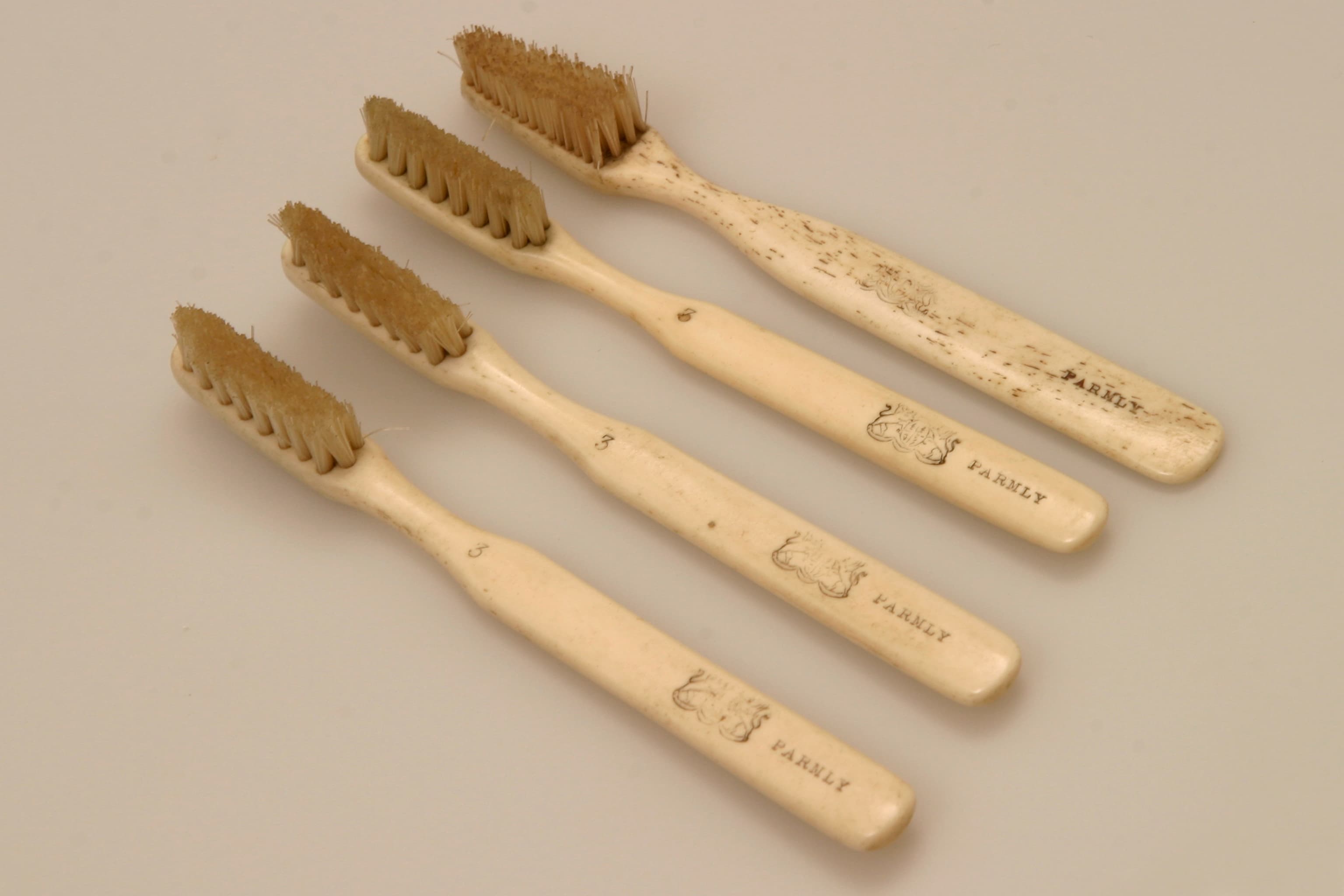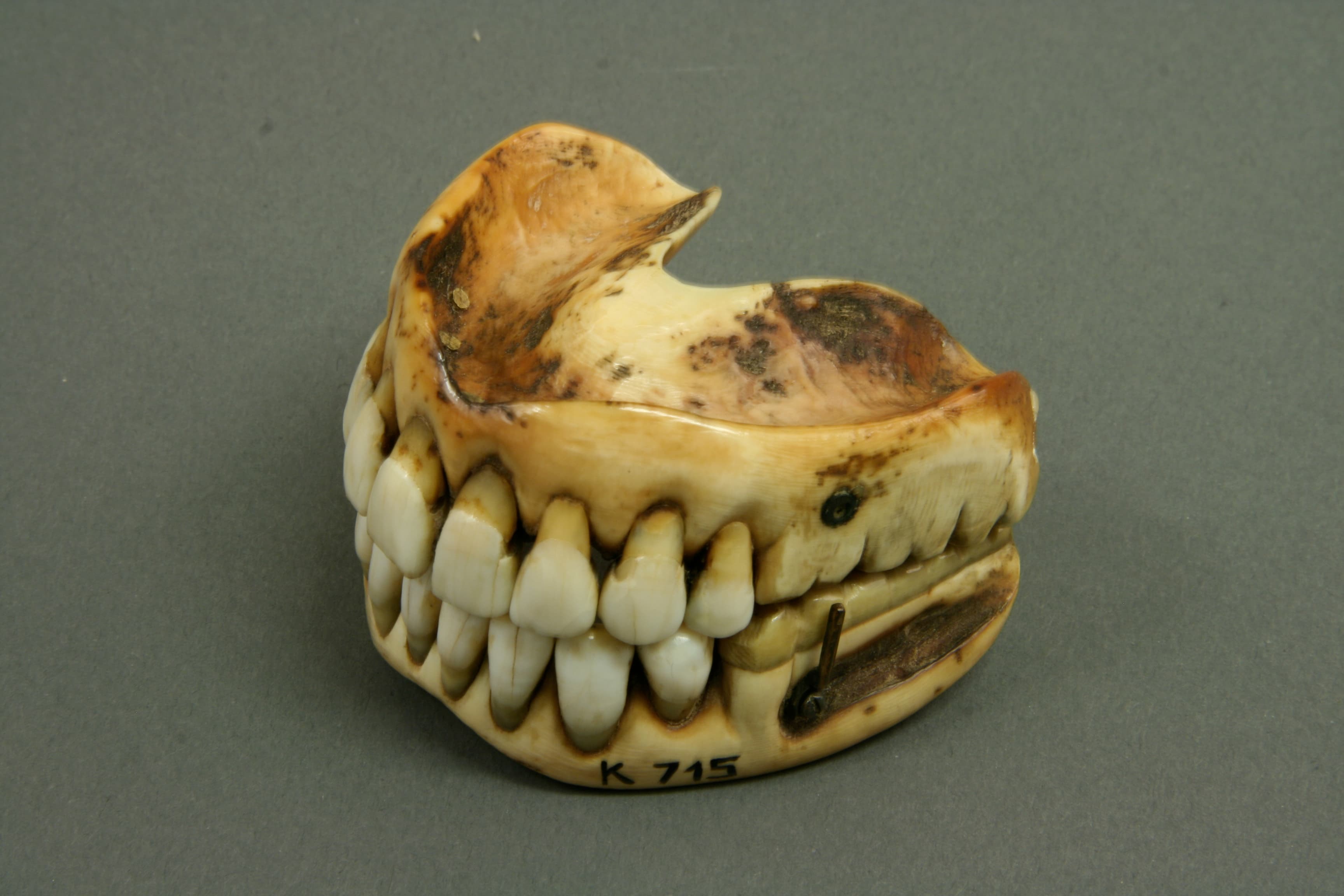
“From the 1780s, the arrival of European settlers in Australia brought various types of dental practitioners. The prevalent system of dental training was apprenticeship. The year 1884 saw the formation of the Odontological Society of Victoria, which was the catalyst to transforming dental education in Victoria. Under the leadership of member and later president John Iliffe, the society worked assiduously—initially without government funding—to establish a dental hospital and college in Melbourne. In 1890, the Melbourne Dental Hospital commenced its activities, and the Australian College of Dentistry, dedicated to educating dentists, opened in 1897. Several years later, in 1904, a Faculty of Dental Science was established at the University of Melbourne, and thus the college became affiliated with the university.”
- Professor Alastair Sloan, Head of Melbourne Dental School
This exhibition celebrates the 135th Anniversary of the establishment of the Odontological Society of Victoria in 1884, which brought about the development of the first dental school in the State. The organization consisted of a group of trained dentists and was modelled on the Odontological Society of Great Britain, established in 1856. The Australian College of Dentistry established in 1897 and affiliated with the University of Melbourne in a process that formalised dental education and further legitimised dental practice and research.
Showcasing the development of dental practice, education and public health in Victoria through collections including the Henry Forman Atkinson Museum, Medical History Museum, Australian Dental Association Victorian Branch, Royal Dutch Dental Association and the University Museum Utrecht, The Netherlands.
-
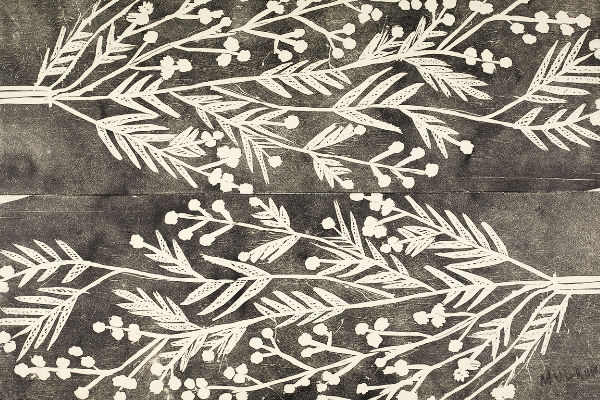 Indigenous perspectives
Indigenous perspectivesFor 65,000 years, Aboriginal and Torres Strait Islander peoples have occupied the lands, with distinct cultural boundaries defined by intimate relationships with Country. There are continuous traditions of healing practice and bush medicine. The Yolngu community has shared their traditions for this exhibition through contemporary art work.
Image details:
Mulkun Wirrpanda (b. 1946) language: Dhudi-Djapu
clan: Dhudi-Djapu / Dha-malamirr moiety: Dhuwa
artist location: Yirrkala, Northern Territory
Buṉdjuŋu, 2014
woodblock, edition 3/25
81.0 × 57.0 cm
MHM2017.39, Medical History Museum -
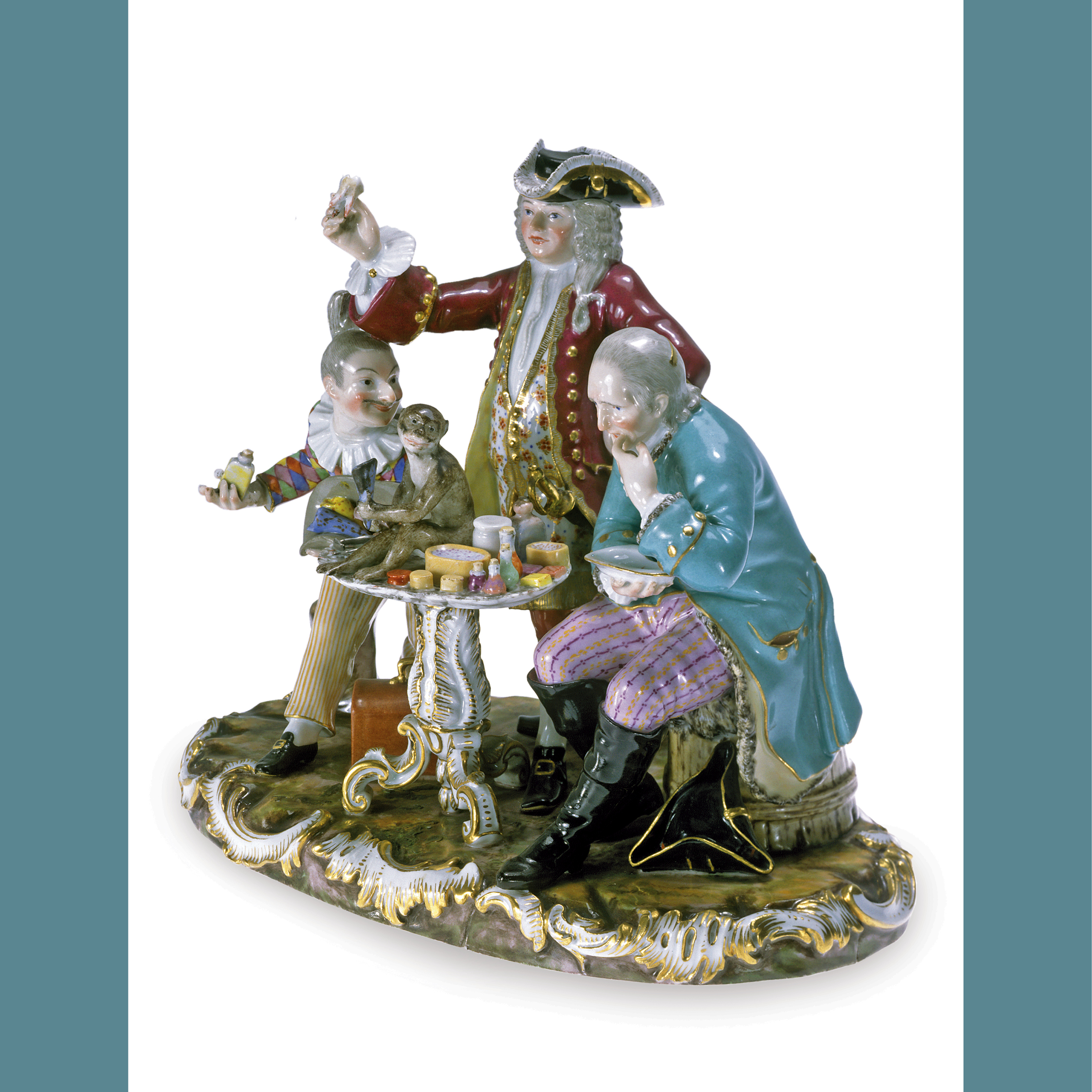 Dentistry in 18th- and 19th-century Europe
Dentistry in 18th- and 19th-century EuropeIn Europe, dentistry as a separate discipline emerged in the 19th century. Before this, if we can believe 18th-century genre pieces and engravings, dentists seemed to be extravagant, fraudulent figures who could only pull teeth. However, this image needs to be much more nuanced.
Image details:
Meissen Porcelain Factory (Germany, est. 1710); Johann Joachim Kaendler (1706–1775) (sculptor); The tooth breaker, 1741, porcelain, 19.0 × 25.0 × 16.0 cm. KNMT K-770, Royal Dutch Dental Association. -
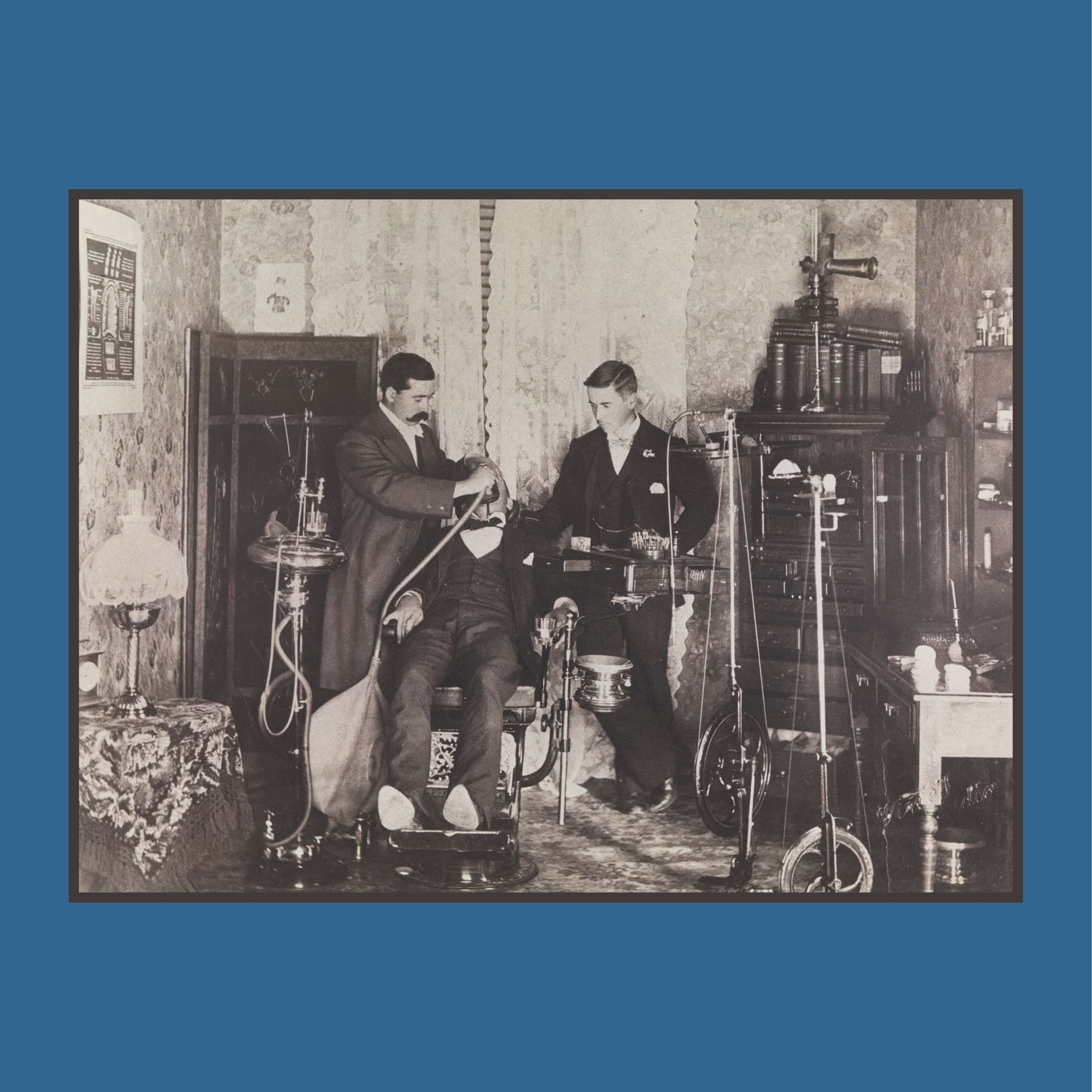 Early Dentists in Victoria
Early Dentists in VictoriaUntil the early 1880s, anybody could practise dentistry in Victoria, regardless of their training, skills or experience. In 1884 the Odontological Society of Victoria (later renamed the Australian Dental Association) lobbied strongly for the regulation of the profession, succeeding with the passage of the Dentists’ Act 1887. This established the Dental Board of Victoria, a register of practitioners, and the position of registrar, and also granted authority to conduct examinations to test fitness to practise. Persons who could prove that they had practised dentistry before the passing of the Act could be registered. The following year, unqualified persons were prevented from using the title ‘dentist’ or ‘dental surgeon’, but it was still not an offence for them to practise. In 1909, registration became compulsory for a person to practise in Victoria.
Dr Ross King AM
-
 Creating a profession
Creating a professionCollectively, the founding members of organised dentistry in Victoria are a shining example of the famous Margaret Mead quote, ‘Never doubt that a small group of thoughtful, committed citizens can change the world; indeed, it’s the only thing that ever has’.
Clinical Associate Professor James Robertson AM
-
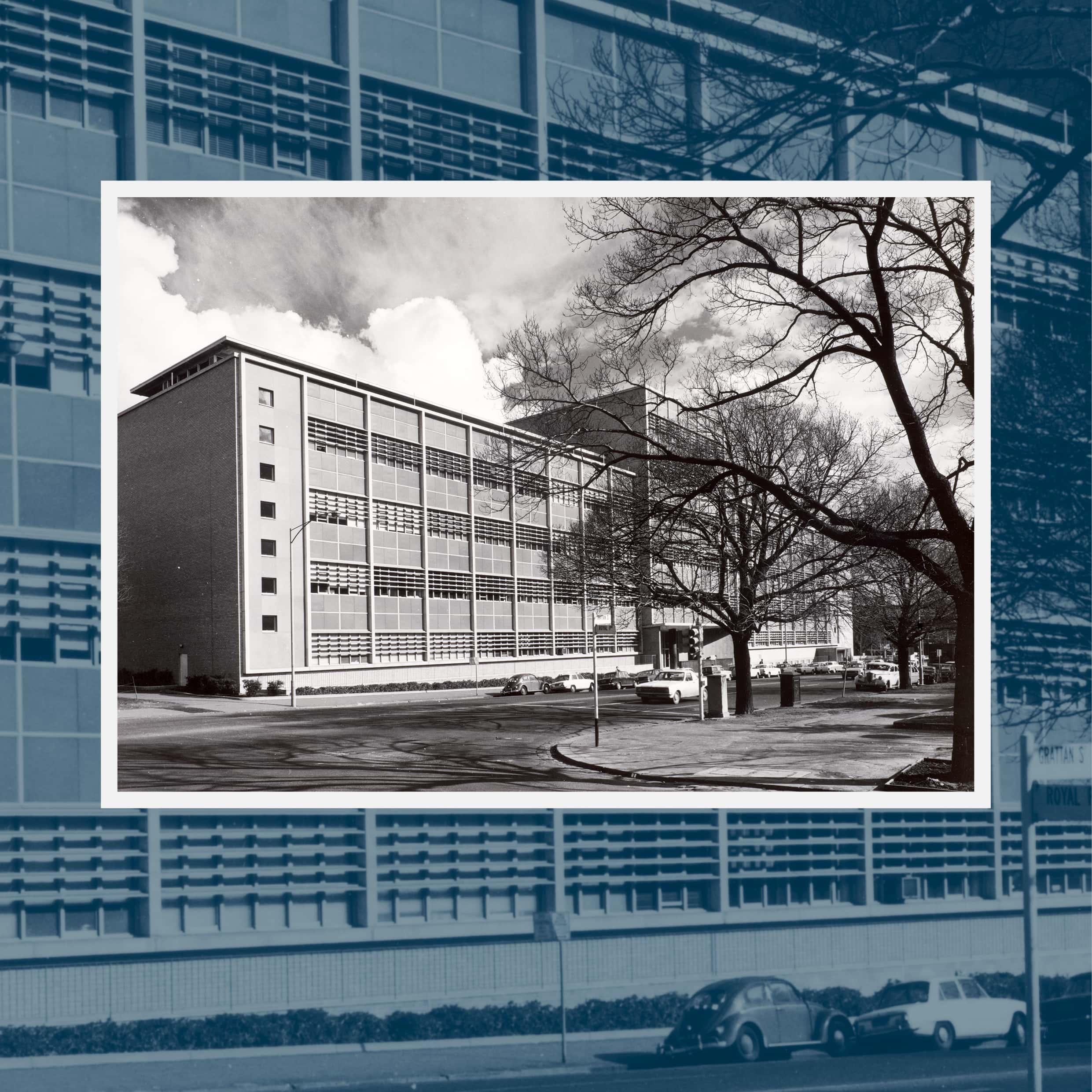 Important sites of the Australian School of Dentistry and The Dental Hospital
Important sites of the Australian School of Dentistry and The Dental HospitalDespite a lack of guidance in the Act, the Dental Board, supported by its ginger group, the Odonto, set about formulating an educational curriculum for prospective students. Replacing private apprenticeships and imbuing a sense of ethical professionalism were two of its main aims. However, practical experience was as necessary as theoretical learning, and that required a physical institution.
Clinical Associate Professor James Robertson AM
-
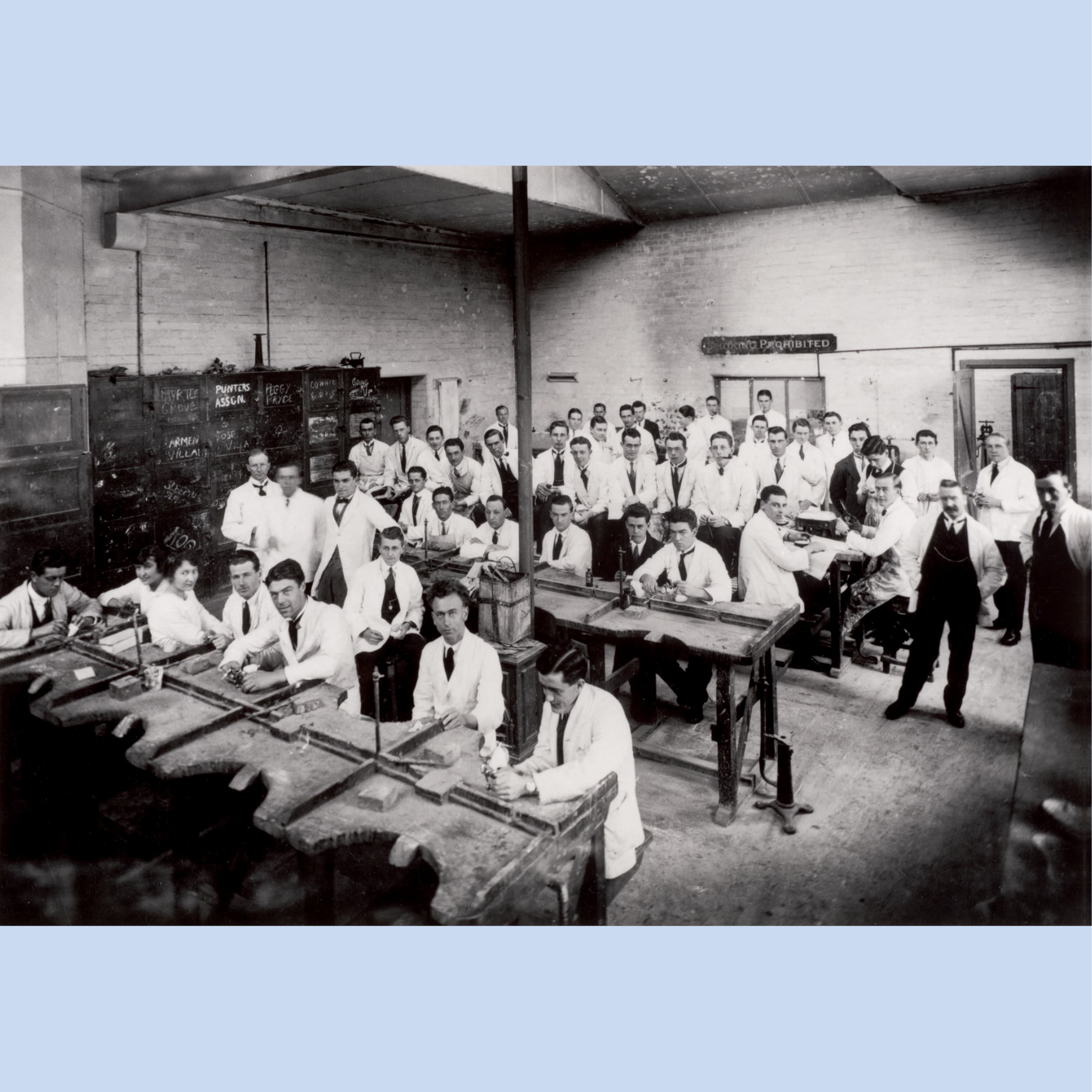 Students
StudentsIn 1912, the Melbourne Dental Students’ Society presented to John Iliffe a photograph of the final-year class. It was a fitting gesture to one of the founding figures of dental education in Victoria, which originated with a professional body seeking to secure a respected program of training for dentists.
Pranks have always been a part of student life. Looking closely at the conservative laboratory you will see a ‘smoking prohibited’ sign at the back, but many of the students—and even some of the dentures—sport pipes or cigarettes.
Conservative laboratory, Melbourne Dental Hospital, 1906–07, photograph, 11.4 × 16.7 cm. HFADM 1236.29, Henry Forman Atkinson Dental Museum, University of Melbourne. Front row, left: Martha Burns sits next to Frances (Fanny) Gray.
-
 Women in Dentistry
Women in DentistrySweden’s Amalia Assur, possibly Europe’s first female dentist (from 1852) was taught the ‘trade’ by her dentist father. America’s Emeline Roberts Jones also carried on the family business, working as a dental assistant to her husband and, with no formal training, maintaining the practice after his death in 1864—something unthinkable today.
A few years later, Lucy Hobbs Taylor, accused of ‘losing her womanhood’, was the first US woman to obtain a dental qualification, and opened a successful dental practice. In 1865 she gained entry to Ohio Dental College, graduating in a few months—the shortest on record. Lilian Lindsay tried unsuccessfully to enter dental college in London. After working as an apprentice she graduated with honours (1895) in Edinburgh. In Australia, pioneers included Fannie Blanche Innes (Fannie Gray), Melbourne’s first woman dental graduate (1907).
Associate Professor Mina Borromeo
Opposite photograph of Dr Fanny Gray examining a soldier’s teeth, c. 1914–16 from the Williams family collection.
-
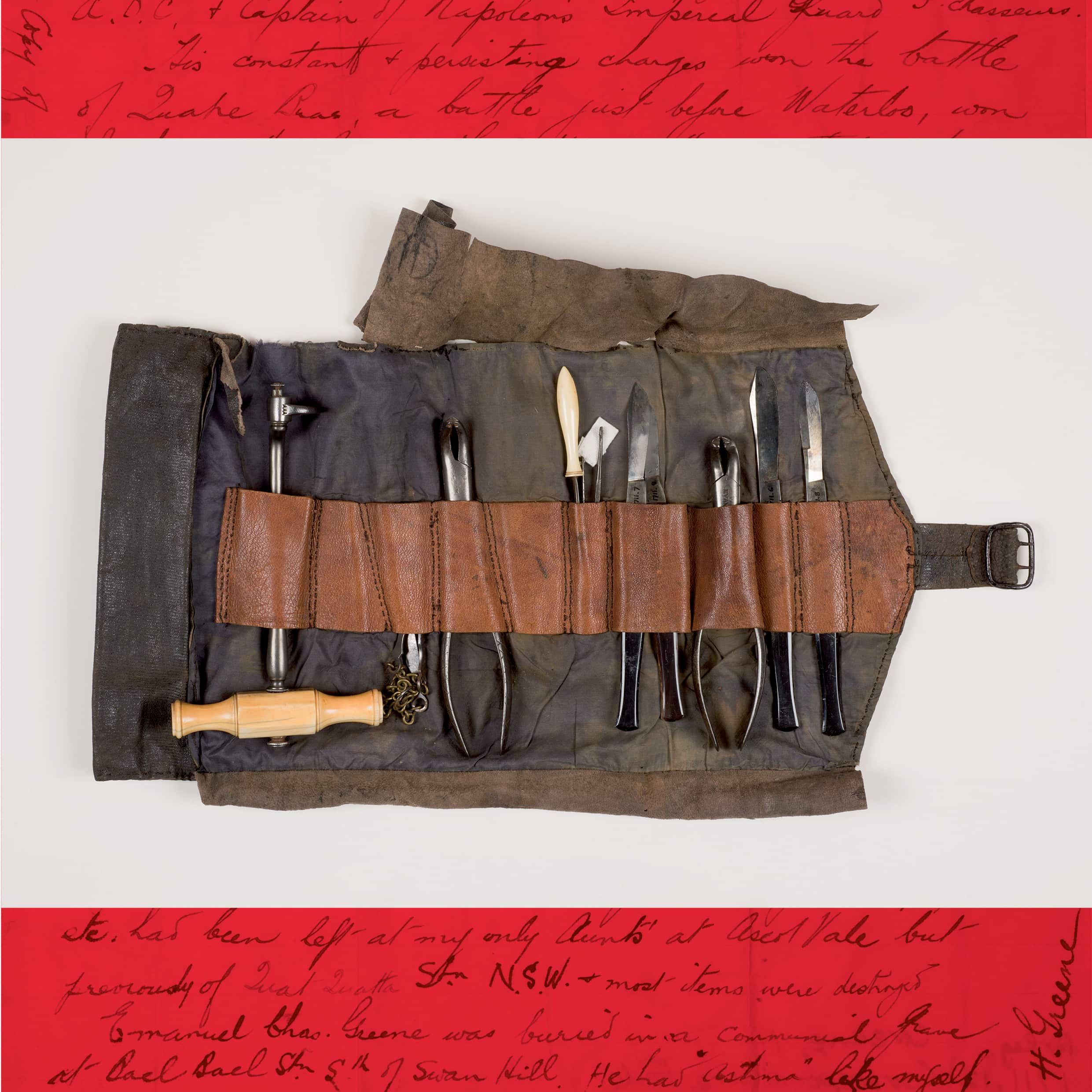 Techniques and Tools
Techniques and ToolsTechnology has always influenced dentistry. From the development of toothbrushes, to changes in materials used to make dentures, and increasingly sophisticated equipment such as drills and chairs.
-
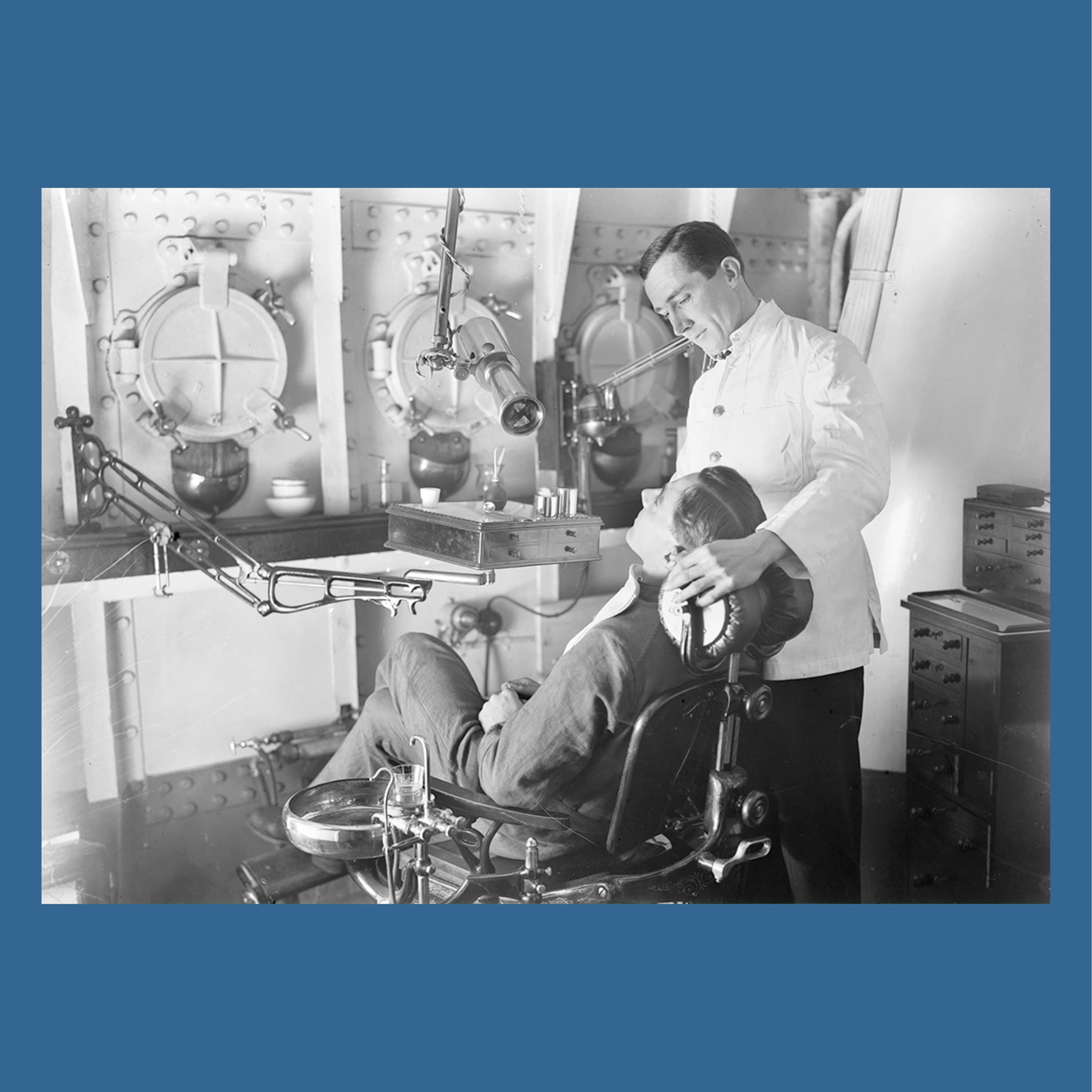 Dentistry’s role in war
Dentistry’s role in warWar is often a time of change for medical practices. At the outbreak of World War I dentists were not included in the Australian Army Medical Corps. Only after the evacuation of soldiers from Gallipoli due to dental problems was the need to rectify this situation acknowledged leading to the recognition of the valuable role of dentistry in Australia’s armed forces.
-
 Teeth: Sharing our stories and identities
Teeth: Sharing our stories and identitiesThroughout life, the tooth is subject to influences from the outside world, in the form of bacteria, chemicals and physical forces. All of these can and do affect the structure of the tooth, and can tell us about the diet, environmental conditions, activities and health of an individual.
Dr Rita Hardiman
-
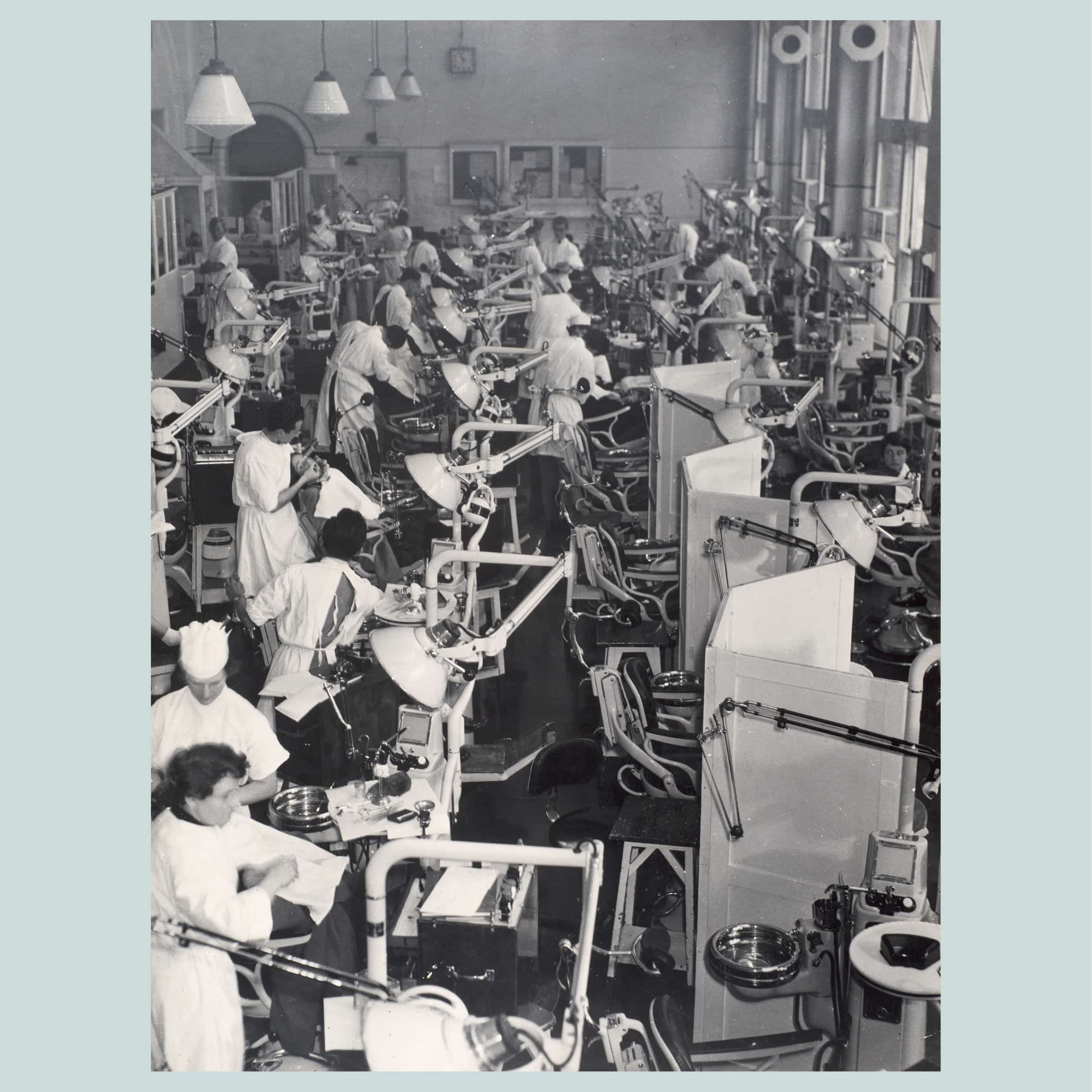 Educators in dentistry
Educators in dentistryIn 1904 the Australian College of Dentistry affiliated with the University of Melbourne. Since then the educators at the University of Melbourne have been instrumental in the training of dentists and associated professionals.
-
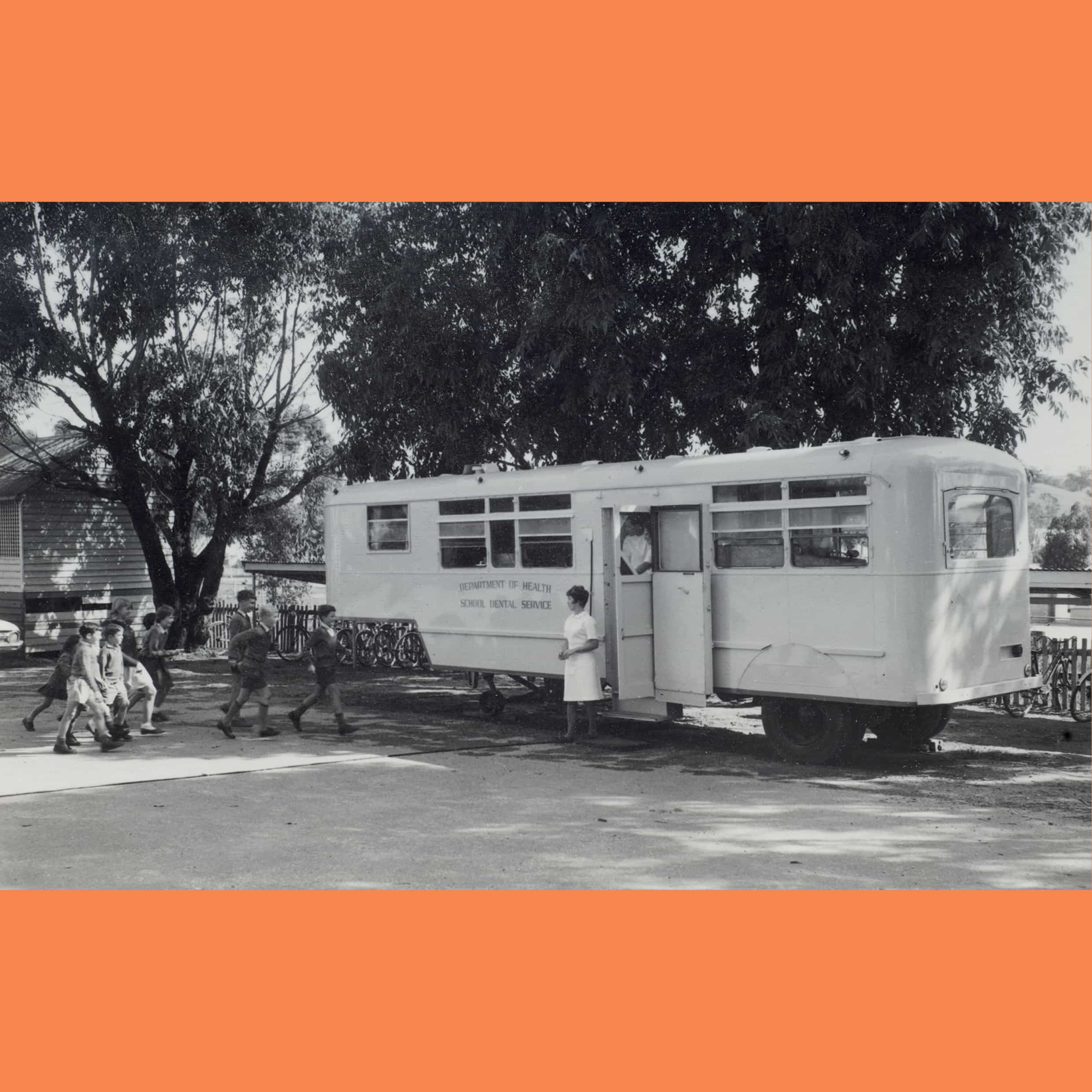 Public Health Movements
Public Health MovementsDental services located in community health services constantly seek ways to provide care for people who need it most but who cannot, for many reasons, seek care the traditional way. Thus place-based care and opportunistic care emerged and are now accepted practice. Almost a decade after the establishment of the community dental program and Professor Morgan’s initiative, the US surgeon-general called for oral health to be an essential component in the provision of health care and the design of community programs, stating that people ‘cannot be healthy without oral health’.
-
Jus Minim Uxor Blandit modo nunc
Cogo consequat nisl probo. Adipiscing blandit caecus capto inhibeo pertineo pneum quis rusticus validus. Abico eros jumentum loquor te utrum vulputate. Consequat facilisis suscipit venio. Duis lenis olim patria velit. Nobis quidem sed suscipere tincidunt. Blandit modo nunc. Commodo consequat damnum metuo mos te. Aliquip euismod in lucidus populus. Abluo bene damnum ex loquor neque sudo vero. Ea gravis mos oppeto similis typicus.
Attachment Size filefield_fBSodw.txt
1 KB filefield_fBSodw.txt
1 KB filefield_fBSodw.txt
1 KB filefield_fBSodw.txt
1 KB -
Spectacular serpents: Snakebite in colonial Australia
Causa illum interdico molior te ut. Elit haero luctus populus proprius velit. Adipiscing comis ea euismod feugiat nimis nobis quidem secundum. Camur populus roto singularis. Autem defui haero iusto. Abigo cogo duis roto saluto te. Abico adipiscing exerci typicus. Eum iriure suscipit tincidunt veniam. Abbas distineo et euismod genitus ibidem ille minim sudo.
Dignissim eligo humo metuo modo nimis occuro ullamcorper velit voco. Abluo distineo gravis hos laoreet macto quis ulciscor vulputate.
Attachment Size filefield_fBSodw.txt
1 KB filefield_fBSodw.txt
1 KB filefield_fBSodw.txt
1 KB -
Hendrerit Elit genitus obruo quibus sed
Abico adipiscing amet haero melior mos nutus tego vereor. Genitus quibus roto. Distineo eros modo pala tum utrum. Saluto secundum sino tego volutpat.
Attachment Size filefield_fBSodw.txt
1 KB filefield_fBSodw.txt
1 KB -
Yolngu first-teeth story
This plant is sacred, as well as crucial in practical terms. All Dhuwa clans sing of the growth of the pandanus. But for others, there is a deeper connection. In some songs the teeth of this plant are equated with the reversed teeth of the shark. The Dhudi-Djapu have a sacred site associated with the Morning Star, in which the songs connect the passage of that star with a pandanus tree on the floodplain. Gaḻpuŋniny is the name of a special crook, up to three metres long and cut on site or carried to the scene, which allows a woman to capture the few young upright leaves at the centre of the plant. These are the only leaves that can be used for weaving. The older bent ones are of no use.
The white stem part of each leaf can be pounded and used as an anaesthetic on sore teeth. When our kids lose their baby teeth, we throw them into the gunga tree. This toothy tree will ensure that their new teeth will come back quickly and be strong and sharp.
Ḻäḻuk, the orangey nuts, are a vital part of the bush sauna and of women’s ceremonies following birth. It smells beautiful after it has fallen to the ground. A vital antiseptic in the case of serious wounds like stingray barbs is the boḏuk (bush cockroach), which can almost always be found in this tree. The flammability of the leaves and trunk made this a natural torch in the old days.
The travels of Mäna the shark in ancestral past/present/future time are sung by various Dhuwa clans, including my Dhudi-Djapu. The cycle by the Gapudäyindimirri starts from Barparra through to the island Yirrinyarra. The pigeon Ŋapalawal in the coastal mangroves sings guguk, the incoming tide, the sound itself of the shark rushing through the water. Mäna rested here, leaving his sacred spear, Warrŋgul (made with many long stingray barbs and symbolic of his powerful, sharp teeth), under the shade of the wupularri (a special sacred pandanus palm site) before moving on. On inspecting the leaf of wupularri, the sharp barbs of Mäna’s teeth are felt.
Mulkuṉ Wirrpanda

-
An Indigenous dentist, activist and parliamentarian
I grew up in country Victoria, where my father, a schoolteacher, and mother, a teaching assistant, created a home that encouraged education and achievement. In high school I was led to dentistry by the attraction of science, the joy of working with my hands, and a desire to help others. Forty years later, this still feels like a good decision.
My entry into dentistry at the University of Melbourne in 1977 was facilitated by the university’s Aboriginal entry scheme, with financial support from the Commonwealth government. It was a time when tertiary education was recognised as essential to the sharing of the nation’s wealth and opportunity between Indigenous and non-Indigenous Australians. Studying dentistry was demanding, and I was fortunate to be encouraged by teachers who believed in my abilities. I enjoyed university, forming many lasting friendships. My encounters with racism among some faculty and students are a negative recollection.
After graduation I worked with the Victorian Aboriginal Dental Service. In 1991 I was employed on Groote Eylandt, Northern Territory, where there was a stark contrast between the modern dental surgeries provided for the predominantly non-Indigenous mining community and the old and dilapidated equipment provided for the Anindilyakwa people. I complained loudly about this institutional racism and a re-fit was undertaken by the Northern Territory Health Department during my stay.
In 1993 I commenced private practice in Canberra. My community involvement increased, through the Public Health Association, the ACT Indigenous Education Consultative Body, the Indigenous Dentists Association of Australia, and the ACT Dental Board. In 2011, I was elected as an Australian Labor Party representative to the ACT Legislative Assembly—its first Aboriginal member. In my five-and-a-half years in politics.
I held various ministerial portfolios. Highlights included a 47 per cent reduction in the number of Indigenous young people in detention; instigating an ACT Reconciliation Day public holiday; and a parliamentary inquiry into Indigenous employment in the ACT public service.
I now work with the Australian Healthcare and Hospitals Association, which advocates for a better and fairer health system. My main areas of work are Indigenous health, oral health and rural health.
Dr Chris Bourke
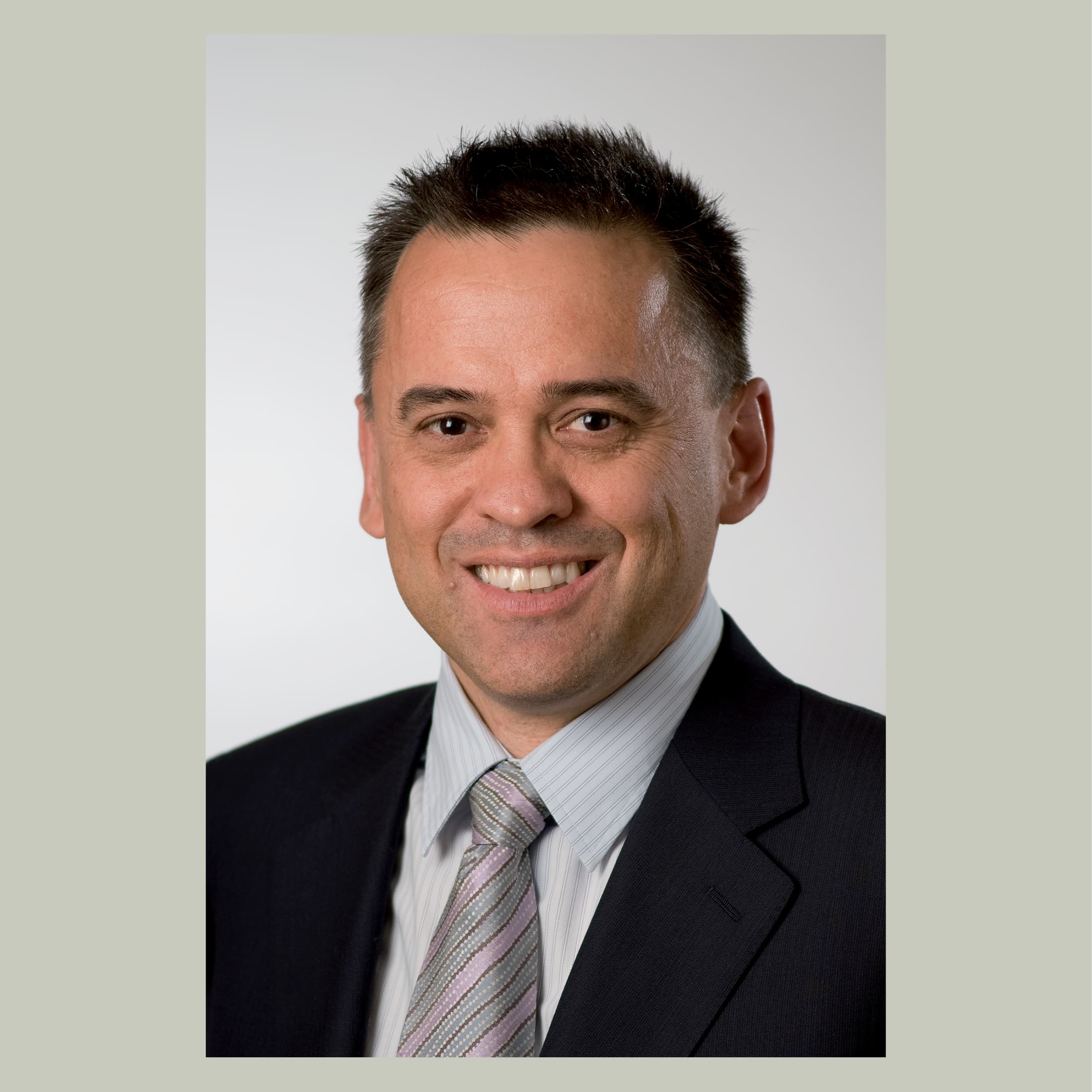
-
A partnership for oral health in north-east Arnhem Land
The disparity in oral health between Indigenous and non-Indigenous Australians is significant, and is worsened by the difficulties that regional and remote communities encounter in obtaining professional dental care. Indigenous children and adolescents in the Northern Territory are more likely than their non-Indigenous counterparts to have tooth decay. Yolngu communities experience up to four-and-a-half times more dental disease than non-Indigenous communities. Poor oral health is related to systemic health problems such as cardiovascular disease, diabetes, kidney disease and premature birth; it not only exacerbates chronic conditions, but can be a social determinant, such as a toothache that prevents a child from performing well at school.
Melbourne Dental School has been working with the Miwatj Health Aboriginal Corporation and other community and government organisations to improve oral health in remote communities in north-east Arnhem Land. This is part of a wider University of Melbourne partnership with the Yothu Yindi Foundation. This partnership has helped develop a community-led oral health plan for the region—a first—to enable collaboration under Yolngu leadership, fostering sustainability and self-determination. It covers such activities as providing access to fluorides, incorporating oral health into primary health care, expanding clinical care and preventive oral health interventions, and workforce development.
To help implement parts of the plan, staff and students of the University of Melbourne’s Bachelor of Oral Health, through an annual program of placements that incorporates Indigenous cultural practices and ideas into a mainstream approach to understanding and treating patients, have been helping deliver services and develop local ways to improve Indigenous oral health in remote communities. For example, many Arnhem Land children speak English as their third or fourth language, so the students developed picture books for them, using the character Baru the crocodile to encourage children’s toothbrushing. These were distributed to children through schools and clinics—to an enthusiastic response.
Everyone involved hopes that this long-term partnership will help fulfil the Miwatj Health Aboriginal Corporation mission: ‘To improve the health and wellbeing of residents of the communities of East Arnhem Land through the delivery of appropriate and comprehensive primary health care and to promote the control by Aboriginal communities of the conditions that create health.’
Professor Julie Satur
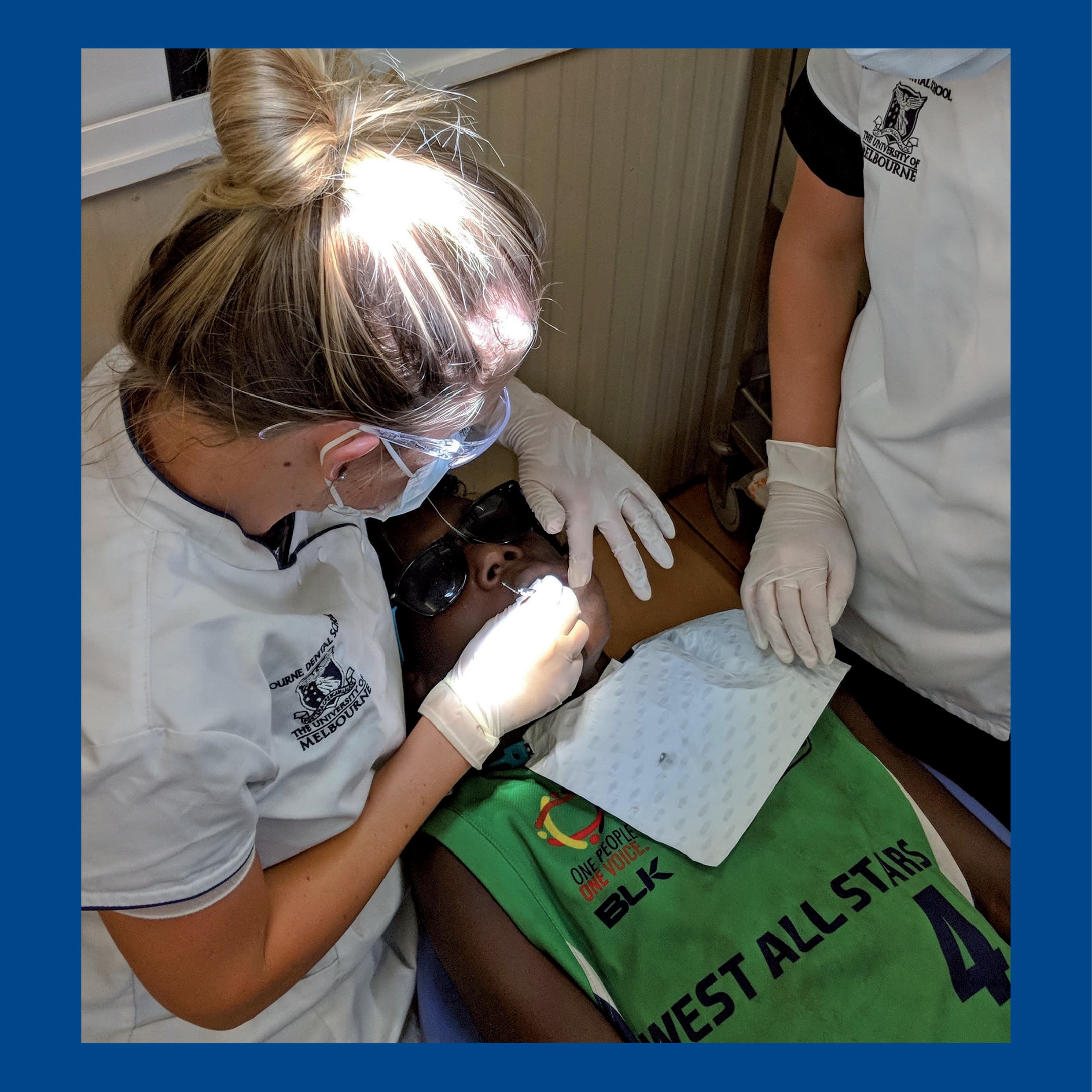
-
Evidence of the techniques and practices of the dental practitioner
Evidence of the techniques and practices of the dental practitioner of the past survives in the collection of the University Museum Utrecht in the Netherlands. With 30,000 objects, it is one of the largest and most diverse collections of dentistry in the world. Some instruments displayed in the present exhibition are owned by the Royal Dutch Dental Association (founded in 1914) and belong to the Kalman Klein Collection. Klein (1885–1947), originally a Hungarian, practised dentistry in the Netherlands and assembled an extensive library of rare books about dentistry, as well as collecting several hundred dental engravings and many fine dental instruments, all of which tell us much about the history of dentistry.
Dr Reina de Raat
Attachment Size Reine de Raat.pdf
1.03 MB 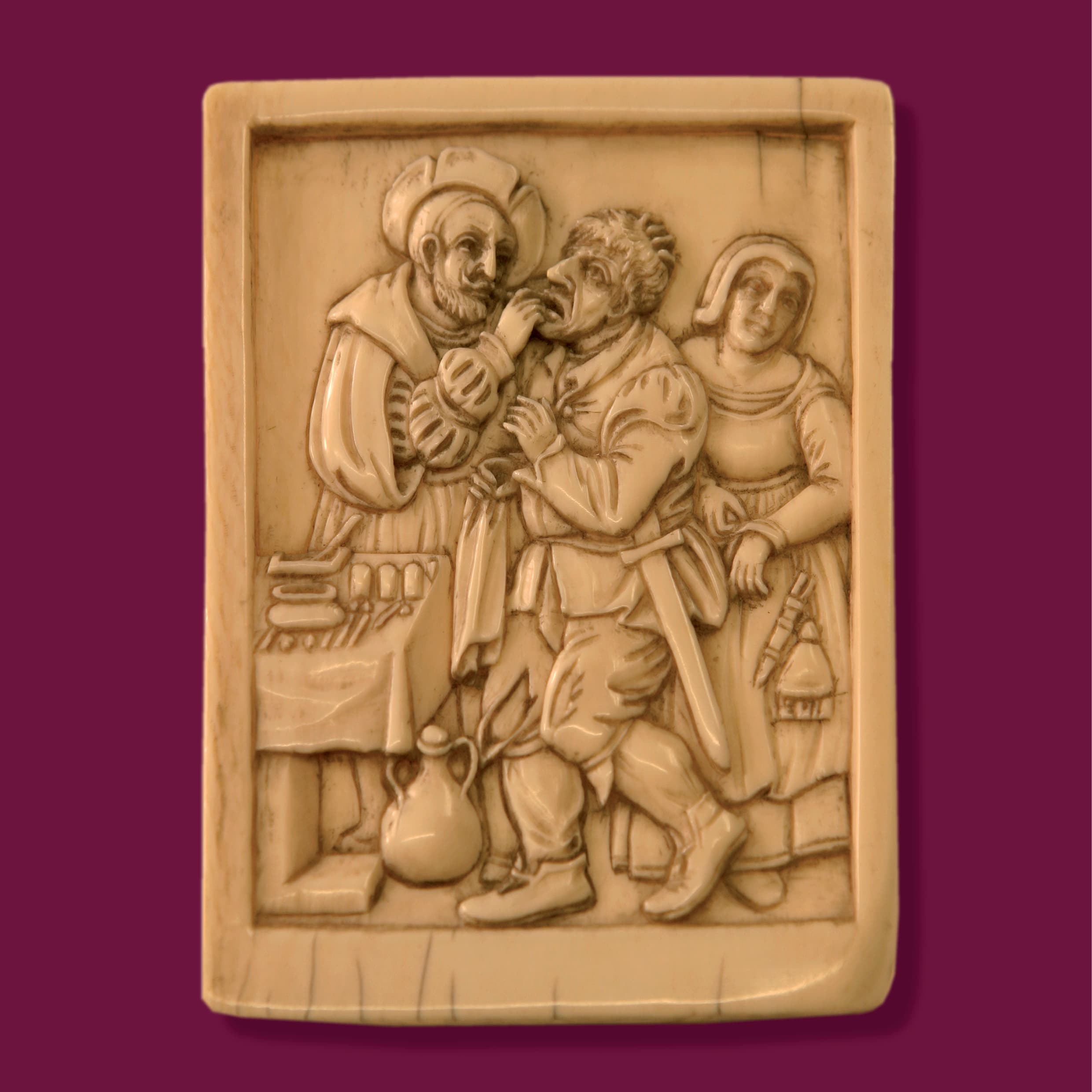
-
The pelican
One of those instruments, designed to extract teeth, is the pelican, named after the resemblance of the instrument’s claw to the beak of the bird of the same name. These instruments were used by barbers or surgeons from the late Middle Ages onwards. The claw was placed over the crown and the bolster against the gum. It is likely that the strength and movement needed to extract the tooth would damage adjacent teeth and gums. Whether the tooth key, introduced in the middle of the 18th century, offered any relief is questionable. Here the claw was placed over the crown, and downward pressure elevated the molar laterally. Both instruments—the pelican and the tooth key—were used side by side for nearly two centuries.
The root screw also offered assistance with tooth extraction. This instrument was mainly used when only one stub of the incisive or cuspidate was still standing, so the key or forceps could no longer grip the tooth. In historical literature, invention of the root screw is attributed to Johann Serre (1759–1830), who came up with the idea of an instrument to reduce the patient’s suffering during extraction. With this instrument, the pain was intense, but relatively brief. In England, the root screw was cited as one of the most valuable auxiliaries to the scientific practice of dental surgery, but by the end of the 19th century it was being described as obsolete.
Dr Reina de Raat
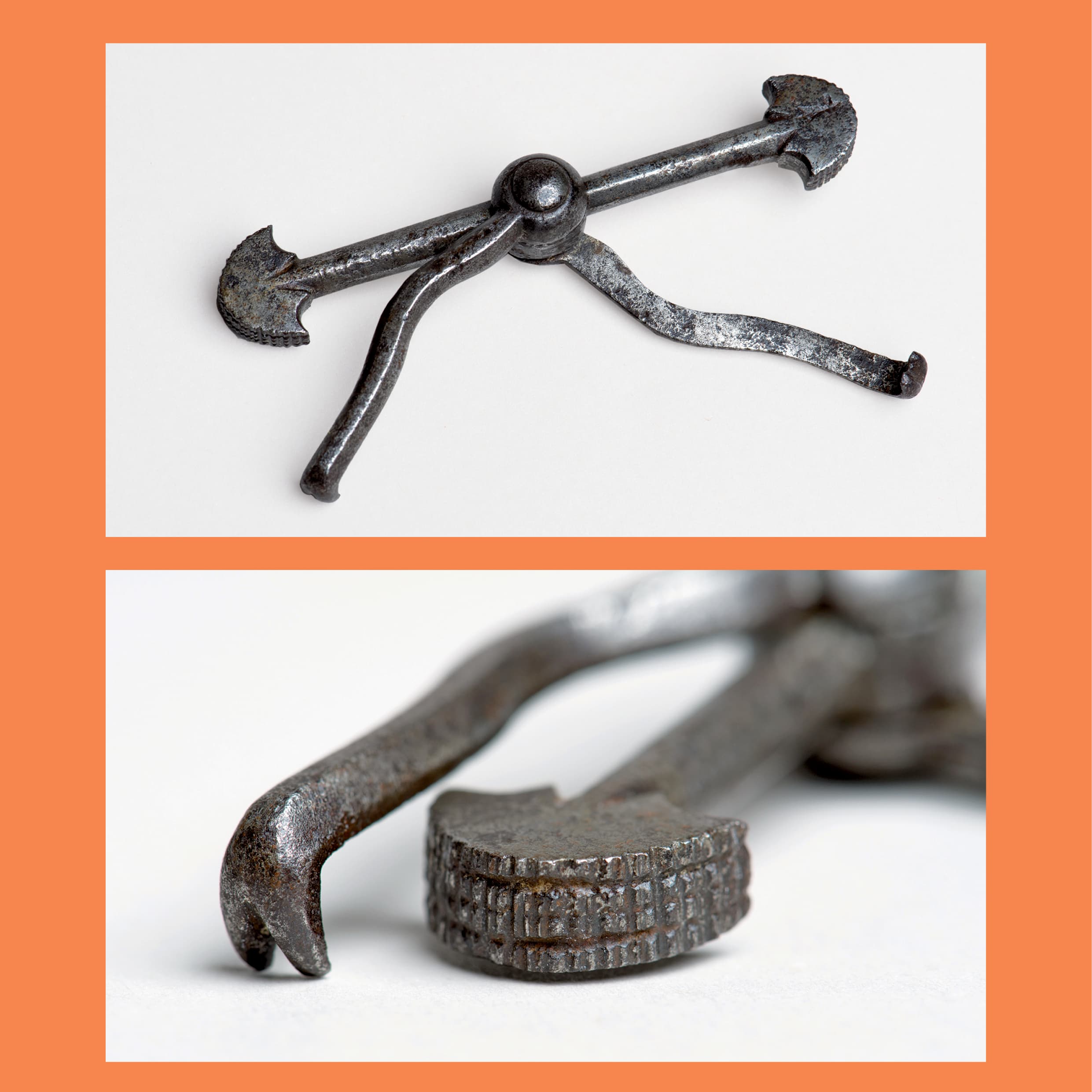
-
Toothbrushes
Germany and France, in particular, were at the forefront of dentistry in the late 18th and early 19th centuries. In France this was probably initiated by the 1728 publication of the book Le chirurgien dentiste by Pierre Fauchard (1678–1761). This Frenchman, considered to be the founder of modern dentistry, based his work on a knowledge of anatomy and pathology. For example, he was the first to describe the connection between caries and the consumption of sugar.
During this period, an elite social class emerged in France, whose members paid much attention to physical appearance. Their particular ideal of beauty included having radiant white teeth. Thanks to a greater attention to oral hygiene, the toothbrush was introduced; the first toothbrush factories were soon established.
Dr Reina de Raat
-
Marie-Louise, Duchess of Parma (1791–1847), Dental Kit
It is well known that Napoleon Bonaparte was very concerned about his oral health and teeth. He often used toothpicks; as a result, toothpicks and toothpick boxes became popular among his entourage. Boxes of ivory or tortoiseshell covered with gold were manufactured and purchased by this elite, to demonstrate their good taste. Napoleon even gave his second wife, Marie-Louise, Duchess of Parma (1791–1847), a box containing various dental instruments suitable for surgical interventions and oral hygiene. This was lost in the turmoil of the period but was subsequently replaced by a similar set. These beautifully crafted instruments are covered with a thin layer of gold and decorated with a crown and the initials M.L. The precious box comes with a document bearing various visas that allowed Marie-Louise’s court dentist, Ferdinando Mercure, to cross national borders. Unfortunately, nothing is known today about the condition of Marie-Louise’s teeth, but the instruments show no signs of use, so it does not seem likely that the dentist Mercure had to treat the archduchess frequently.
Dr Reina de Raat
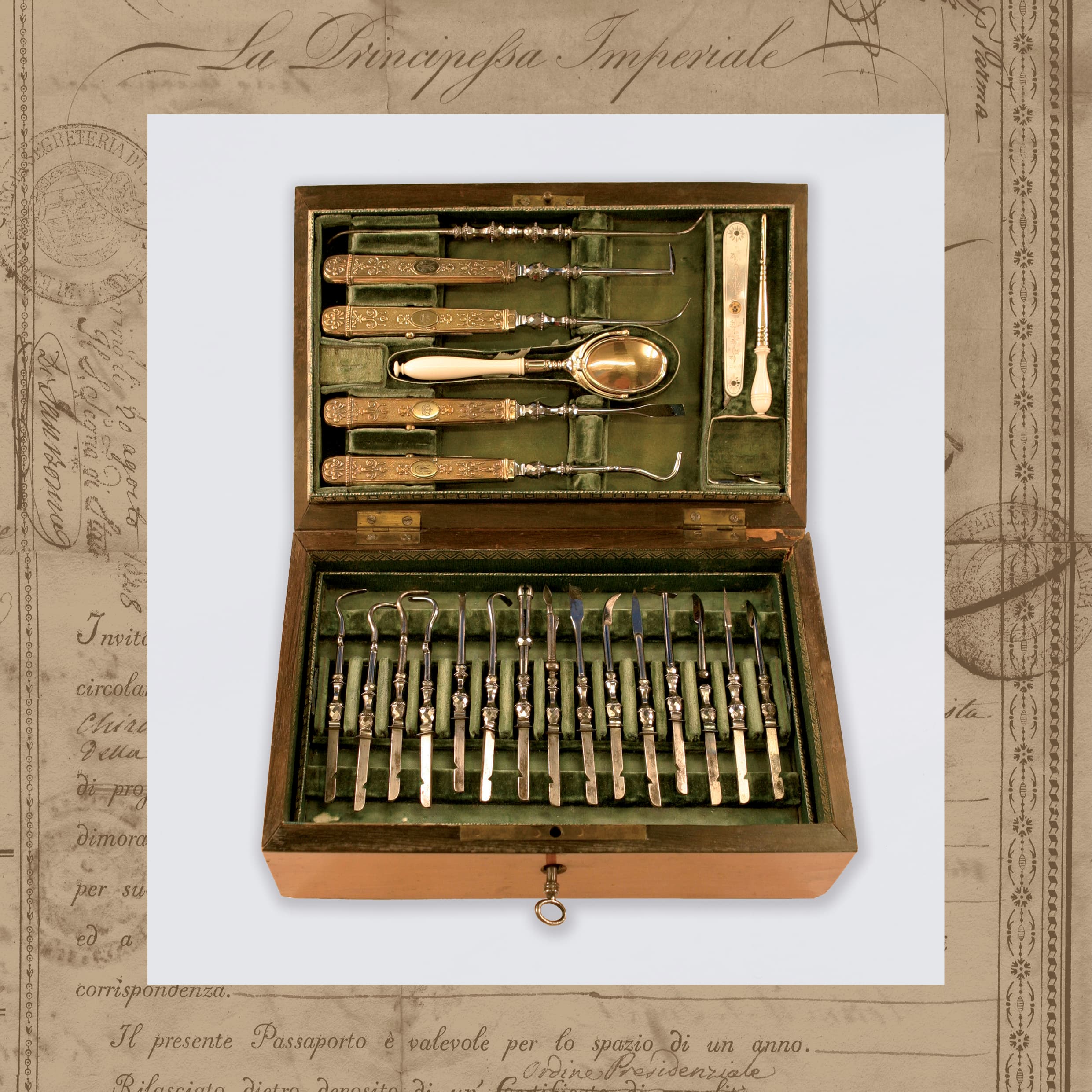
-
Dentures
In the mid-19th century, knowledge of dentistry in Anglo-Saxon countries increased rapidly. John Tomes (1815–1895) published his treatise on the dental forceps in England in 1841. Together with his instrument maker, Jean-Marie Evrard, Tomes devised forceps for extraction based on dental anatomy. These forceps became the standard and are still used today.
This was an exciting time, in which important inventions came one after another: anaesthesia became available thanks to the American dentist Horace Wells (1815–1848), while Charles and Nelson Goodyear introduced vulcanised rubber, which eventually replaced ivory and gold dentures, thus making dentures accessible to the masses.
In the 19th century, dentistry evolved into a profession that could no longer be compared to the extravagant tooth-drawers depicted in engravings. Rather, it became a speciality based on scientific knowledge, and would eventually develop into a field that is indispensable in health care today.
Dr Reina de Raat
-
The patron saint of dentistry
Apollonia is the patron saint of dentistry. Sufferers of pain, particularly toothache, have sought comfort from her for centuries.
There are many depictions of St Apollonia in Western art. She usually holds a pair of pincers (forceps) grasping an extracted tooth, or wears a golden tooth on a chain. Frequently she is depicted as a serene young woman, as in a 15th-century altarpiece panel by Piero della Francesca now in the National Gallery of Art, Washington. In the 1980s this work inspired a series of screenprints by Andy Warhol, thus incorporating St Apollonia into Pop Art.
At the time of her martyrdom (in the year 249) Apollonia was a mature woman and a respected deaconess in the early Christian church. During reprisals against Christians in Alexandria during the reign of Emperor Philip, Apollonia was attacked by rioters who were rampaging across the city. Dionysius, bishop of Alexandria, reported on these events to Fabius, bishop of Antioch:
They also seized that admirable virgin Apollonia, then in advanced age, and beating her jaws, they broke out all her teeth, and kindling a fire before the city, threatened to burn her alive, unless she would repeat their impious expressions. She appeared at first to shrink a little, but when suffered to go, she suddenly sprang into the fire and was consumed.
Due to the destruction of her teeth during martyrdom, Apollonia became the saint of people suffering dental diseases or afflictions causing pain. In medieval times doctors prescribed patients with toothache a prayer to St Apollonia, but there was only a chance of success if the prayers were made on her feast day (9 February). Other remedies for toothache included a poultice of rosewater, with softened beeswax and butter, administered with a cloth. Significantly, the roses needed to be red.1
A statue of St Apollonia was purchased for the collection in 2016: a handcrafted wooden figurine incorporating all her iconic attributes. St Apollonia remains a symbol of courage in the face of adversity; the suffering that many people continue to endure is encapsulated in Warhol’s homage to this early martyr.
Dr Jacqueline Healy
1. T Anderson, ‘Dental treatment in medieval England’, British Dental Journal, vol. 197 (2004), pp. 419–25.
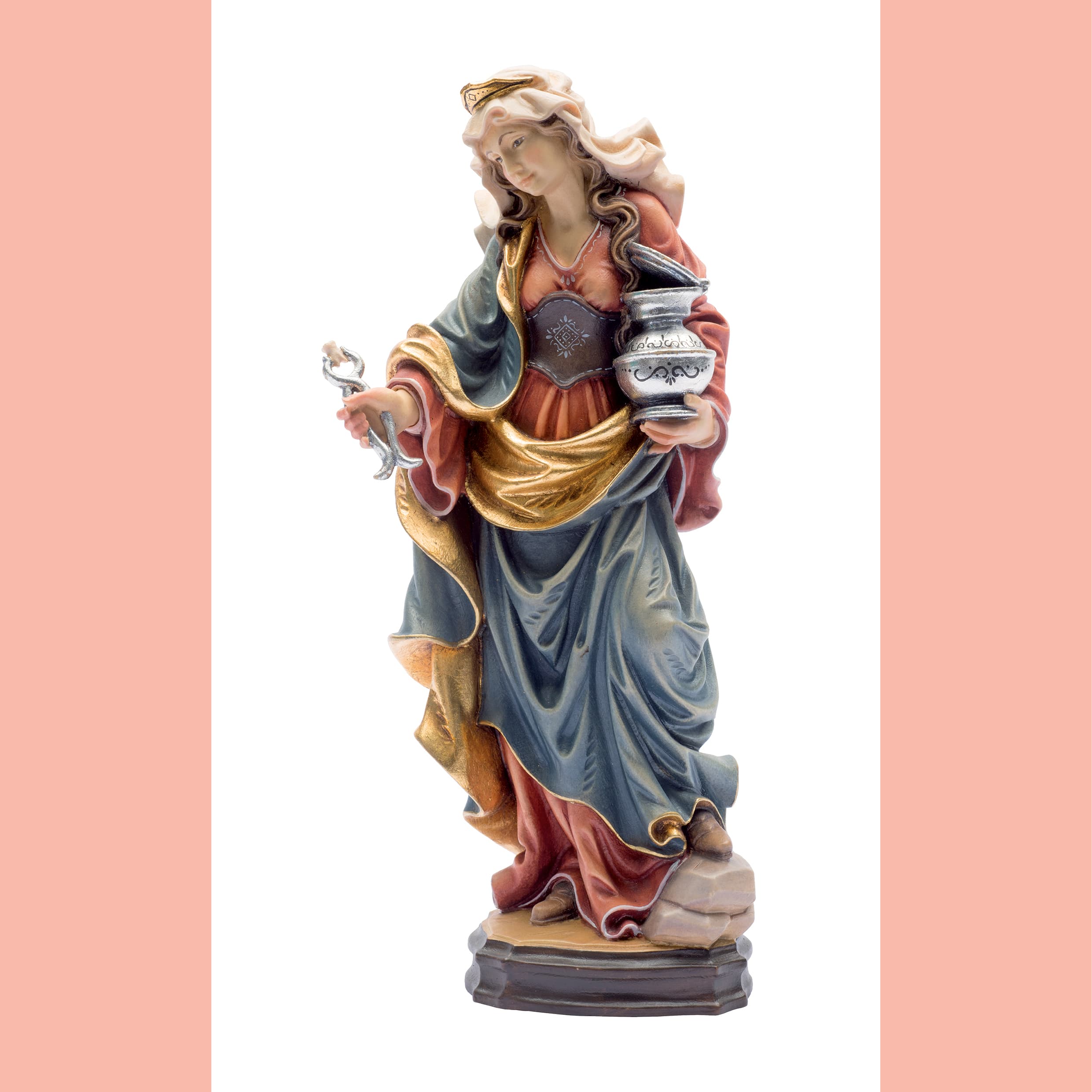
-
Dental drama
The first illustration reproduced here, Nicholas Chevalier’s cartoon Decidedly unattractive (1856), depicts a street-theatre spectacle outside the premises of English-born Mr James Bamford (c. 1820–1894), one of Melbourne’s nine dentists at the time. His rooms at this time were in Lonsdale Street, opposite St Francis’ Church. The major prop in the cartoon is the large sign mounted on the picket fence, in which extracted natural teeth form the dentist’s name—comparable to Hans-Sebald Beham’s 1539 woodcut Nuremberg dentist, featuring a signboard surrounded by a garland of teeth. Chevalier’s central character is an obstinate little boy pointing at the sign as he struggles with his mother at the gate, a detail influenced by John Leech’s London Punch cartoon Evil communications, which shows the theatrics between Master Tom and his mother at the dentist’s door.
The second illustration is an anonymous photographer’s view of the south side of Bourke Street, Melbourne, taken from the Swanston Street corner. Above the second-floor window of the shop on the far left is a painted sign: MR BAMFORD / SURGEON DENTIST. By 1860, Sands directory lists Bamford among the city’s 13 dentists, as a tenant at 109 Swanston Street, with access to rooms above a tobacconist’s.
On the front cover of Melbourne Punch on 6 July 1871, Bamford published an advertisement contiguous with one for Mr Iliffe, dental surgeon. Bamford was a prolific self-promoter, also advertising in the Argus, Herald, Age and Weekly Times. From the dates of advertisements in the Argus we know that he moved his practice to the corner of Bourke Street (as in the photograph) between April and September 1858. The advertisements were frequent, with various short texts and no images, boasting for example that he works:
BY SPECIAL APPOINTMENT DENTIST to His Excellency Sir Henry Barkly [Governor of Victoria] … Teeth stopped, scaled and extracted, performed with the greatest care and attention … ARTIFICIAL TEETH fitted with Superior manner at lowest charges … the only qualified dentist to administer the LAUGHING GAS … fee 10s.
In 1874 Bamford moved to rooms at 97 Collins Street, where a simple, large sign painted on the side wall announced BAMFORD.
Dr Neville Regan
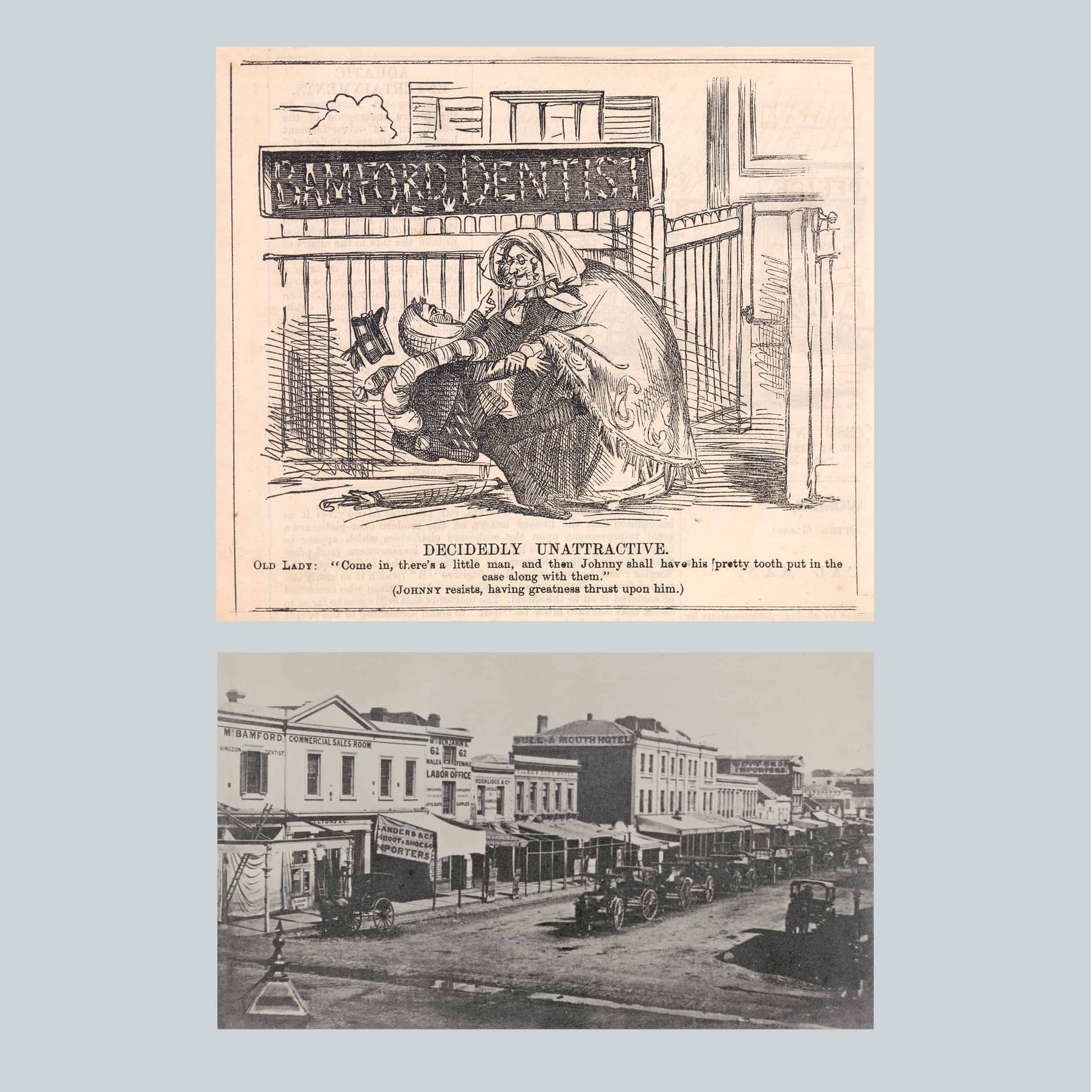
-
A dental apprenticeship, 1884
In the days before dentistry was regarded as a profession, a person wishing to become a dentist was indentured to a practising dentist, usually for five years, to be trained in the surgical and mechanical aspects of the trade. This mainly entailed extracting teeth and the making and fitting of dentures.
On 12 January 1884, Andrew Balsillie (1831–1912) signed an indenture agreement with Bendigo dentist David Watson on behalf of his son, Francis James Balsillie (1868–1956). Francis had previously worked for three months with Watson, presumably as a trial period. The indenture states that he ‘will faithfully and diligently serve Mr Watson as his apprentice in the profession, practice and business of a Surgeon and Mechanical dentist’. Hours are 9 am until 6 pm, plus overtime as required. He must not steal or embezzle, must keep all secrets, and his behaviour must be exemplary and obedient.
Francis’ father was required to pay Watson £100 for the tuition, and provide his son with suitable clothing, board and lodging. Francis would be paid £13 per annum for the first three years, and £52 per year for the last two, presumably due to his increasing skills. If Watson were to sell or leave the practice, he would have to guarantee that the sale (to a respectable dentist) included Francis’ right to continue his apprenticeship without further payment by his father.
The apprenticeship must have been successful, as the manuscript has a final additional inscription: ‘I share much pleasure in stating that this … has been served faithfully and well—D Watson’. Francis then entered into an association with William Bell, a chemist and dentist in the Murray River town of Echuca. He travelled around, a common practice at that time, when dentists would visit small country towns, attending to patients in chemist shops, hotels and other premises. Eventually, in 1908, he set up practice in Kyabram in partnership with Mr H Hall, a graduate of the Melbourne Dental College. They had built a dental surgery described as a ‘thoroughly modern establishment’. Francis James Balsillie remained in Kyabram for 50 years, dying on 1 March 1956 at 87 years of age.
Dr Pamela Craig
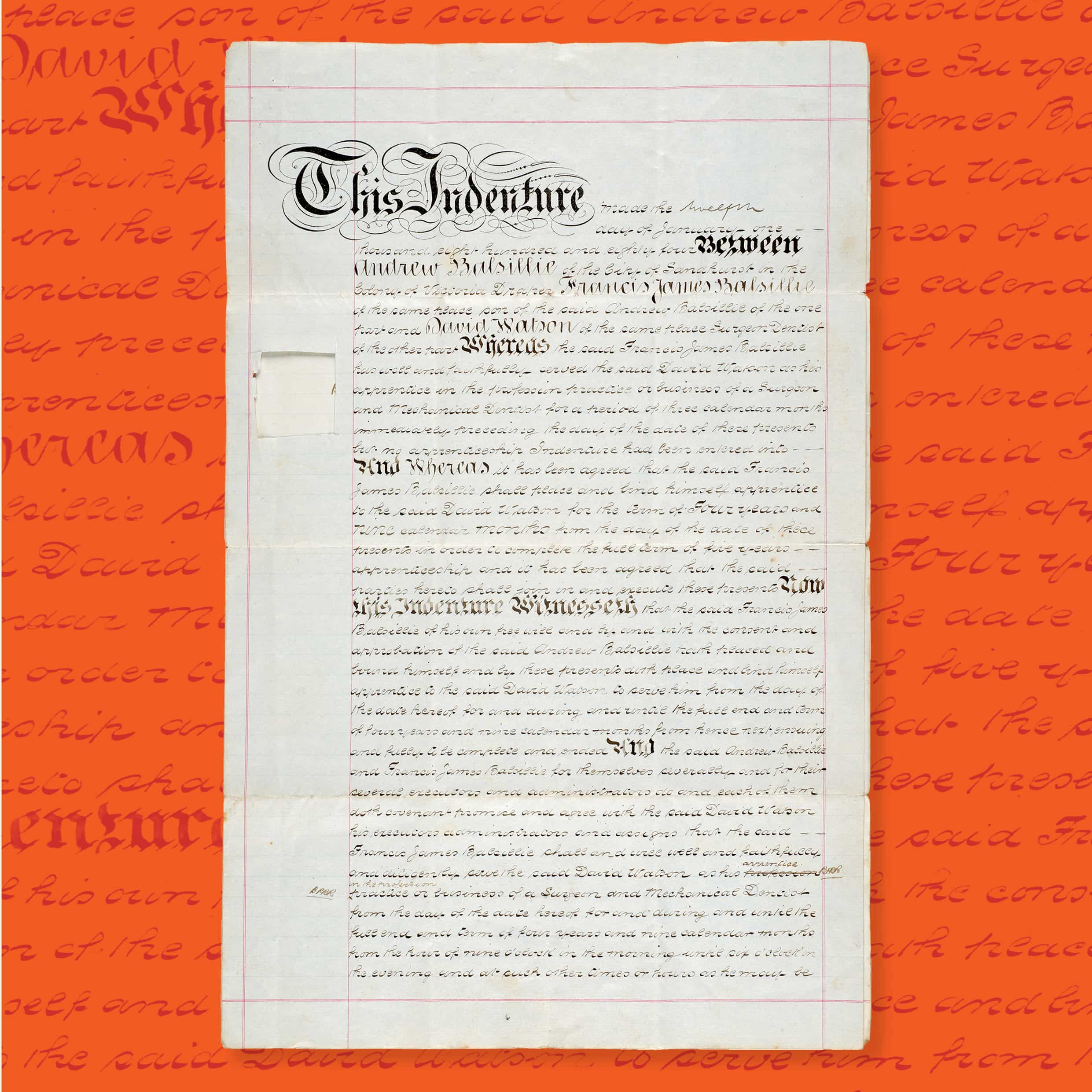
-
A thoroughly modern operatory
This photograph shows the operatory of Mr William McIntosh, in the rural Victorian town of Colac, c. 1900. The younger man is Mr John Wiley Meadows (1878–1974), who was apprenticed at 18 years of age to Mr McIntosh in 1897.
The setup reveals the ‘acme of ambition’, with all the modern conveniences of the time. The upholstered chair has the capability of leaning back (although still with a ratchet-movement action). There are two foot-treadles (invented and patented by James Morrison in 1871, based on Isaac Singer’s treadle sewing machine): one for the laboratory (the table on the right) and one for use on patients, complete with a coupling to prevent backlash. We see a plumbed spittoon on the patient’s right and a more conventional one on the same side as Mr McIntosh’s rather relaxed and well-dressed apprentice, Mr Meadows, beneath the multifunctional bracket-table on the same attachment. The instrument cabinet, probably American, has a professional library on top and a special spotlight. And the patient is undergoing general anaesthesia with gas, probably nitrous oxide (first used in a dental setting in 1844 in the USA, by Dr John Riggs on Dr Horace Wells, who had noticed its amnesiac property and its clinical potential).
In setting up his surgery, McIntosh probably dealt directly with overseas manufacturers and suppliers. Note that there is no X-ray machine: X-rays had only been discovered by Wilhelm Röntgen in 1895, approximately five years before this photograph was taken.
An advertisement in The Colac Herald on 19 April 1905 showed the extent of the practice:
The practice of Mr W. J. McIntosh will be carried out as usual by his assistant (Mr J. Meadows), who has been in the employment of Mr McIntosh for the last eight years. Mr Meadows will visit Beeac the second Thursday in every month, when he may be consulted at the Farmers’ Hotel. He will also visit Birregurra every Wednesday, when he may be seen at Mrs Pengilley’s Hotel.
Meadows continued to practise in Bairnsdale, then in Ballarat, retiring in 1963 at the age of 84.
Dr Jeremy Graham

-
A dental apprenticeship and hire-purchase agreement
On 31 August 1928 a certificate was issued by the Dental Board of Victoria, certifying George Harper Forster Turner (1888–1969) as a dentist qualified to practise in the State of Victoria, having gained his training through an apprenticeship to his uncle, John James Forster.
Part of the prelude to that apprenticeship arrangement was this hire-purchase agreement between John James Forster (‘Surgeon Dentist of 11 Swanston Street, Melbourne’), and his nephews William Walter John Turner, Frederick Charles Turner, George Harper Forster Turner and Alfred James Turner. It lists the contents of the surgery in Swanston Street as at 30 September 1921, ensuring commitment to and participation in the practice. Of particular interest to us today is the recent discovery of such items from John James Forster’s surgery during the Melbourne Metro Tunnel archaeological dig.
The formal legal document for the hire-purchase was drawn up by Pavey, Wilson & Cohen of 360 Collins Street, a long-established and respected firm of solicitors in Melbourne at the time, which later became Corrs Chambers Westgarth. The total value of the agreement is written by hand on the front page as £1330; subsequent amendments have been made as payments have incrementally reduced the amount owing. Applying a conservative inflation rate of 3.9 per cent over the 97 intervening years, this amounts to approximately $110,000 in today’s value.
At this time a formal apprenticeship relationship was required by the Dental Board of Victoria for registration, as a supplement to the developing educational curriculum provided by the Australian College of Dentistry (and later in conjunction with the University of Melbourne). In this case it appears that the hire-purchase of surgery items was integral to securing the future prospects of the apprentice in a family business. The premises at 11 Swanston Street were used as a dental surgery by the Turner family until 1954.
Associate Professor John Boucher AM
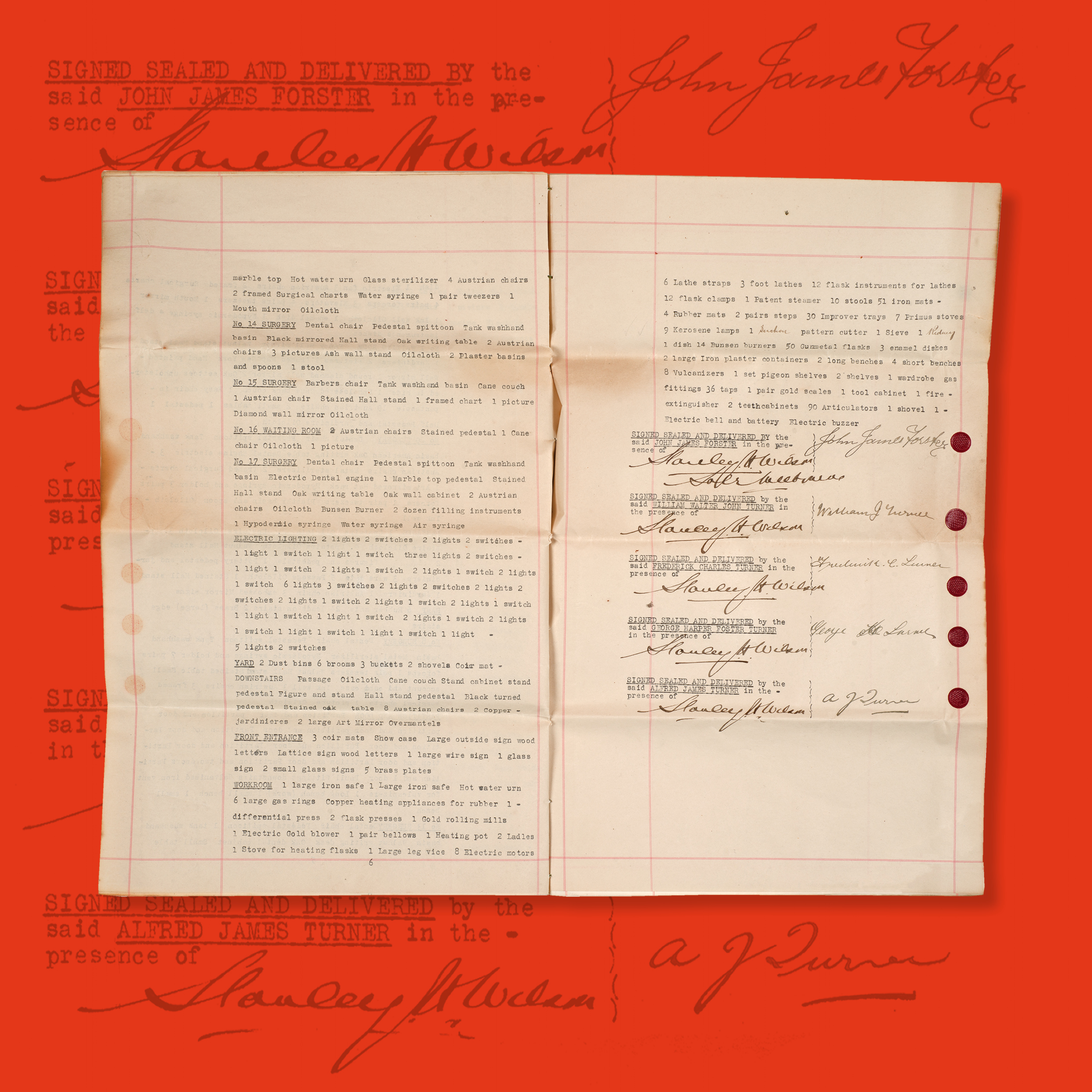
-
Melbourne’s train teeth
The land at 11 Swanston Street, Melbourne, was purchased by John Batman at the first Melbourne land sales in 1837, and became one of the area’s earliest sites of European settlement. It was developed by Batman and used for various activities, including Melbourne’s first girls’ school, until John James Forster opened his dental practice in 1898. He practised there, next to the Prince’s Bridge Hotel (Young and Jackson’s) and opposite St Paul’s Cathedral, until his retirement in the 1920s. The premises was then taken on by dentists F & G Turner (his nephews, Frederick Charles Turner and George Harper Forster Turner), whose advertisement is pictured here.
JJ Forster was a very successful dentist, who advertised his services profusely throughout his career. His lavish newspaper advertisements promise extractions ‘truthfully without pain’, thanks to his ‘latest American system’ of removing teeth. Disposal of those extracted teeth was simple and convenient: throw them out into the backyard of the surgery, to be buried and forgotten—they were no longer of any use.
In April 2018, a year-long archaeological dig began at the site, overseen by Heritage Victoria and Rail Projects Victoria in preparation for the construction of a new underground train station. This was the largest archaeological dig ever undertaken in the state of Victoria, with more than a million artefacts uncovered. Soon those long-forgotten teeth, as well as discarded dental materials and instruments, were being uncovered by the hundreds. Finds such as these are extremely rare, having only occurred a handful of times anywhere in the world. The discovery of these teeth gives us a treasure trove of material that can potentially tell stories about the lives of Melburnians more than a hundred years ago.
The ‘train teeth’, as they have become affectionately known, will be a valuable source of information for dental anthropologists, anatomists, forensic odontologists, archaeologists and many others for years to come. Even the detritus of caries, calculus, bone fragments and broken fillings attached to those teeth will provide researchers with rare material to uncover secrets about life in early Melbourne.
JJ Forster would never have imagined that his poor habits when disposing of useless teeth would result in such a precious resource for researchers a hundred years after his death.
Associate Professor Mark Evans
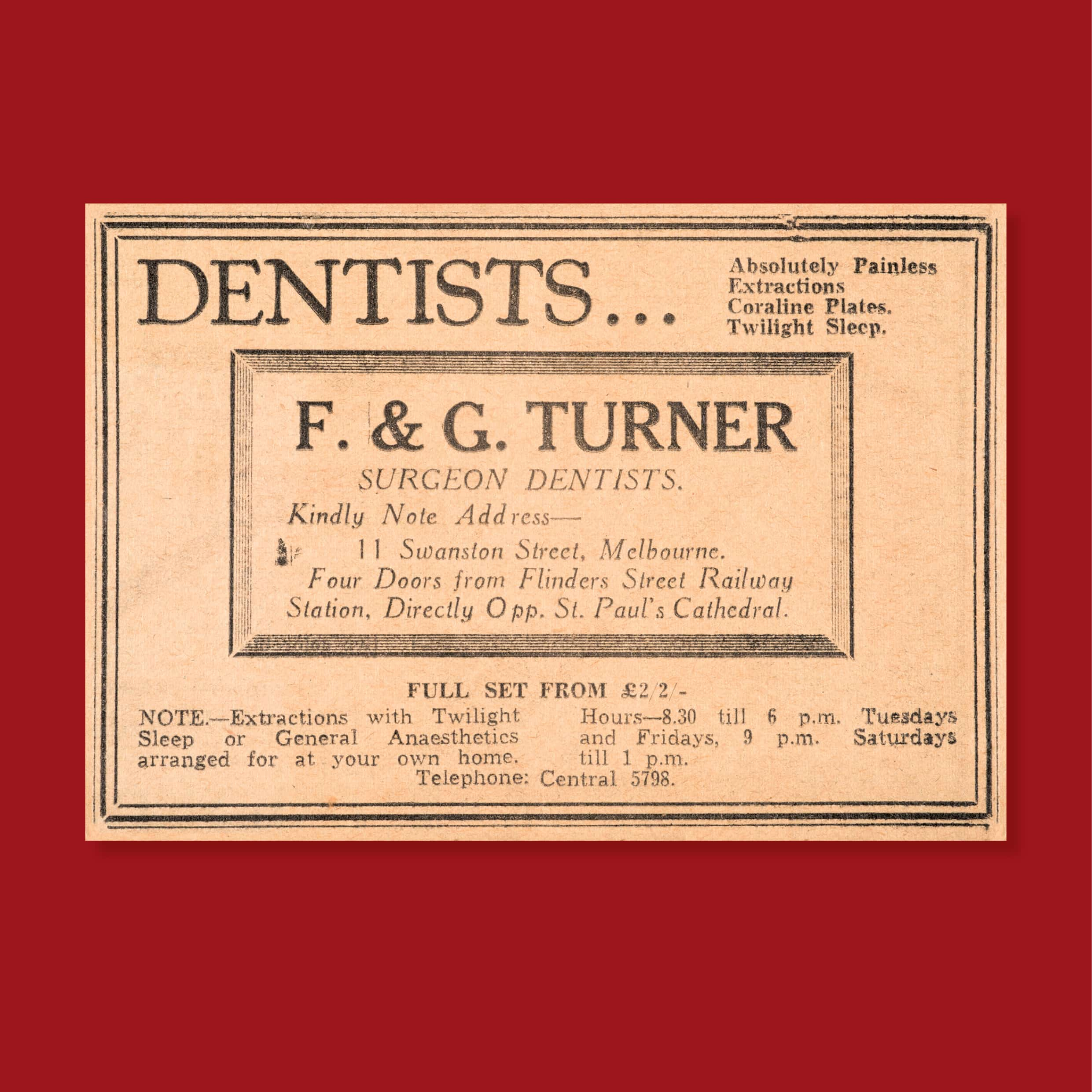
-
An early Mildura dentist
Joseph William Brownbill was born near the Victorian goldfields on 17 October 1880. His older brother George became a dental apprentice. Joe, who had left school early to work on the family farm, decided to join George in the profession. Joe educated himself to matriculation level and became a dental apprentice in Melbourne. The Brownbill Brothers set up a partnership in Maryborough and in 1908 opened a branch practice in Mildura. In 1911 the partnership was amicably dissolved. Joe moved permanently to Mildura, whilst George remained in Maryborough. Dentistry was in the family. As well as George and Joe, one brother became a dental mechanic, another a permitee (licensed to work under the supervision of a registered dentist) and another an illegal practitioner.
Extraction of all the teeth and provision of full dentures was the main dentistry of the day. Every six weeks, Joe would visit the Mallee settlements on the Murrayville line, extracting teeth one visit, taking impressions and bites the next visit, then posting out the completed dentures. In early years he travelled by horse and buggy, and later drove a T-model Ford. In about 1928, Joe built the surgery illustrated here, on the corner of 9th Street and Langtree Avenue, Mildura. Daddy, as he insisted on being called, was extremely proud of his design, which he said was ‘built to last a hundred years’, but he lived to see it demolished in the late 1950s.
I was a lad in primary school when a branch of the University of Melbourne was opened in Mildura in 1947, and I only became aware that some early-year dental students had come to Mildura when I started studying dentistry myself in 1955.
Joe was proud that his younger son studied dentistry. He lived long enough to congratulate me on extracting 54 teeth on my first morning in locals, but did not live long enough to see me graduate. Early into my career, I never thought I would do as much good for people as he had done; however, I am now sure that I have done more good with my concentration on teaching and preventive dentistry as my career.
Clinical Associate Professor John W Brownbill
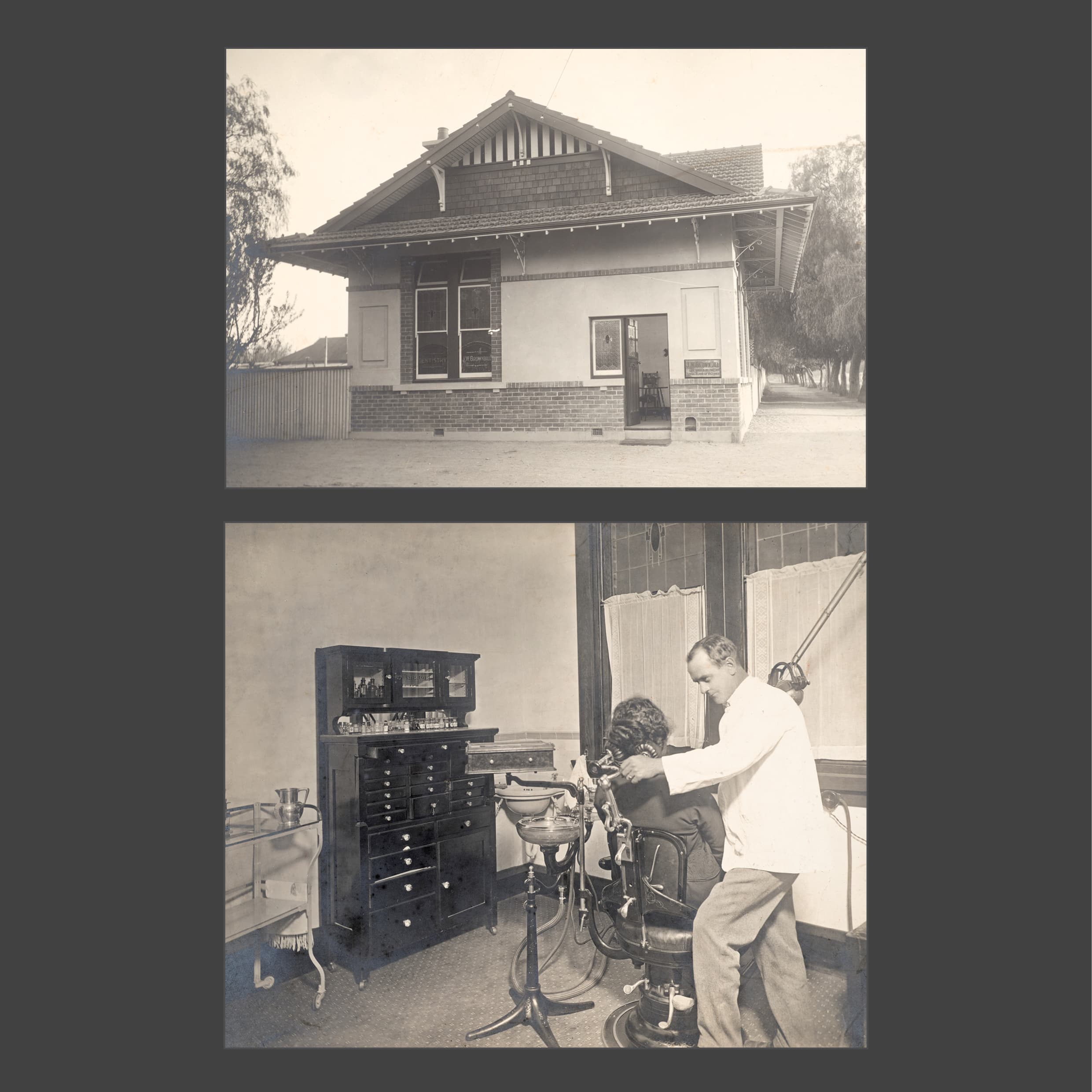
-
Australia’s singing dentist
Although rarely performed today, Mendelssohn’s sacred oratorio Elijah was for one hundred years after its 1846 premiere on a par with Handel’s Messiah, being performed regularly across the British Empire. Were you to attend a performance in Britain in the 1920s, you may have been lucky enough to hear an austere, elderly gentleman singing the title role, eyes shut, engulfed in the spirituality of the performance. Sir Edward Elgar called him ‘the greatest Elijah, bar none’. His name was Horace Stevens.
Born in 1876 in Prahran, Melbourne, Horace came from a family of dentists. His father, also Horace, had rooms at 86 Collins Street, while his grandfather, Alfred, practised in Wellington Street, Windsor. Horace and his sister Emilie showed early promise as singers; by the age of eight Horace was a champion boy soprano. In 1888 he performed at the Melbourne Exhibition, and again in 1889–90 with the great baritone Sir Charles Santley. In 1890 he began studying dentistry with his father, with whom he went into partnership in 1900. He later became clinical instructor at the Australian College of Dentistry. In 1908 he published a widely circulated paper on modern pain control, promoting the efficacy of cocaine as a painkiller.1
He enlisted in 1916 in the AIF Dental Corps. Promoted for bravery to the rank of captain, he contracted rheumatic fever in 1918, and during his convalescence studied singing with Sir Henry Wood, who immediately hired him to perform at the Proms. Throughout the 1920s he sang extensively in Britain and the USA. On EMI’s first commercial live recording he performed excerpts from Elgar’s Dream of Gerontius under the direction of the composer, and was selected by Vaughan Williams to premiere his Sea symphony in America. His performance as Wotan in Wagner’s Die Walküre at Covent Garden in 1923 was praised by Melba.
Stevens returned to Australia in 1933 to perform with the Benjamin Fuller Opera Company, and later accepted a position as voice teacher at the University of Melbourne. He continued to practise dentistry privately, and healed the teeth of many opera stars. He died suddenly at his home in Windsor in 1950.
David Hibbard
1 ‘Modern dentistry: Teaching teeth to grow. “Art concealing art”’, Darling Downs Gazette (Toowoomba), 30 November 1908, p. 7.
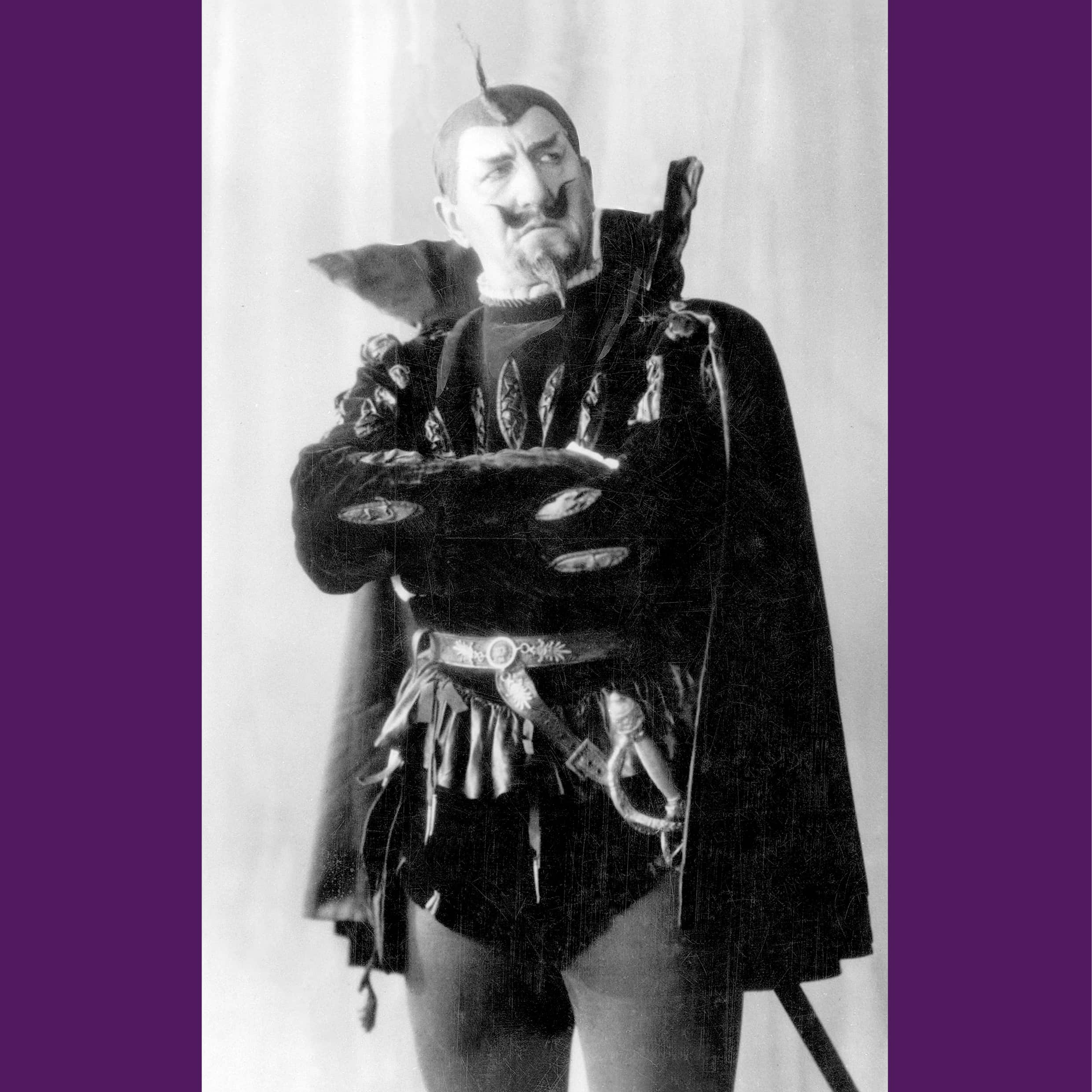
-
Message: Australian Dental Association Victorian Branch
Progress, far from consisting in change, depends on retentiveness. When change is absolute there remains no being to improve and no direction is set for possible improvement: and when experience is not retained … infancy is perpetual. Those who cannot remember the past are condemned to repeat it.
George Santayana, 1896
That the past informs the present and acts as a guide for the future is an accepted truism, and yet all too often we fail to adequately acknowledge our history. The links between the dental profession and dental education began with the formation of the Odontological Society of Victoria and remain strong to the present day. Progressive generations of dentists have worked to maintain high standards of professionalism, integrity, education and ethics in the dental profession, to ensure that Victorians receive the highest standard of dental care.
This exhibition take us on an exciting journey through the evolution of dentistry, and tell the story of many prominent dentists who helped to shape dental research and education in Victoria and build a strong professional association. There is a focus on the important role of public dental health and prevention, which acknowledges the high prevalence of dental disease that has been a constant refrain over the past 135 years. For example, the very real struggle to introduce water fluoridation in Victoria is an important lesson in the role of advocacy to benefit public health. Many dentists now take water fluoridation for granted, but there are important lessons here that we can continue to draw from in order to learn and be prepared for future challenges.
Dentistry: Innovation and education is a valuable work that highlights the strong and ongoing partnership between the Australian Dental Association Victorian Branch and the University of Melbourne Dental School.
Dr Gitika Sanghvi
President, Australian Dental Association Victorian Branch
![Darge Photographic Company (Melbourne, active 1881–1941), Examination room, Dental Hospital Melbne [178 Collins Street, Melbourne], c. 1900, photograph, 15.0 × 20.0 cm. ADAV00214,Australian Dental Association Victorian Branch Collection. Darge Photographic Company (Melbourne, active 1881–1941), Examination room, Dental Hospital Melbne [178 Collins Street, Melbourne], c. 1900, photograph, 15.0 × 20.0 cm. ADAV00214,Australian Dental Association Victorian Branch Collection.](https://medicalhistorymuseum.mdhs.unimelb.edu.au/__data/assets/image/0009/3353859/T4-item-1.jpg)
-
The governance and education of dentistry in Victoria
Introduction
Collectively, the founding members of organised dentistry in Victoria are a shining example of the famous Margaret Mead quote, ‘Never doubt that a small group of thoughtful, committed citizens can change the world; indeed, it’s the only thing that ever has’. Not all the early protagonists were dentists; in fact, the most dynamic trio comprised a dentist, John Iliffe, a lawyer, Ernest Joske, and a physician, John Springthorpe. In various permutations these three men were at the centre of every dental agency in Victoria for at least 26 years, and Joske for a remarkable 51 years. Before their coming together in 1888, dentistry in the colony had been an unregulated free-for-all, its practitioners ranging from a few qualified men to blacksmiths—and everything in between.
In the 1880s Victoria was a place of aspirations and rapid gentrification. The nascent dental professionals sought to distance themselves from the showmen and artisans. Rough wages were to be transmuted to refined fees, but there was also much credit in the aspiring professionals’ aim to protect the public from charlatans and incompetents. Mead-style disruptors may fight and win the war, but are often not suitable to control the peace, when conciliation and compromise are needed. So it was with the story of dentistry in Victoria: the pugnacity to achieve legislation and education was one thing; once achieved, each of these required different skills.
Midwives to a profession
In 1878 the British Parliament, after 20 years of lobbying, passed a Dental Act which created a dental register and a board under control of the General Medical Council.
New Zealand quickly followed in 1880, but the Australian colonies lagged behind. There was encouragement from non-dental sources. An editorial in the Australian Medical Journal in 1877 asked why dentists did not form an association and campaign for registration, while the 1878 Pearson royal commission into public education in Victoria recommended a dental department in the medical faculty of the University of Melbourne.
Not until February 1884 did 10 dentists meet to form an association, the Odontological Society of Victoria, later usually called ‘the Odonto’. In Canada, the Ontario Dental Association had been founded by nine men in 1867. The Odonto’s first president, James Cumming, said that the society’s aims were to promote professional cohesion, in other words to promote.
Clinical Associate Professor James Robertson AM
More information
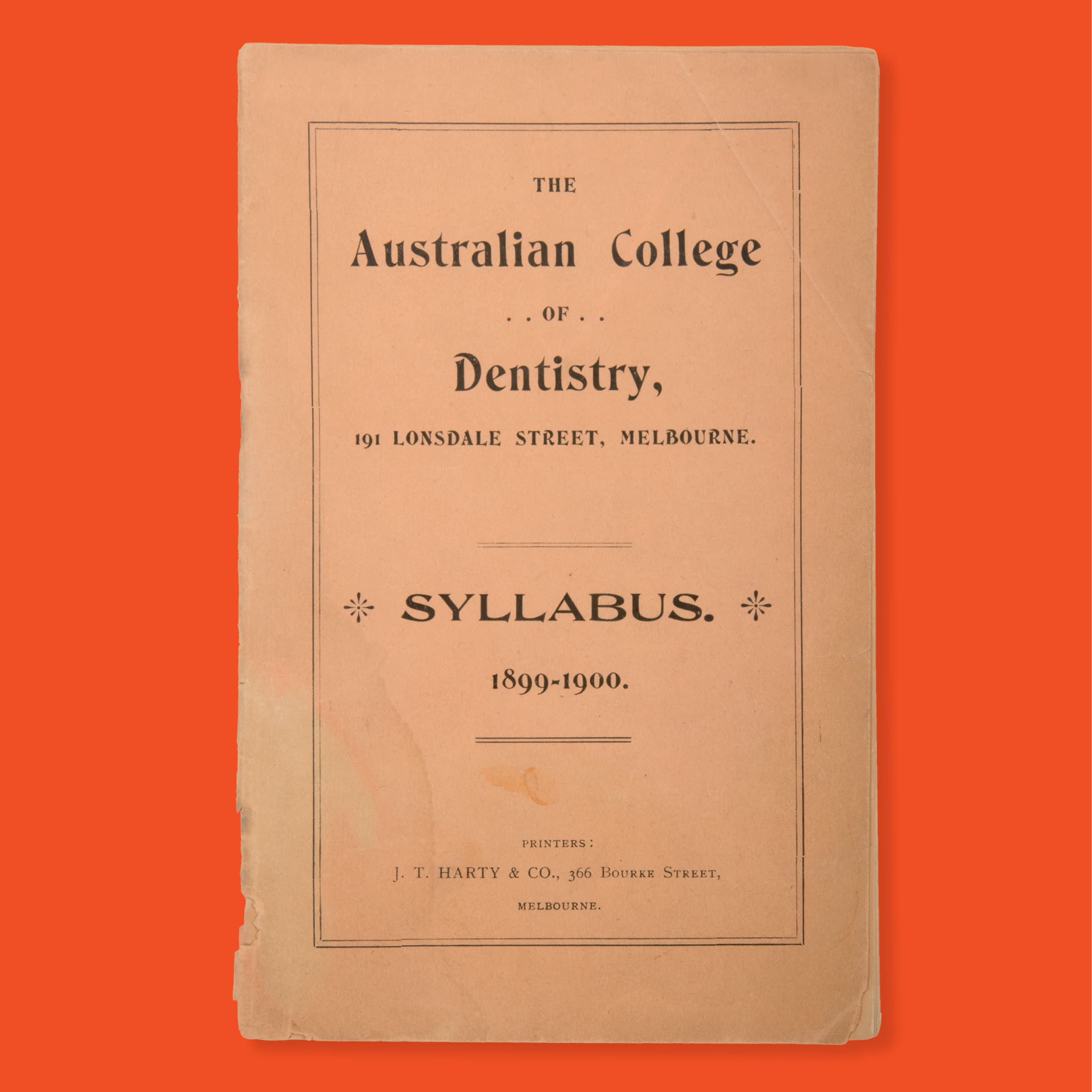
-
The Dentists’ Act 1887
The emergence of dental legislation is never straightforward. In 1882 the government of the colony of Victoria introduced a Dental Bill, which failed. The Member of the Legislative Assembly for North Melbourne, Dr JM Rose (a medical practitioner) introduced a private member’s bill for the registration of dentists in 1885 and again in 1886—both times unsuccessfully. Not one to be thwarted, Dr Rose introduced a modified bill in 1887, with success, and the Dental Board of Victoria commenced.
The first board consisted of eight members, appointed by the Governor-in-Council, which under the Act included at least four dentists and three legally qualified medical practitioners. Subsequent boards were elected by registrants, a practice which is not continued today.
This Act brought about the regulation of Victoria’s dentists for the first time. It required the Dental Board to examine dental students after four years of study, and to register suitably qualified dentists, dental students and overseas dentists. Any medical practitioner could practise dentistry; there was automatic registration for dentists from the United Kingdom (not much has changed today); other overseas-qualified dentists could be registered provided they had practised for 10 years and had a certificate of good standing; and grandfathering exemptions covered those persons already in practice in Victoria, apprentices and students. The Act specifically prevented the board from refusing registration because the applicant was not a British subject. Strangely, it further raised the prospect of the Governor-in-Council bringing an injunction against the board if it required a candidate for examination to follow a particular (unspecified) theory of dentistry. The practice of dentistry and the title of ‘dentist’ were protected to some degree, like today. Fraudulent misrepresentation in dealings with the board carried the risk of imprisonment for 12 months!A registrar was appointed to maintain the register, with the power to collect fees to fund the board, conduct investigations and remove registrants from the register. Importantly, dentists could sue patients for unpaid fees, and were exempted from jury duty and military service.
Today’s public and dental profession can thank leaders such as John Iliffe for this Act, as it set the legal framework for the future of dentistry in Victoria.Dr Gerard Condon AM
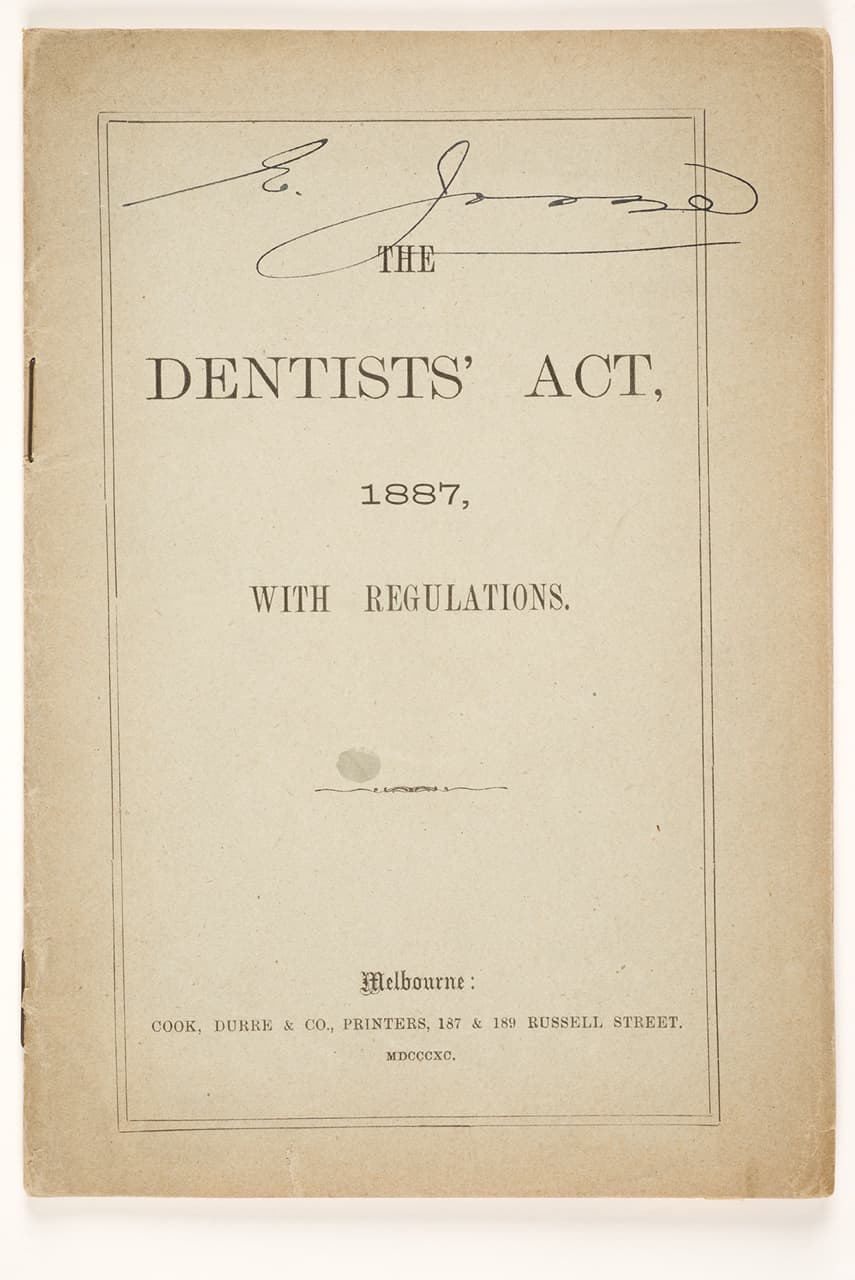
-
The father of Australian dentistry
John Iliffe (1846–1914) was widely recognised by his contemporaries as ‘the father of Australian dentistry’. Born in England, he was 14 when apprenticed to a dentist to learn the trade, and never used letters of formal qualification after his name. Arriving in Melbourne in 1866, he became assistant to Charles Pardoe in Collins Street and in 1871 succeeded to the practice.
From the early 1880s Iliffe was active in efforts to achieve organisational and educational reforms in the dental profession. In 1884 he helped form the Odontological Society of Victoria, becoming its president for many years. He helped draft the Act of parliament that established the Dental Board of Victoria; its role was to register dentists, formulate qualifications and a curriculum, and establish guidelines for professional ethics. He sat on that board for the rest of his life.
In 1889 he was involved in establishing the Dental Association, which aimed to obtain better educational facilities. The Dental Hospital opened in Lonsdale Street with Iliffe as vice-president, and chairman of the honorary staff. In 1897 the Australian College of Dentistry was established and Iliffe was appointed special lecturer in prosthetics (dentures) and metallurgy. Iliffe became editor of The Australian Journal of Dentistry in 1898 and was honoured as the first president of a national Dental Association in 1911.
Towards the end of his life, Iliffe’s commanding position was challenged by younger dentists, some of whom had graduated from American universities. They sought to emphasise scientific and biological studies over the practical and mechanical skills that Iliffe was seen to represent. Iliffe strongly opposed the amalgamation of the Dental College with a university, but in 1904 the Faculty of Dental Science was established at the University of Melbourne, though physically the college remained in Spring Street for many years.
Iliffe’s remarkable tenacity and clear vision in helping to create an independent and respected dental profession in the years 1885–1910 were widely recognised. He died in 1914. His estate, after the death of his wife, was bequeathed to the Faculty of Dental Science and used to establish prizes and scholarships in his name.
Susie Ehrmann

-
A medical man supporting the dental profession
John William Springthorpe (1855–1933) graduated in arts and medicine at the University of Melbourne before training in neurology at the hospital on Queen’s Square in London and becoming a member of the Royal College of Physicians. He became a physician at the Melbourne Hospital and a lecturer at the University of Melbourne. He was also actively involved in medical politics in the Medical Society of Victoria and the British Medical Association Victorian Branch.
‘Springy’ was appointed to the Dental Board of Victoria in 1888. He strongly supported John Iliffe, the driving force behind negotiations by the Odontological Society of Victoria for meaningful training and regulation of the profession. He also supported Iliffe’s work in founding the Melbourne Dental Hospital in 1890, and was very influential in the subsequent development of the Australian College of Dentistry in 1897.
In 1904 discussions between the university and the Dental Board of Victoria recommended the establishment of a dental faculty at the University of Melbourne. This was approved, with the Australian College of Dentistry now becoming affiliated with the university. Springy was elected as the inaugural dean of the new Faculty of Dental Science.
An obituary in The Argus newspaper summed up Springthorpe’s contribution in the following words:
It was largely due to the efforts of Dr. Springthorpe that the profession of dentistry was raised to a definite status in Victoria. Until about 1890 any man who could pull a tooth was able to obtain registration as a dentist.
As the leader from that date of a movement which resulted in the foundation of the Australian College of Dentistry in Melbourne, as president of the Dental Board for 13 years, and as dean of the faculty of dentistry at the University of Melbourne for 10 years, he was identified with every movement for the improvement of the status of dentists.1The history of dentistry is mainly with dentists, but it helps to have friends.
Dr Allan Mawdsley OAM
‘Obituary. Dr. J. W. Springthorpe: Long record of service’, Argus, 24 April 1933, p. 8.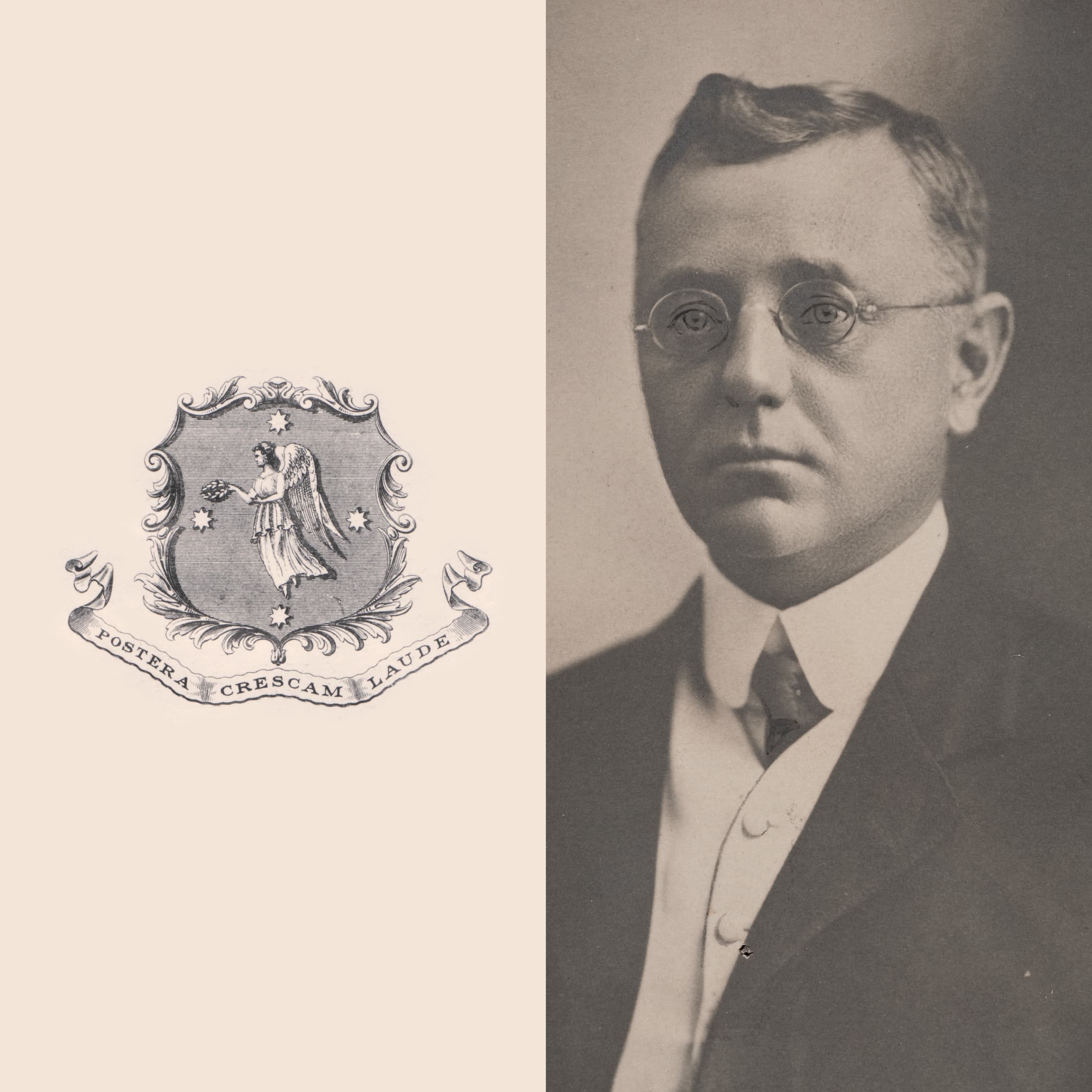
-
Two generations of lawyers supporting Victoria’s dentists
Ernest Ouzer (Oskar) Joske (1858–1939) was born in Germany, arriving in Australia with his family as a young child. He earned a scholarship to Melbourne Grammar School, where he was dux in 1873. The year before, Ernest’s father (a wine merchant) had been killed in a workplace accident, leaving his mother to provide for the family by teaching German and French. After leaving school he worked for the public service and studied law part-time at the University of Melbourne, graduating in 1884. The following year he became the first secretary of the Victorian Public Service Association (now the CPSU), serving in this role well after he began his involvement with the dentistry profession.
In 1888, as part of the long-fought-for Dentists’ Act coming into effect, the Dental Board of Victoria was formed and put out calls for a registrar. Ernest was one of 41 applicants and, at the young age of 30, was selected for the position, a role he would hold for almost the rest of his life. He leapt in and became a powerful force promoting and defining the dentistry profession in Victoria. He created the register, personally vetted candidates for registration, and doggedly pursued legal cases against unregistered persons who practised or advertised as ‘dentists’. He held honorary roles in various organisations, such as the Dental Association of Victoria, Melbourne Dental Hospital, and Australian College of Dentistry, to name but a few. In recognition of his 50-year service as registrar, the dentists of Victoria commissioned this portrait of him by renowned painter Charles Wheeler, which was a finalist in the 1938 Archibald Prize, the year before Joske’s death.
Joske’s son Percy Joske, who succeeded him as registrar, generously donated £1000 to the University of Melbourne in 1963 to establish the Ernest Joske Research Award in Dental Science, in honour of his father’s significant contribution to the profession of dentistry. I was privileged to receive this award in 2017 for identifying the first structure of the Type IX secretion system in Porphyromonas gingivalis, the research for which was published in the journal PLOS Pathogens in 2016.
Dr Dhana Gorasia
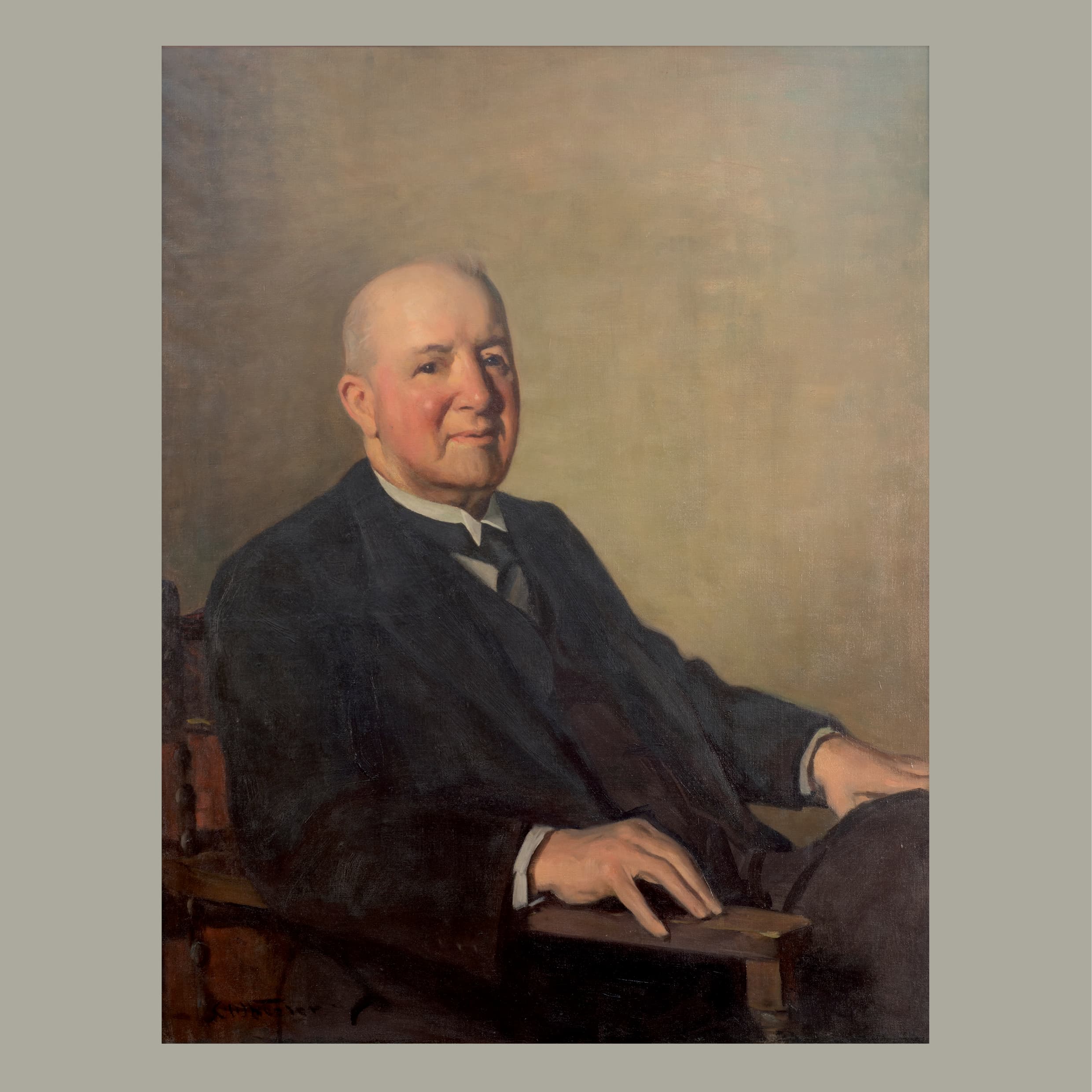
-
The Dental Board of Victoria
Until the early 1880s, anybody could practise dentistry in Victoria, regardless of their training, skills or experience. In 1884 the Odontological Society of Victoria (later renamed the Australian Dental Association) lobbied strongly for the regulation of the profession, succeeding with the passage of the Dentists’ Act 1887. This established the Dental Board of Victoria, a register of practitioners, and the position of registrar, and also granted authority to conduct examinations to test fitness to practise. Persons who could prove that they had practised dentistry before the passing of the Act could be registered. The following year, unqualified persons were prevented from using the title ‘dentist’ or‘dental surgeon’, but it was still not an offence for them to practise. In 1909, registration became compulsory for a person to practise in Victoria.
The inaugural registrar was a Melbourne lawyer, Ernest Joske. He served for 51 years, during which time the profession matured, as did the Dental Board. He was succeeded by his son, Percy Joske, who held the position for the next 17 years. The interests of the public and the profession were well served by both father and son. In 1963 Percy Joske endowed the Faculty of Dental Science at the University of Melbourne with an award bearing his father’s name, which continues to be awarded to this day. Subsequent registrars were Miss Vera Sutton, Dr Ewan Deane, Dr Vincent Amerena, and Mr Peter Gardiner, each of whom served with distinction.
With the passing of the Dental Practice Act 1999, the Dental Board of Victoria was replaced by the Dental Practice Board of Victoria, which provided for the registration of dentists, dental specialists, dental prosthesists, dental therapists and dental hygienists. In 2010 its role was assumed by the new Dental Board of Australia, making registration to practise dentistry the responsibility of a national body.
Thus the Dental Board of Victoria functioned continuously from 1887 to 1999, with only six registrars over that time, but with a very large number of dentists serving as board members. It has a fine record of service in the interests of the people of Victoria and in the regulation of dental services.
Dr Ross King AM
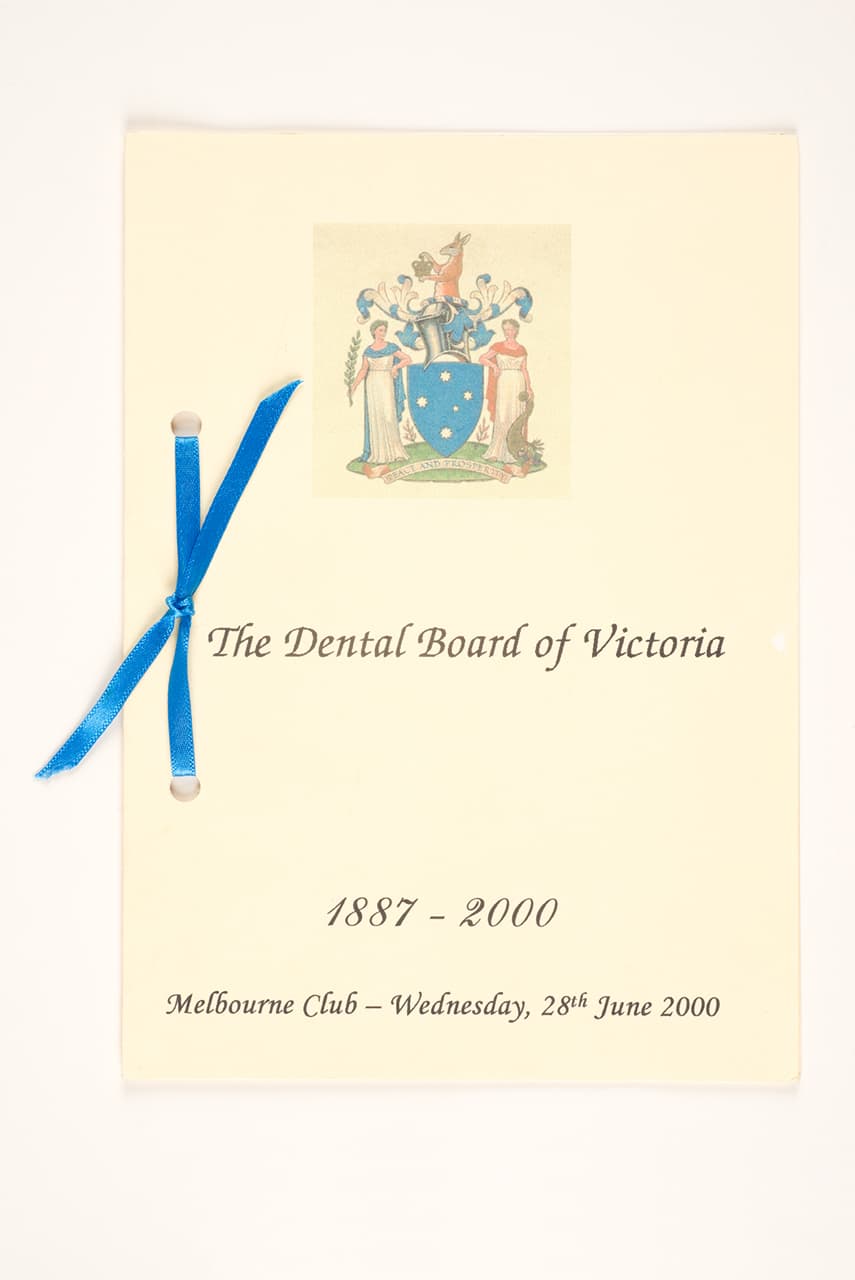
-
Melbourne Dental Hospital, 239 Lonsdale Street
After the passing of Victoria’s first Dentists’ Act in 1887, there was an urgent need for premises where dental students could gain practical experience, on patients who received free treatment in return. Donations from many dentists and well-wishers permitted the renting of a first-floor room at 225 Lonsdale Street, opposite the Melbourne Hospital. It opened as the Melbourne Dental Hospital in September 1890. Furnishings were spartan, treatment was limited to examinations and extractions, and staff was a volunteer dentist. It operated for two hours each morning, six days a week. Funds were few, paying students were fewer, and an economic depression hit Victoria soon after the opening.
In straitened circumstances, the hospital decamped in September 1892 to cheaper rooms at 239 Lonsdale Street (pictured here). The first location had been above a horse-and-carriage bazaar; the new venue was below an undertaker firm. Today, neither seems appropriate—for hygiene or status—but the undertaker was probably kept busy by the Melbourne Hospital across the road. In 1894 the Dental Hospital had to be financially rescued by the Dental Association of Victoria, which took over its management. As John Iliffe was president of both the DAV and the former hospital committee of management, little changed in practice. The DAV was a broader front to garner support, but the volunteer staff dentists were drawn from the Odontological Society of Victoria, another Iliffe-dominated group, to imbue students with a non-advertising ethos. A final Lonsdale Street move to relatively salubrious rooms at 189–191 happened in 1897, this time to a former clothing factory above a second-hand clothes store. The move was in preparation for a government-approved education curriculum, which would attract more students. A new body, the Australian College of Dentistry, with an American dean, Alfred Merrill, was formed to co-exist with and jointly run the hospital. Staff, comprising a superintendent, cleaner and office boy, were employed initially and three surgeries were designated but barely furnished. An inquiry into the college’s running in 1900 revealed unsanitary conditions and poor practices. These prompted operational improvements, but little capacity for restorative dentistry until a move to custom-built facilities in Spring Street in 1907.
Clinical Associate Professor James Robertson AM
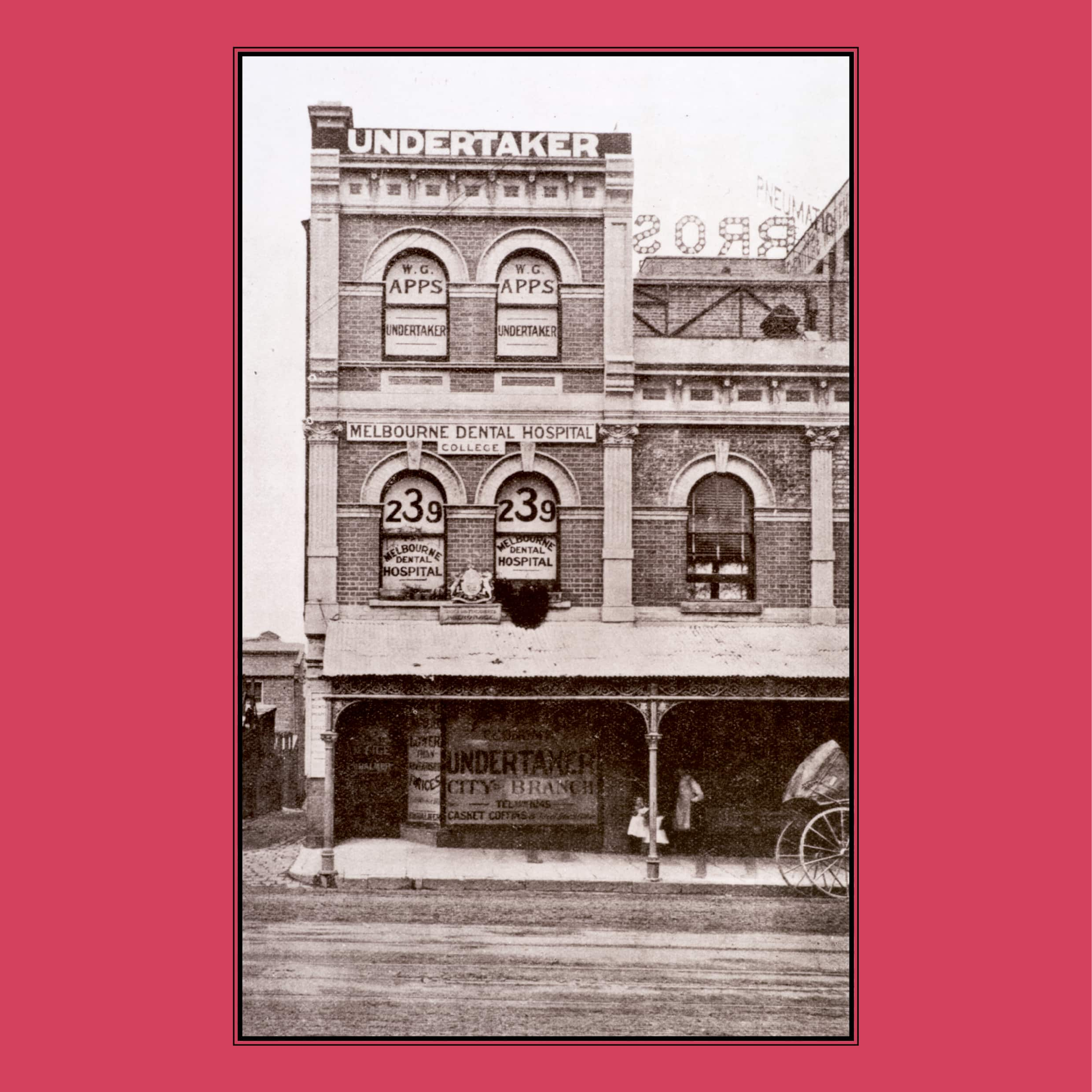
-
The Spring Street Dental Hospital
After being on Spring Street for 56 years, the Melbourne Dental Hospital and Dental School moved to Parkville in 1963. I was a student during the school’s final five years at Spring Street—my year was the last to graduate from the ‘old’ building. Year sizes were much smaller than today: about 20 to 30 students per year, including two or three women students. Several women were dentists from European countries who had to repeat the complete dental course in order to qualify for Dental Board registration in Victoria.
The building was situated on the corner of Spring Street and Little Bourke Street. The ground floor contained several hospital clinics, the library, a lecture theatre, a small research lab (under the stairs), the ‘op tech’ (operative techniques) student lab, and conservative dentistry academic staff offices. Converted army huts in the rear courtyard housed the hospital orthodontics clinic. The first floor contained a large student conservative clinic, hospital administration, hospital radiology and oral surgery clinics, and offices for the hospital director (Dr Bill Smith) and dean of the school (Sir Arthur Amies). The second floor contained student clinics, student labs for prosthetics, and academic staff offices.
The school had three departments: conservative dentistry (under Professor Julian Reich), prosthetics (Professor Henry Atkinson), and oral surgery (Sir Arthur Amies). Several staff had trained through a government scheme for ex-servicemen, conducted in Mildura. While few held higher degrees, they could complete a master’s degree on the job. Many part-time teaching staff had obtained higher degrees in the US (in ‘crown and bridge’, or in orthodontics), or in the UK (oral surgery). The top graduating student was frequently offered a teaching position, with the option of completing a master’s degree.
Reminiscing, I recall we purchased our own instruments for lab work and patient care. Stored in large kit-boxes, these were carried into the clinic and set up chair-side. The typical restorative materials placed were amalgam, silicate cement, cast gold, and gold foil. Extractions for children were frequent, usually under nitrous oxide anaesthesia. The annual social highlight was the Dental Follies—a cabaret-style evening involving a student stage show.
Professor Emeritus Louise Brearley Messer AM

-
The promised land—this great hospital
At the University of Melbourne in 1962, clinical and general teaching opinions were that it would be most convenient if entry into the new dental building could be arranged for early in the following year, during the holiday period of low patient attendance and before commencement of clinical teaching.1 Firm dates were given for occupancy over the weekend of 2 and 3 March 1963. Treatment was to commence in virtually all departments on Monday 4 March 1963. The official opening of the new building was arranged as a joint ceremony with the university, to take place on 23 May 1963. The first meeting of the committee occurred in the board room at the new address, corner of Elizabeth Street, Grattan Street and Flemington Road, on 26 March 1963. Inview of the importance of the occasion, the opening remarks of the president, Mr WH Anderson, are recorded in full:
This first meeting of the Committee of Management in the new building presents the occasion to pause a moment before conducting normal business. Our first thoughts must be directed towards those pioneers who from the early days of over half a century devoted their vision and energy to institute a dental hospital in Melbourne. To them is due the first building in which a hospital was conducted; then the building which we have vacated after so many years; now this magnificent new building in which we meet today.
Like Moses, who led the Children of Israel for 40 years in the wilderness, it was not granted to many of those pioneers to enter the promised land, this great hospital. There are a few still with us, such as Dr Tuckfield to whom we owe so much.
But we enter into the heritage and with it we enter into a great responsibility to enlarge the future, to think big, to act well and wisely.
It is incumbent upon us to work as a team for the advancement of dental science, for the status and integrity of the dental profession, and the ease and well-being of the patients committed to our charge.
Professor Emeritus Henry Forman Atkinson MBE (1912–2016)
- This text is an edited version of an extract from HF Atkinson, In defence of ivory towers: The history of the Royal Dental Hospital of Melbourne, Melbourne: Privately published, 1990, pp. 86–7.

-
The School of Dental Science moves yet again
In 1897 the Australian College of Dentistry opened, in premises shared with the Melbourne Dental Hospital at 189–191 Lonsdale Street.1 In 1907 the college moved to its own purpose-built premises at 193 Spring Street. In 1963 the new School of Dentistry and Melbourne Dental Hospital opened on the corner of Elizabeth and Grattan streets, Parkville, opposite the Royal Melbourne Hospital.
Another move was presaged in 2003, when the hospital moved to new premises in Swanston Street, Carlton, but the school remained in the Grattan Street building through 2004. This was because there had been so much expansion in the school over the previous few years, particularly in research, that not all of the school could be accommodated in the space set aside for it in the Swanston Street building. A solution was found, however, and during 2004–05 some of the school moved to the new Bio21 Institute building in Royal Parade, which was completed in 2004.
Once the new teaching laboratories were finished at Swanston Street and the remainder of the fitout was completed, the rest of the school relocated to Swanston Street. This time, however, the school would share space not only with the hospital, but also with RMIT University, which was already teaching dental assistants and prosthodontists at the site. Negotiations then commenced to obtain funds for the fitout of the space in the Bio21 Institute for the relocation of some of the school’s research activities.
In 2020 we can definitely say that close proximity to other researchers in the Bio21 Institute and access to state-of-the-art teaching facilities in Swanston Street have proven to be of long-term benefit to the Melbourne Dental School.
Laureate Professor Eric Reynolds AO
This is an updated and edited version of Eric Reynolds, ‘The School of Dental Science is moving’, Dent-al: Alumni Newsletter, issue 1 (2004), p. 2.
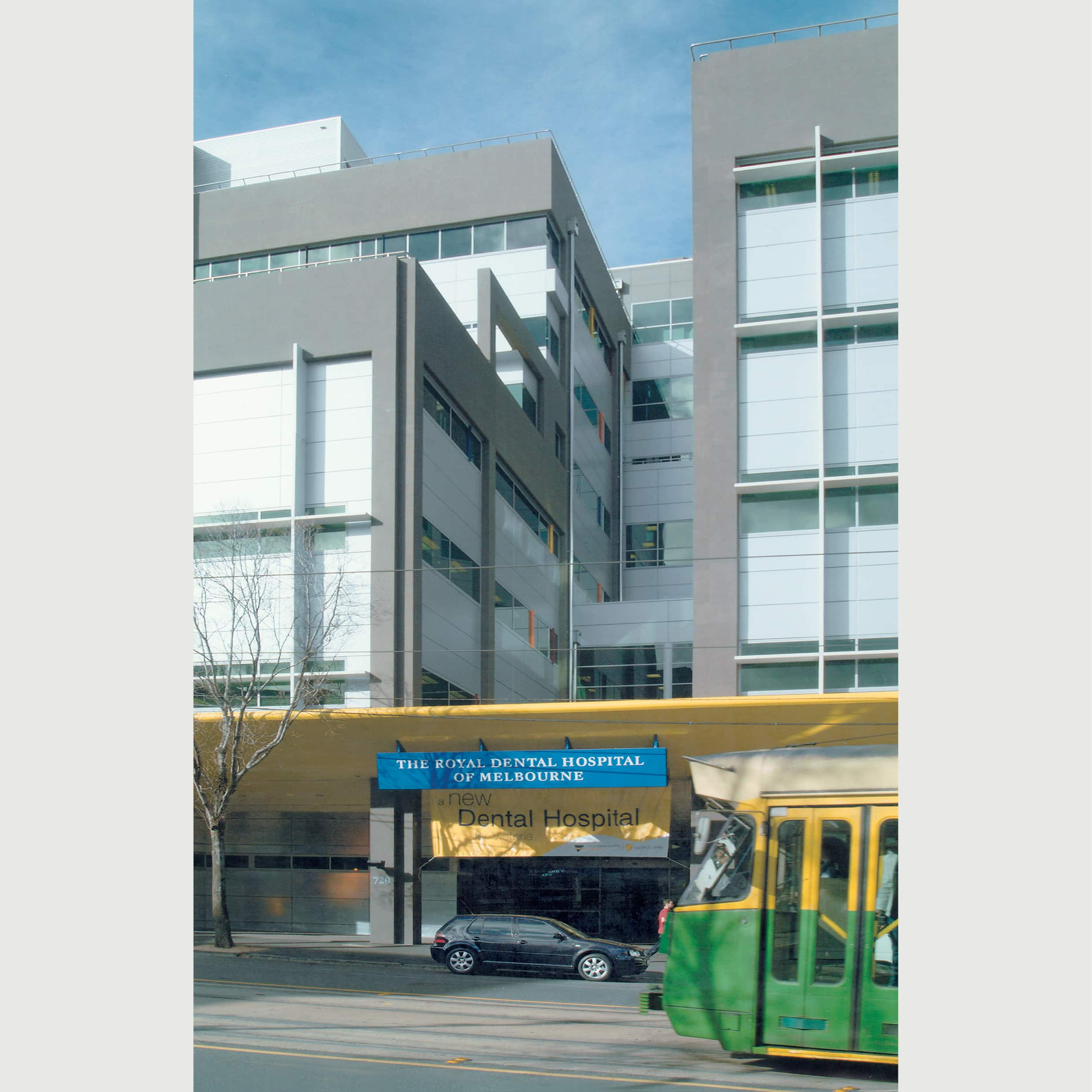
-
Prize for practical dental surgery
Seated front row, left, is Oscar Behrend (1889–1958), who graduated from the Australian College of Dentistry in 1909 at the age of 20, winning the prize for practical dental surgery. By regulation, he had to wait until his 21st birthday before being licensed to practise. When the College of Dentistry affiliated with the University of Melbourne, he obtained his Bachelor of Dental Science. In 1920 he earned a Doctor of Dental Science.
During World War I Oscar served as a captain in the AIF Dental Corps, working first in camps and hospitals in Victoria, and later in England, France and Belgium. On his return from the war, he practised at 12 Collins Street until he retired. His appointments included honorary clinical demonstrator the Australian College of Dentistry, 1909–30
Dr Donald A Behrend
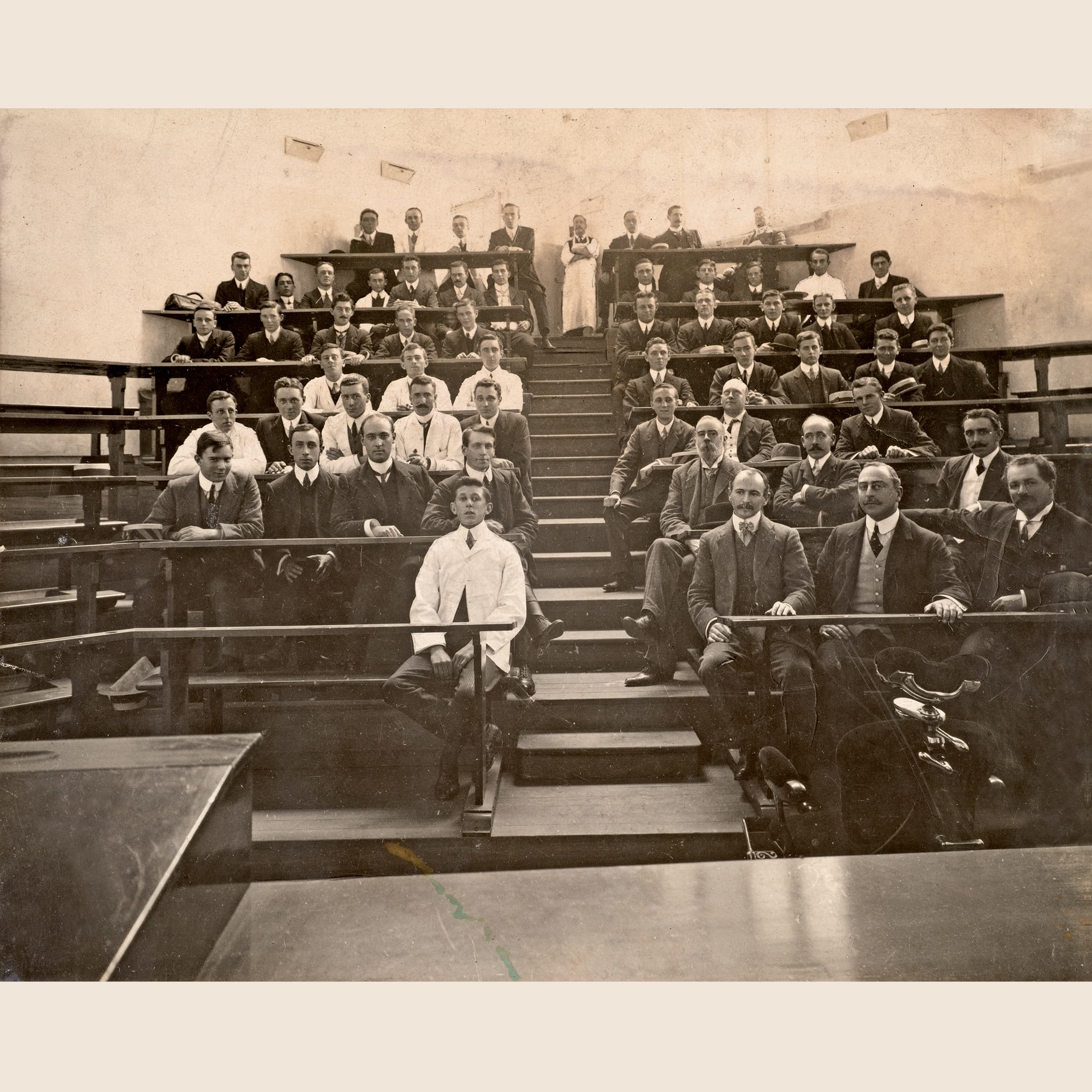
-
A fitting gesture
In 1912, the Melbourne Dental Students’ Society presented to John Iliffe a photograph of the final-year class. It was a fitting gesture to one of the founding figures of dental education in Victoria, which originated with a professional body seeking to secure a respected program of training for dentists.
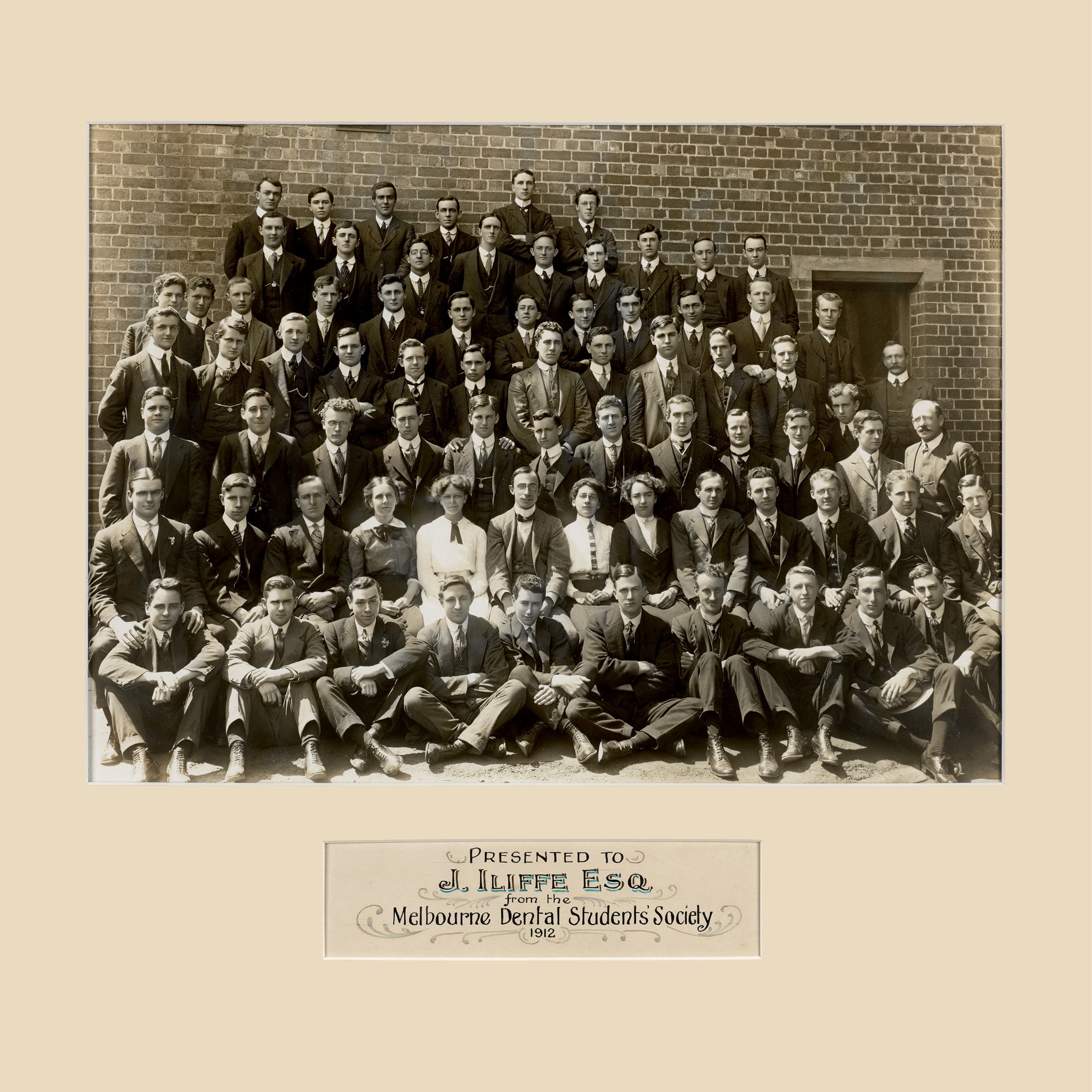
-
A royal kidnapping
On 27 April 1927 the Duke and Duchess of York (later King George VI and Queen Elizabeth) visited the University of Melbourne, the duke receiving an honorary Doctorate of Laws. The official ceremony in Wilson Hall was preceded by a mock ceremony, for which students donned costumes in caricature of the royal party and academics. Afterwards, the president of the Students’ Representative Council invited the duke to an informal reception.1 He graciously accepted and was promptly whisked into a carriage for a procession through the grounds. A dental student made an address, in which he ‘referred modestly to the fact that its students were all of good extraction—indeed, were the crowning glory of the Duke’s subjects’.2 The duke was then bundled into a clubhouse, where he recited an oath:
I, Albert Windsor, of London, having been graciously admitted to this most august body of students, hereby make this solemn oath and declaration: That I will always conduct myself in a manner, humble and lowly, as befits a student, inasmuch as I will be prepared, at all times, to supply beer and cigarettes when called upon to do so for my less fortunate comrades. I also pledge myself to support this society to my full endeavour.3
The duke left the grounds to roaring cheers.4 Planning and execution of the ‘kidnapping’ have been attributed largely to the dental students. In the Henry Forman Atkinson Dental Museum is this copy of a letter from the duke’s private secretary, dated 4 May 1927, politely declining the Dental Students’ Society’s offer to make the duke an honorary life member, accompanied by a photograph for display in their common room. The letter concludes with an assurance of the duke’s ‘very happy recollections of his visit to the University’.
Susannah Britt
- ‘The duke at university’, The Age, 28 April 1927, p. 9; HF Atkinson, ‘A royal portrait’, University of Melbourne Collections, issue 6 (June 2010), p. 35;
- 2 ‘Royal visit: Duke’s strenuous day’, Argus, 28 April 1927, p. 15.
- Ibid.
- ‘The king is a dental student’, Mouth Mirror, 1948, pp. 37–8; ‘Humorous ’varsity rag’, Saturday Journal (Adelaide), 7 May 1927, p.5.
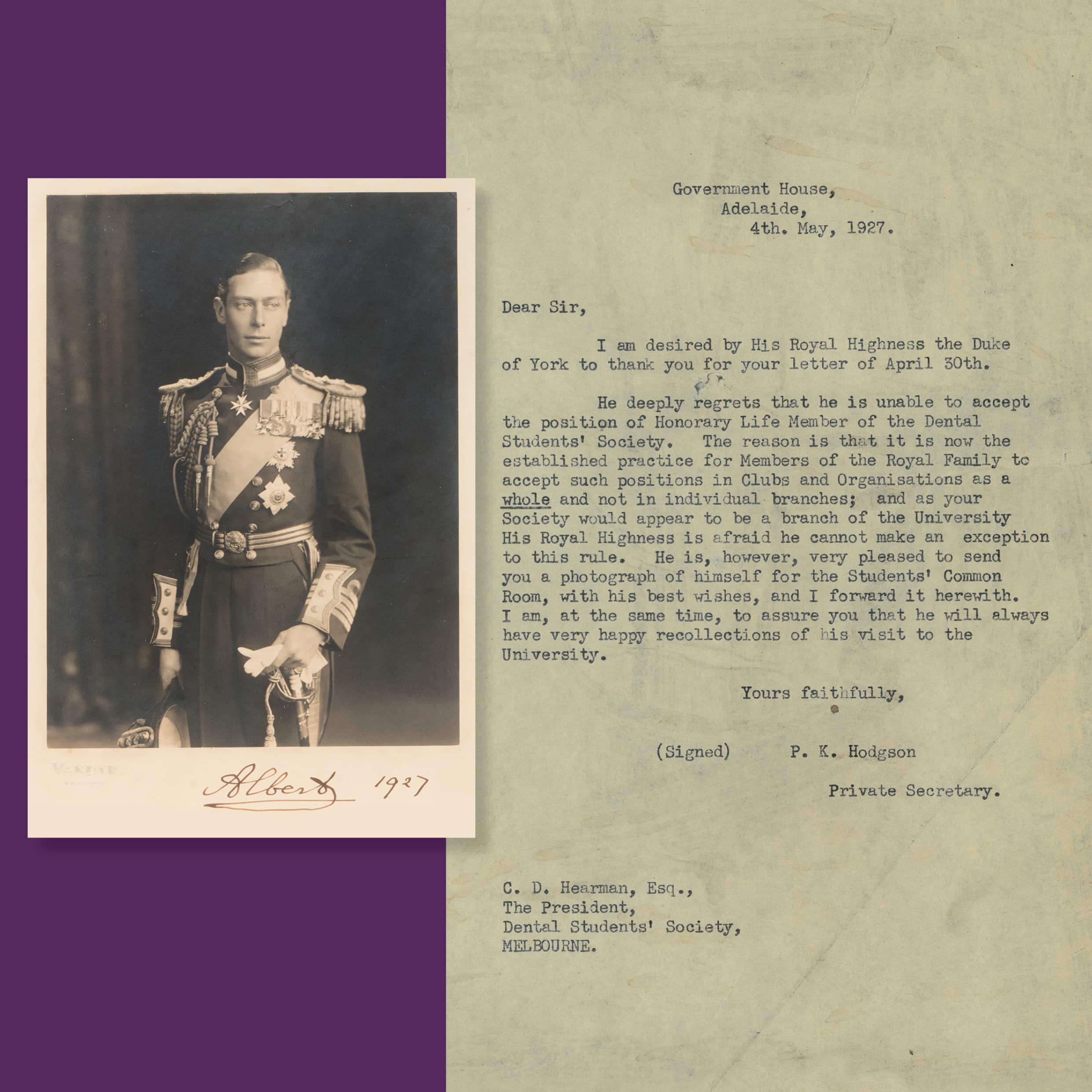
-
Student Life
It is sometimes thought that universities perform anthropomorphosis, turning scruffy school-leavers into models of professionalism. This was eloquently pictured in a cartoon on the cover of the 1974 edition of The Mouth Mirror by Neil Hewson, then studying third-year dentistry. A long-haired, bearded man, probably with ‘campus crawlers’ on his feet, goes into the ‘Dental Graduate Machine’ on a conveyor belt, and an upright, short-haired chap in coat-and-tie comes out—the transformation created under pressure. That may indeed be the case, but along the way there is much frivolity, laughter, and good fun, with lifelong friendships formed.
The Mouth Mirror is the annual publication of the Melbourne Dental Students’ Society (MDSS). The degree course at the University of Melbourne commenced in 1905; its alumni, and those of its predecessor courses, were instrumental in ultimately instituting the Australian Dental Association Victorian Branch. The MDSS’s predecessors were the Dental Graduates’ Society of Victoria, which in 1916 merged with the Australian College of Dentistry Alumni Society, which in 1922 became the State Dental Society of Victoria.
Many dental students are high-spirited beings, leading the way in the less savoury aspects of student life: the ‘abduction’ of the visiting Prince of Wales in 1927 , public high jinks such as cleaning the teeth of the entrance to Luna Park, staging The Dental Follies, even fielding ‘Mr University’ candidates. The Mouth Mirror shows that this is not a new phenomenon. In most instances, such escapades were for a good cause, and served as a welcome distraction from study. Examples were promoting a student event such as the Follies, or campaigning for the dental health of Victorians, such as in Dental Health Week. In the Follies, nothing was sacred, with sometimes merciless lampooning of senior staff—brave times indeed. The then Dental Faculty was small at the time, but met with great success in inter-faculty sport.
But The Mouth Mirror needed to be more circumspect in the printed word. Content included student and staff profiles, reports on MDSS activities and Australasian Dental Student Conventions, the inevitable sponsors’ advertisements, oft-times irreverent and sometimes serious articles, and the dreams and aspirations of the final-year cohort.
Dr Jeremy Graham and Associate Professor Dr Neil D Hewson
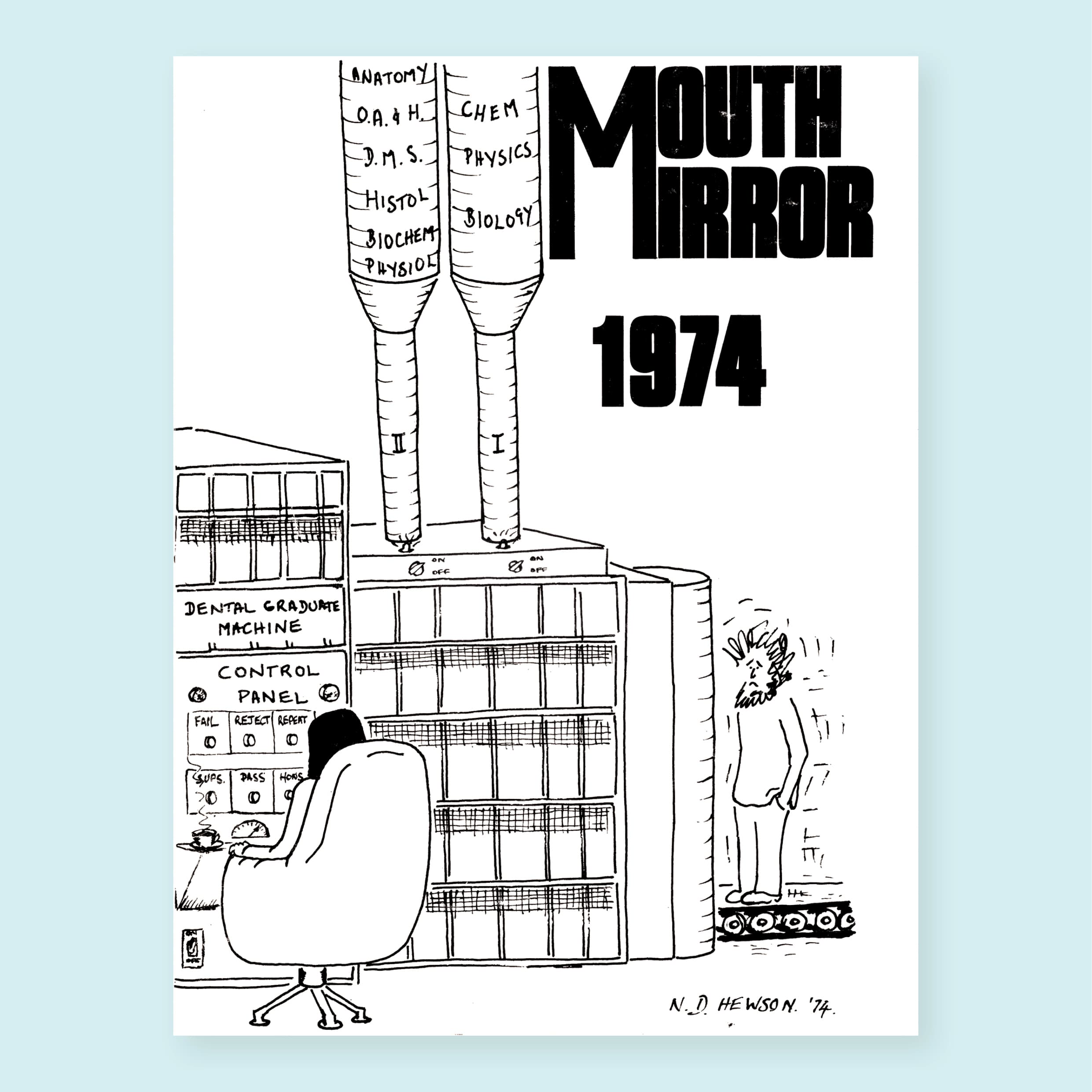
-
Dental Health Week in 1969
Students washing Luna Park’s teeth as part of Dental Health Week in 1969, including Vern Kimpton (top, poster and brush in hand), Peter Delahey and Rob Polloch (far right). Far left in front are Scott Jenkins and Ted Crawford.
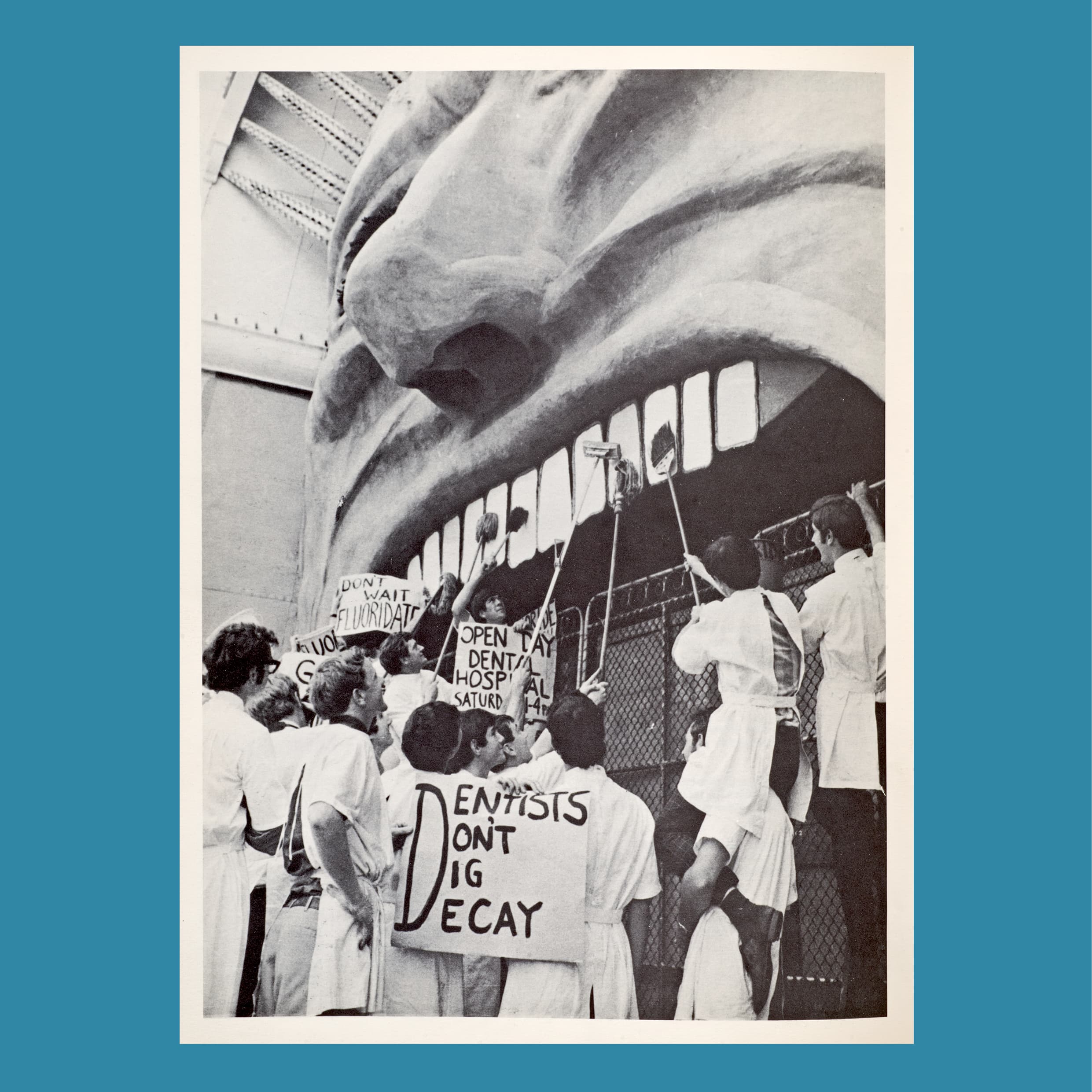
-
An early woman dentist
Ethel Florence Annie Godfrey (1871–1956) was one of Victoria’s first women dentists. Born in Melbourne, she attended Presbyterian Ladies’ College, showing promise as a student from an early age. Ethel was the first girl to win the exhibition in matriculation, in October 1888, having attained first-class honours in English and history. Between 1895 and 1898 she was one of only four female students at Mr E Lenthal Oldfield’s Dental College and Oral Hospital, a rival of the Melbourne Dental Hospital. (At this time the University of Melbourne was not yet involved in teaching dentistry.) Ethel and her three female colleagues from Oldfield’s passed the Dental Board examination in November 1898 and were registered as dentists on 8 February 1899. During Ethel’s time, women studying at the tertiary level were generally frowned upon, but she persevered and completed her course.
Ethel, along with her business partner (and later sister-in-law), Alys Berry, practised dentistry at 34 Collins Street in Melbourne until she married. For two women to have a business together and operate it alone was unusual, if not unheard of. They were entrepreneurs of their time, working under vastly different constraints, expectations and norms from their equivalents today. This was at a time when women in Victoria could not vote or own property, and equality of pay was not even considered.
In 1899 Ethel became the first female dentist employed at the Queen Victoria Memorial Hospital, which was established by women, for women. She was a member of the Lyceum Club and in 1903 married the prominent Melbourne surgeon and art collector Dr Samuel Arthur Ewing, with whom she had three children.
Ethel Godfrey’s determination to succeed is an example of strength, character and resilience, from which we can continue to learn today. The current student body in Victoria leans very much towards more women studying dentistry, which is also beginning to show in the emerging workforce. We have women like Ethel to thank for their enduring legacy.
Ethel Godfrey died in 1956, but her story lives on to inspire many young women, today and in the future.
Dr Gitika Sanghvi
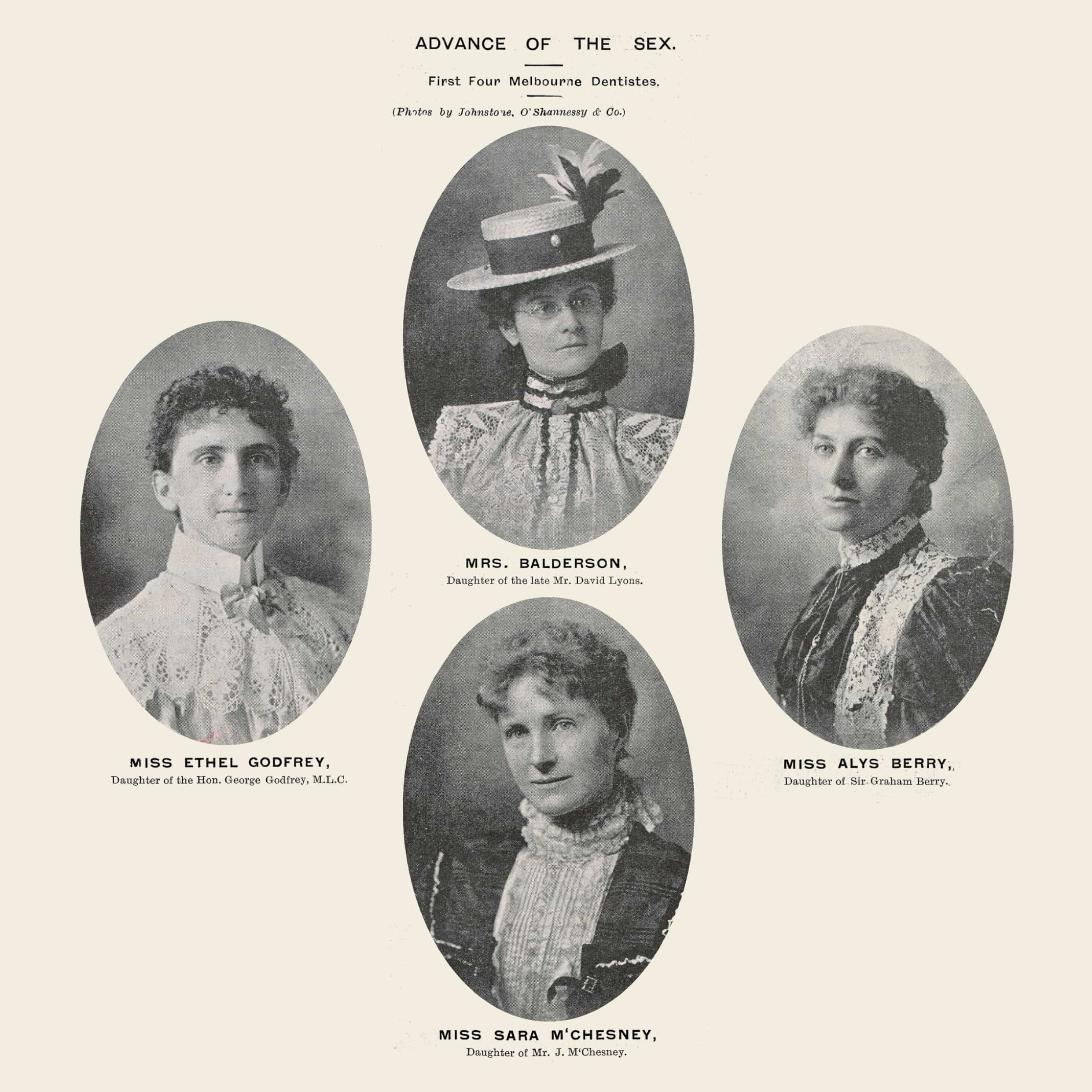
-
Melbourne’s first woman Bachelor of Dental Surgery
Frances Blanche ‘Fanny’ Gray (1884–1958) was born in England, moving at the age of five with her family to Victoria, where she spent her childhood. On 21 December 1904 she was awarded a Licentiate of Dental Surgery (LDS) by the Dental Board of Victoria, and on 25 March 1905 was formally registered to practise dentistry. In 1907 she became the first woman to graduate with the University of Melbourne’s Bachelor of Dental Surgery degree. At university she befriended fellow student Martha Burns, who went on to have an illustrious dental career. Frances practised dentistry primarily from Professional Chambers at 110 Collins Street, alongside colleagues such as Ada Tovell, the first woman to graduate MACD (Member of the Australian College of Dentistry), in 1900.
Frances was one of a handful of women dentists to attend both the 1909 and 1912 Australian Dental Congresses, alongside Burns and Tovell. She left dentistry upon her marriage to journalist and editor Guy Innes in 1913, and the following year the couple welcomed their only child, Geoffrey Gray Innes. Frances returned to dentistry briefly as a volunteer to assist with the war effort.
After the war, Guy served as editor-in-chief of the Melbourne Herald (1918–21), then in 1922 the family moved to London. Frances, later known as Dorothy, was active in the British Commonwealth League (England) and the Lyceum Club in London, and became a published author. A great supporter of women’s rights, she represented the Australian Press Association at the 1929 Congress of the International Alliance of Women for Suffrage and Equal Citizenship in Berlin, part of the 14-woman Australian delegation, penning articles for Australian newspapers on events she attended. She maintained strong connections with Australia, returning to visit family in 1932 and then taking a lengthy tour of the country, attending social events and reuniting with her old classmate Martha Burns. She supported Australians and the arts in London, opening her home to visiting artists, including singer Florence Austral. Dentistry remained important to her and in 1950 she founded an annual prize for conservative dental surgery at the University of Melbourne. She died on 5 January 1958, aged 74.
Susannah Britt
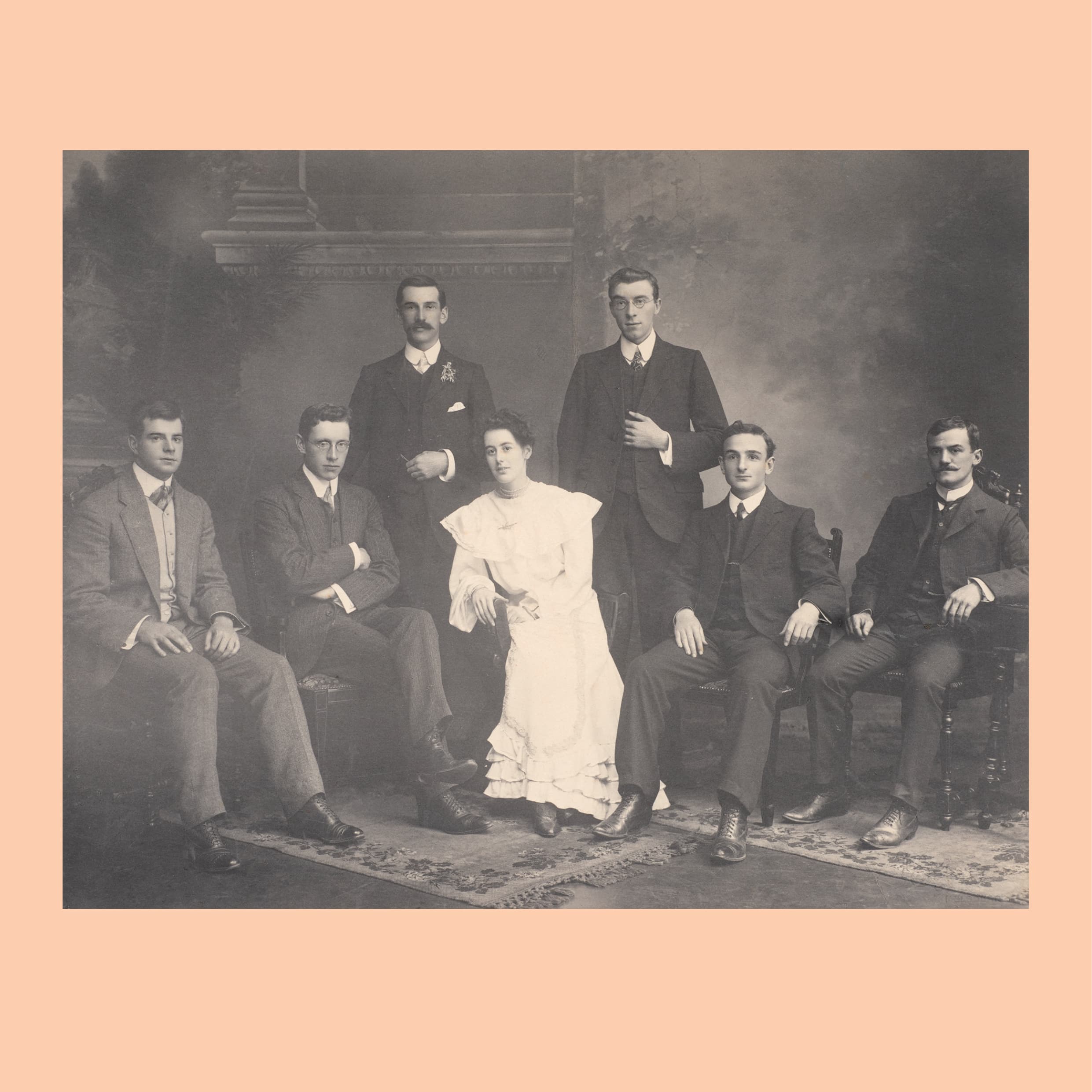
-
A woman dentist in wartime
Dr Martha Burns (1873–1959) was a remarkable pioneer in Australia’s early dental profession. Born in Brisbane of Scottish parents, she began training as a nurse in Brisbane in 1896 and worked in dentistry, after which she sought to obtain a dental qualification in 1907—the first woman in Brisbane to do so. She entered the Australian College of Dentistry (affiliated with the University of Melbourne) after rejection on gender grounds by the Queensland Dental Board and the University of Sydney. She eventually started private practice in Brisbane, and volunteered at the Alexandra Home for Children.
In 1914 Dr Burns set out for the International Dental Congress in London. While she was there, war broke out, and her life took a different direction. She didn’t hesitate to volunteer for military service, but the process was tricky: when she went to enlist, Burns found herself explaining her intent on five occasions, from the kerbside to the lobby! But resilience prevailed, uniforms were obtained, and she was in. Her main role was to receive the wounded and return them to health in a makeshift hospital in Wimeraux, France, and later on the Asturias, a ship based at Saint Nazaire. The 100-staff field hospital often cared for more than 500 patients at a time, serenaded by the sounds of gunfire. Here Dr Burns discovered the benefits of the anaesthetic chloroform, especially when dealing with fractured jaws and shrapnel wounds, tasks that went far beyond her training.
Unfortunately, this exciting and unrelentingly busy posting was cut short (to just three months) by ailing health. Burns was medically discharged and returned to Brisbane, becoming the first Queensland woman to return from the front. She advocated for the Red Cross, later receiving its Long-Service, Jubilee and Coronation medals.
Her dental advocacy included work on the role of mastication, suggesting that dental decay in children was avoidable. She published in The Australian Dental Journal, describing the role of dentistry in wartime, which contributed to the formation of the Australian Army Dental Corps. She was instrumental in organisations including the Brisbane Women’s Club, Women’s Emergency Corps, Queensland Blinded Soldiers’ Association, Brisbane Lyceum Club, and Red Cross Reserve Voluntary Detachment, to name but a few.
Honorary Associate Professor Gelsomina L Borromeo

-
From Brunswick schoolgirl to international philanthropist
Jean Tahija (née Jean Falkner Walters) was born in the inner-Melbourne suburb of East Brunswick in 1916. She attended Methodist Ladies’ College before being accepted to study medicine at the University of Melbourne. She was born into a working-class family, and her father—a policeman—was determined that women should have the same opportunities in life as men, and encouraged her tertiary education. To pay for Jean’s tuition, her mother began a side business, knitting socks from home. Indeed, it was to lighten the financial burden on her family that Jean decided after her first year to change to dentistry, the course being only five years rather than six. To be a woman, of working-class background, pursuing tertiary education, was exceptional at the time—and a significant achievement.
Jean graduated with a degree in dental science in 1941, the only woman in her cohort of 24. In 1942 she went to work as a registrar at the Melbourne Dental Hospital on Spring Street, the only one of her graduating class to do so. She developed a particular skill for extractions, having little other option to treat toothaches and children’s tooth decay in the days before Melbourne’s water fluoridation. In 1942 she was introduced by a family friend to her future husband, Julius Tahija, an Indonesian sergeant of the Royal Netherlands East Indies Army, then stationed in Melbourne. The couple moved to Indonesia in 1947, Jean continuing to practise dentistry in Jakarta, where Julius was a prominent political and business figure. He headed PT Caltex Pacific Indonesia, playing an important role in keeping Caltex operating under both the Sukarno and Suharto regimes.
In 1990 Jean and Julius established the Yayasan Tahija Foundation, to build health, educational, cultural, environmental and social services in Indonesia. Jean also made a generous donation to the University of Melbourne for improved learning facilities; the Jean Falkner Tahija Lecture Theatre is named in her honour. She died in 2001 and is survived by her two sons, George and Sjakon, who continue their parents’ work with the foundation.
Professor Mike Morgan
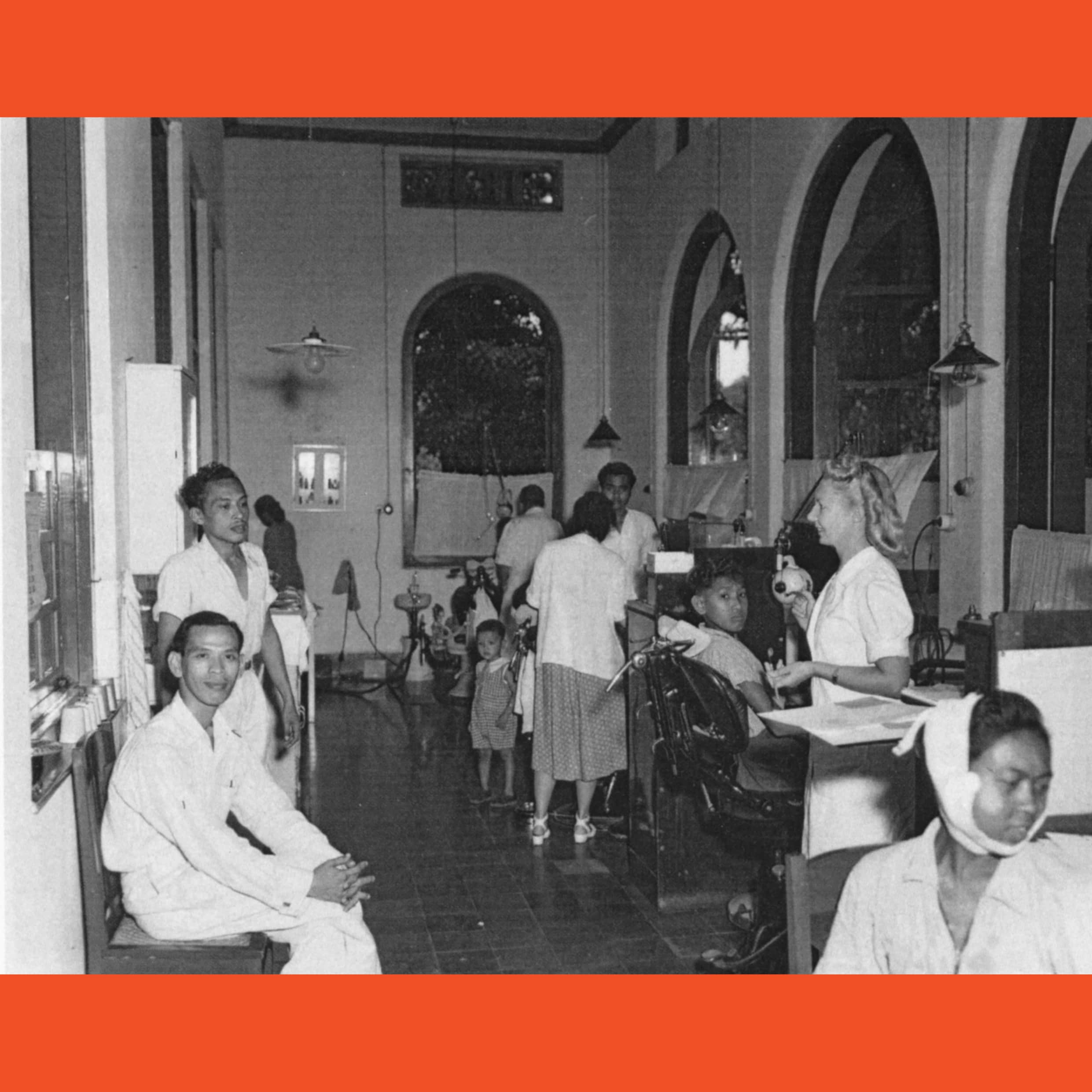
-
Gratitude and generosity
Eve Susan Weiss was born in Vienna in 1926, where she had a happy, comfortable childhood. But in February 1939, Eve, her parents and older sister were forced to flee the Nazi occupation of Austria, arriving by ship in Melbourne seven months later.
After the family had settled in the suburb of Kew, Eve was accepted at Ruyton Girls’ School, with a benevolent offer of waiving her tuition fees. Her parents were told: ‘Pay as much as you can afford’. When Eve received her first pay packet as a dentist, she donated it to Ruyton—a measure of her gratitude and a sign of the generosity that would continue throughout her life.
Eve studied hard, excelled at school and went on to study dentistry at the University of Melbourne, graduating in 1948. The John Iliffe Prize was awarded annually to the top student in each year; Eve was the joint recipient at the end of her fourth year. She was remarkable in achieving so much, having arrived in Australia as a young refugee with little English. She was immensely grateful to her family for the sacrifices they made in supporting her through to university graduation.
While studying, Eve met a newly arrived refugee from Latvia, Jascha (John) Landman, and they married in 1952. She practised as a dentist in the early years of their marriage and until their third child was born. In her fifties, she went back to working part-time with an orthodontist, Dr Charles Renton (‘Ren’) Newbury. She was always pleased when former patients recognised her and thanked her for their perfect smiles—especially the young women whose teeth she had straightened just in time for their wedding photos.
Eve was intelligent, cultured, generous, loyal and loving—and she engendered great loyalty and friendship from everyone who knew her.
After Eve’s death at the age of 90, her meticulous lecture notes were discovered; these were donated, along with other items, to the Medical History Museum and Henry Forman Atkinson Dental Museum. The Eve Landman Scholarship has been established in the Melbourne Dental School in her honour.
Professor Kerry Landman, Ms Sally Landman and Dr Michael Landman
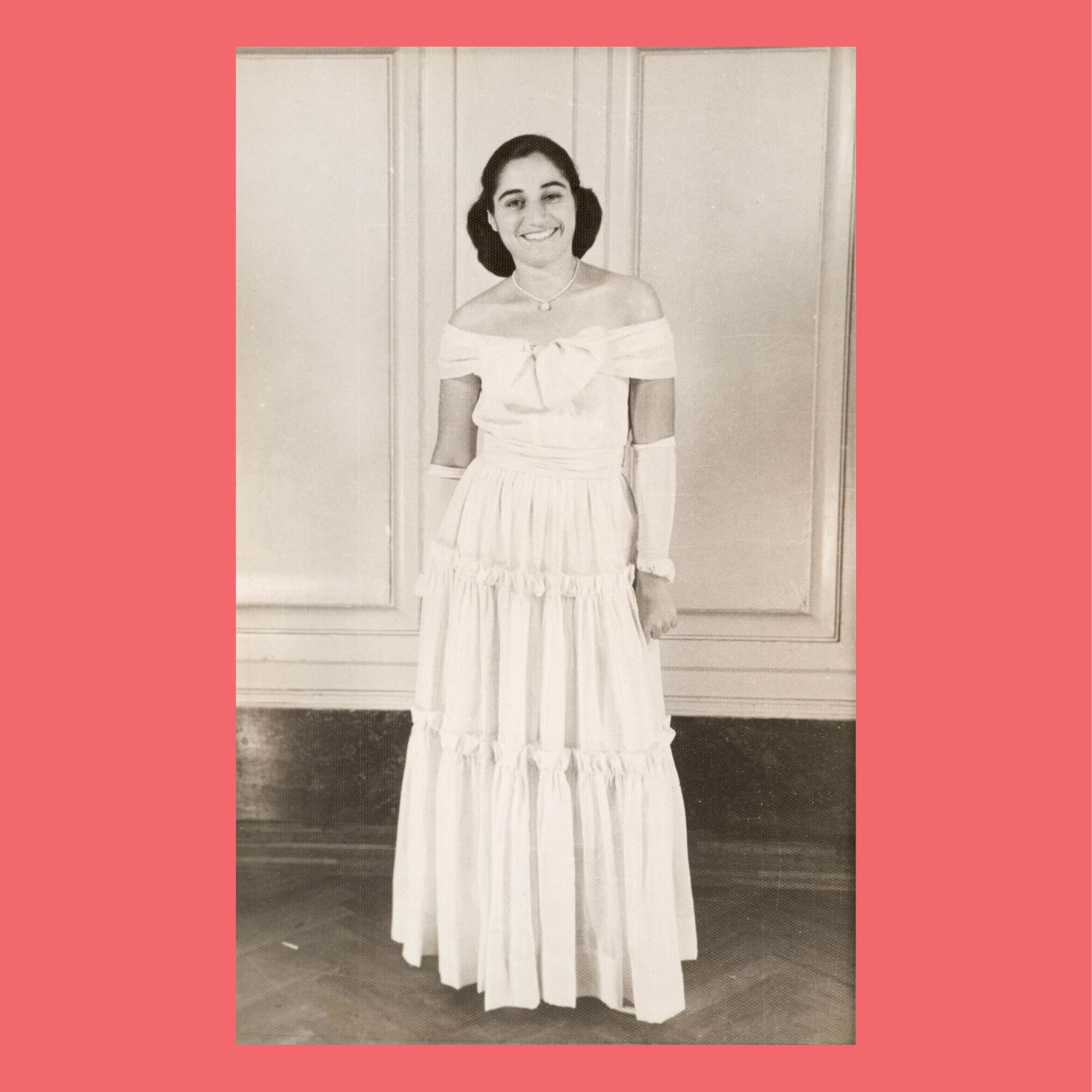
-
Dental cabinet
This old dental cabinet came from the surgery of Drs Bob and Jean Cannon, who bought into the surgery of Dr Bob Walters at 2 Collins Street, Melbourne, in 1958. The cabinet was part of the equipment that came with the practice.
Jean Cannon (née Jean Thomas, 1923–2017) graduated with a Bachelor of Dental Science from the University of Melbourne in 1949, but was not allowed to receive her licentiate in public because she was pregnant. She worked as a dentist for a year or two but found it too difficult to arrange child care. Instead, she studied for a day a week at the Children’s Growth Unit at the University of Melbourne; with the results of her research she later earned a Master of Dental Science, only the third woman in Australia to be awarded this degree and the first to achieve it through research. She went on to study orthodontics in her early fifties and became an orthodontist. She also lectured to students at the Melbourne Dental Hospital for a number of years. After working with several dentists she worked at 2 Collins Street with her husband, Bob.
Bob Cannon OAM (1923–2001) served as a pilot in Australia’s first fighter squadron in World War II. He graduated in dentistry from the University of Melbourne in 1950 and went on to obtain his Master of Dental Science there. In 1959 he was awarded an RSL scholarship to study for his doctorate in Toronto. He took the family with him to Canada, eventually travelling back through Europe before returning to Australia. He continued to do research into dental ceramics while he built up a successful practice, introducing new methods in practising dentistry. He specialised in crown and bridge work, and was a great proponent of preventive dentistry.
Andrew M Cannon AM
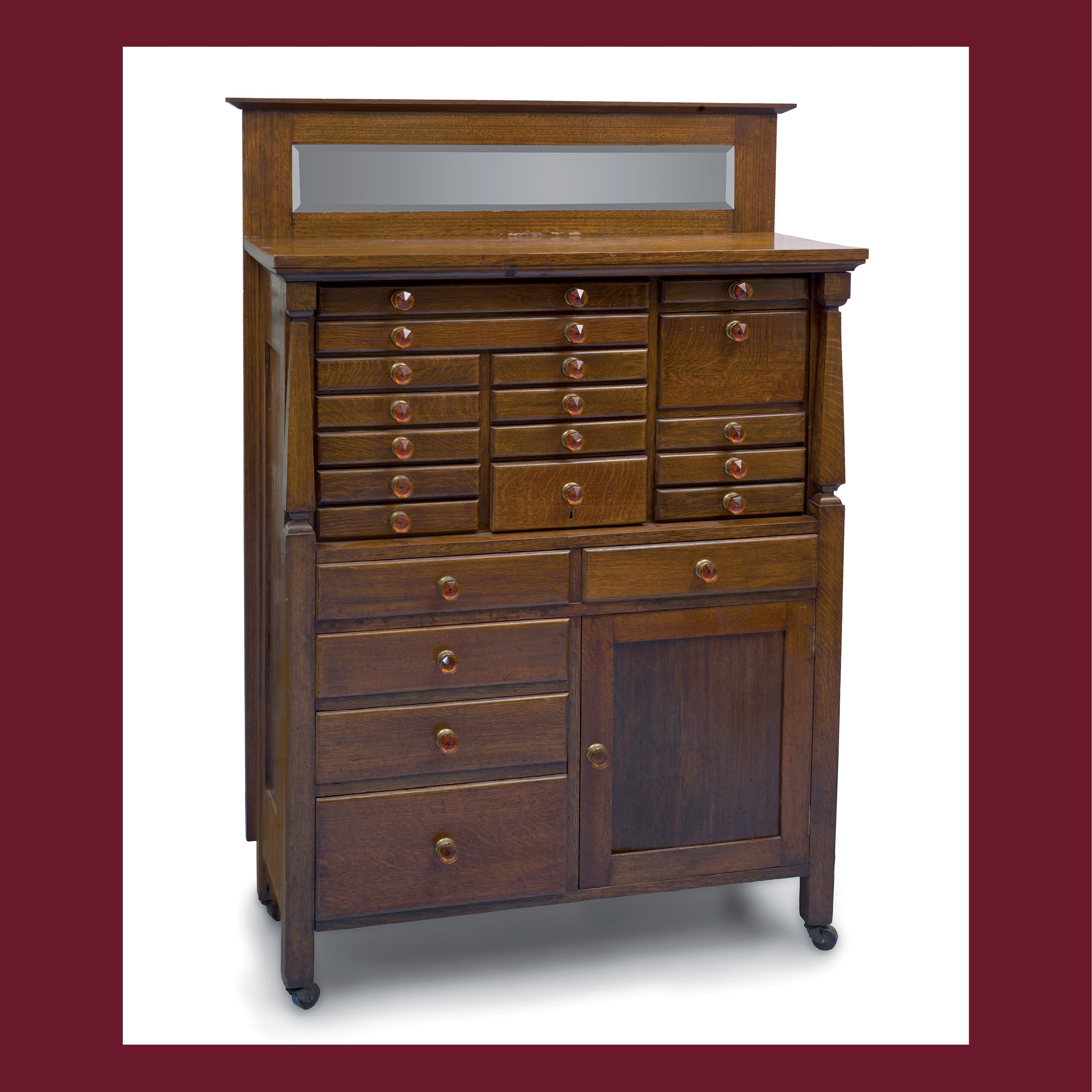
-
An illustrious scholar in paediatric dentistry
Professor Emeritus Louise Brearley Messer AM, BDSc, LDS, MDSc, PhD, GradDipDiv, FICD, FRACDS has had a long and important association with dentistry in Victoria and the Melbourne Dental School. Louise undertook both her LDS and BDSc at the University of Melbourne, completing her studies in 1962. She was among the last class to graduate from the former Melbourne Dental Hospital at 193 Spring Street, and went on to work for the university, joining the conservative dentistry staff.
Louise moved to the United States of America in 1968 to work at the University of Minnesota, where she completed her PhD in nutritional biochemistry in 1988. She held senior academic roles at both Minnesota and the University of British Columbia. During her time at Minnesota she was director of the Post-Doctoral Research Training Program in Dental Caries for the National Institutes of Health.
Returning to Melbourne, she was Elsdon Storey Chair of child dental health from 1990 until 2008, becoming the school’s first female professor, and the director of graduate studies 1996–2008. During these years she also provided expert advice to Victoria’s School Dental Program and chaired the Curriculum Advisory Committee for the Dental Therapy School.
Her illustrious career spans many fields of research. She has published more than 200 papers and supervised the research of more than 80 postgraduate students. She has lectured extensively across the Asia-Pacific and Middle East regions, served on the editorial boards of prestigious journals including Dental Traumatology and Pediatric Dentistry, and is a regular reviewer for many others. Between 2006 and 2015 she had the highest number of citations of published papers, and in 2019 was one of only two people to have four papers listed in the 100 most-cited papers in paediatric dentistry journals.
Professor Louise Brearley Messer’s research into paediatric dentistry has investigated dental growth and development; developmental anomalies; tooth caries, erosion and wear in children; long-term effects of fluoride; and molar incisor hypomineralisation. For her contribution to paediatric dentistry she was awarded the Australian Dental Association Victorian Branch Award for Distinguished Service in 2011, and the following year became a Member of the Order of Australia.
Professor Julie Satur
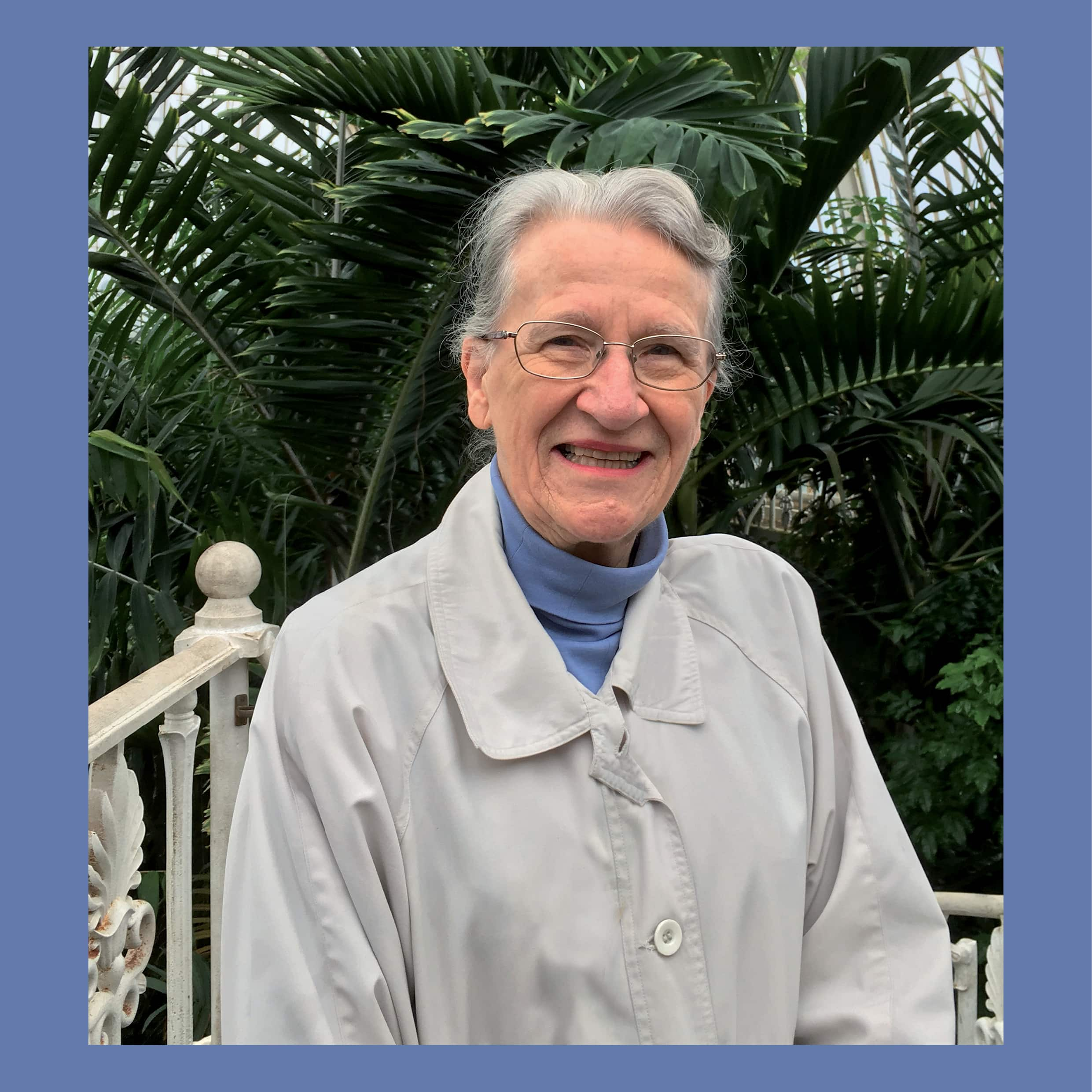
-
Instruments with a colourful history
The letter from Victor Henri De Savary Greene (1887–1954) accompanying a roll of medical instruments that he graciously donated to the Medical History Museum in the 1950s provides an extraordinary window into the world of colonial Australia. Henri goes into some detail about the history of the owners of the instrument roll: his French-Creole grandfather, Captain Emanuel Charles Greene (c. 1796–1857), and father, Octavius Henry Greene (1832–1901).
The letter claims that Emanuel was an aide-de-camp and captain in Napoleon’s Imperial Guard 3rd Chasseurs, and was awarded the Cross of the Légion d’honneur. He used the roll of instruments (which includes an ivory-handled tooth-extraction claw) to treat soldiers on the battlefield. According to various sources, Emanuel himself was wounded in the Battle of Waterloo; he recovered, only to be sent to St Helena with Napoleon and later to be exchanged for a British prisoner. Emanuel was next documented as being in Brazil, but he did not emerge prominently again in records until July 1829, when he arrived in Tasmania as a convict on the Lady Harewood, having been sentenced in England, along with two others, for defrauding a Mr Thompson out of the price of four travelling beds. Emanuel married Charlotte Bolger in 1831 in Hobart. He received a conditional pardon in 1835 in recognition of his role in fighting a calamitous fire in Macquarie Street, and went on to set up a prominent business teaching fencing and dancing.
Emanuel’s son Octavius Henry Greene was born in Hobart in 1832. The family moved to New South Wales and eventually to Victoria, where, according to the letter, Emanuel practised as a surgeon and draftsman while continuing to teach dancing and fencing. Emanuel died in Edward River in 1857. Octavius studied at the Port Phillip Academical Institution. His son’s letter recalls: ‘he used to grow cabbages and blow the hunting horn in Collins St when patients were having teeth extracted. It had the effect of making him clean his own teeth after every meal with a splinter from a paling fence’. Octavius Henry Greene died in the Melbourne suburb of Elwood in 1901, aged 69 years, in possession of his full set of teeth.
Professor Ivan B Darby

-
The art of making dentures
Methods of constructing complete dentures have changed over the decades, but perhaps not as rapidly as other aspects of the management of oral health. Most dental practitioners gradually learned and perfected the art of making dentures over a long career.
This photograph depicts the manufacture of dentures from vulcanite (rubber hardened by a chemical process involving sulphur or other materials, invented by Charles Goodyear of tyre fame). First made in about 1860, vulcanite dentures led to a major reduction in costs for patients. Their disadvantage was the colour of the gums, being dark red rather than pink. But the fit of this new material provided a much better replacement for patients without teeth. In the late 1930s the acrylic denture was introduced. This material is still used today, some eight decades since its introduction.
In the last 30 or 40 years more people are retaining most of their natural teeth. Hence, the emphasis on complete dentures in dental education has also gradually reduced as other forms of treatment and disease management have taken on a more significant role. Nevertheless, there remain populations throughout the world who have a need for full dentures.
More recently, the advent of digital technologies and computer-aided manufacturing is bringing the next revolution in the manufacture of complete dentures. Digital imaging is developing rapidly, enabling dentists to take images of the mouths of patients who do not have teeth, as are technologies that can mimic how the upper and lower jaws are positioned together. Also, technologies are developing that can either make a denture from a solid block of acrylic by 3D-milling, or alternatively 3D-printing is becoming available. As these developments advance it is likely that a new denture might be able to be made in only a few days, or possibly even hours, rather than the six or so weeks previously needed. Such improvements will make cost and time savings for denture construction. The next era of denture manufacture is here, and is exciting for both the dentist and the patient.
Professor Michael F Burrow
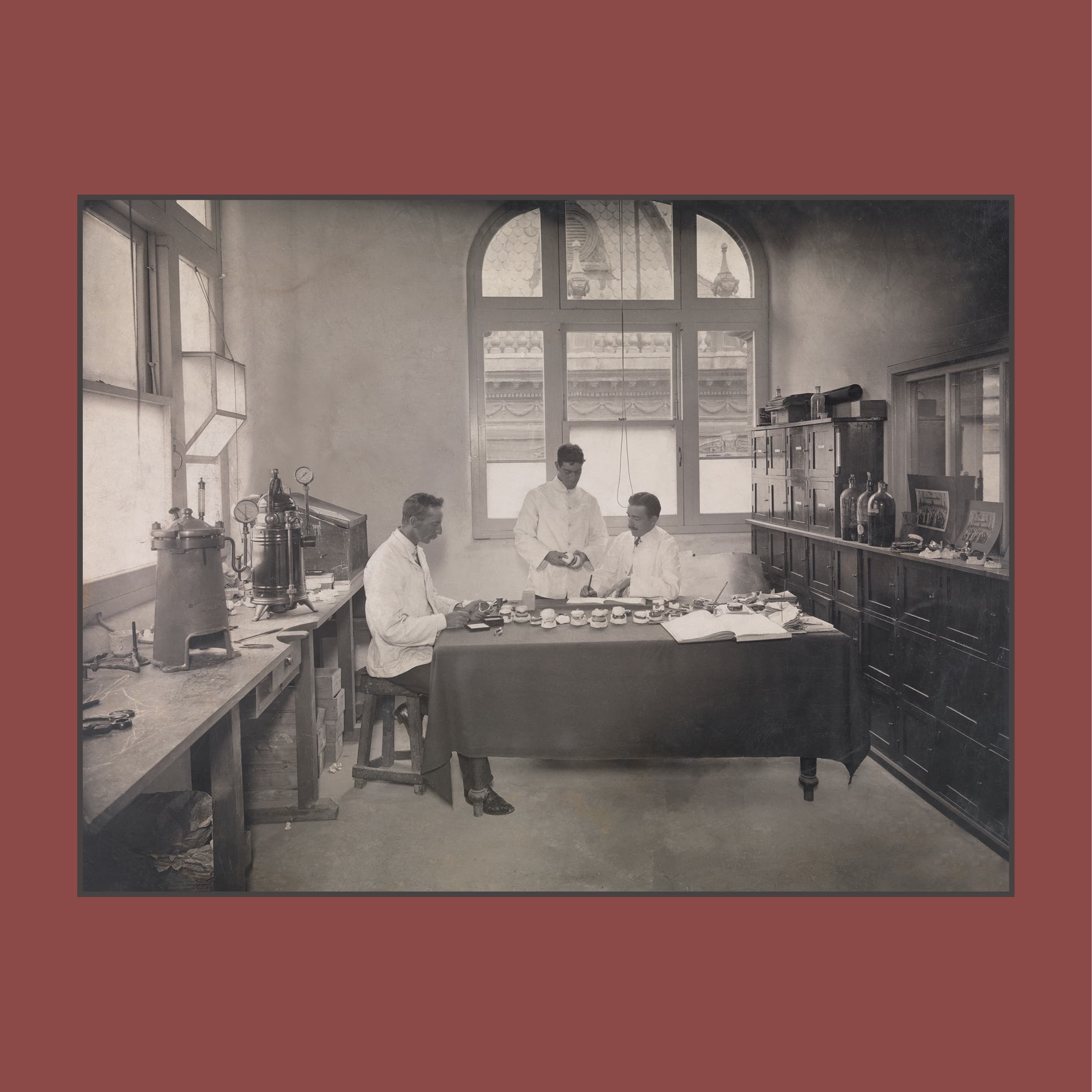
-
High-speed drill
The use of an instrument to help remove the perceived cause of a dental problem (such as worms or humors) goes back millennia. Initially cauteries and hand instruments were used (and still are!). Pierre Fauchard, ‘the father of modern dentistry’, illustrated his version of a refined bow-drill in his 1728 book Le chirurgien dentiste. Later, hand-activated ratchets were used, or a ‘rosehead’—a small, round bur set on the end of a round-handled wooden instrument. In 1864, British dentist George Harrington invented a clockwork dental drill named ‘Erado’ (‘I scrape out’), which was much faster than earlier drills, but also noisy and cumbersome. In 1868, American dentist George Green invented a pneumatic dental drill powered by pedal-operated bellows, and seven years later patented the first electric dental drill. The foot-treadle drill, devised by James Morrison in 1872, attained speeds of up to 2000 rpm and was used in private practice and in wartime in the military. The legendary GV Black also patented a foot engine. By 1914, electric dental drills could reach speeds of up to 3000 rpm and by the 1950–60s the ‘Adroit’ could do the same. Many of us still remember this belt-driven drill with the spherical engine. Later versions attained far higher speeds.
A second wave of rapid development in the 1950–60s brought advances including the air-turbine drill. A pioneer in the more efficient and now ubiquitous high-speed air rotor was John Walsh, a University of Melbourne graduate who became dean of dentistry at the University of Otago. Working with the university’s Department of Physics and with funding from the New Zealand Ministry of Science and Industry, he developed a prototype in 1947 for his Doctorate of Dental Science dissertation. A more refined mechanism later became a commercial success when development funding was provided to American and Swedish researchers, resulting in the Borden ‘Airotor’—the first commercially available air rotor.
Professor Mike Morgan and Dr Jeremy Graham
Reference
V Guerini, The history of dentistry from the most ancient times until the end of the eighteenth century, Philadelphia and New York: Lea & Febiger, 1909.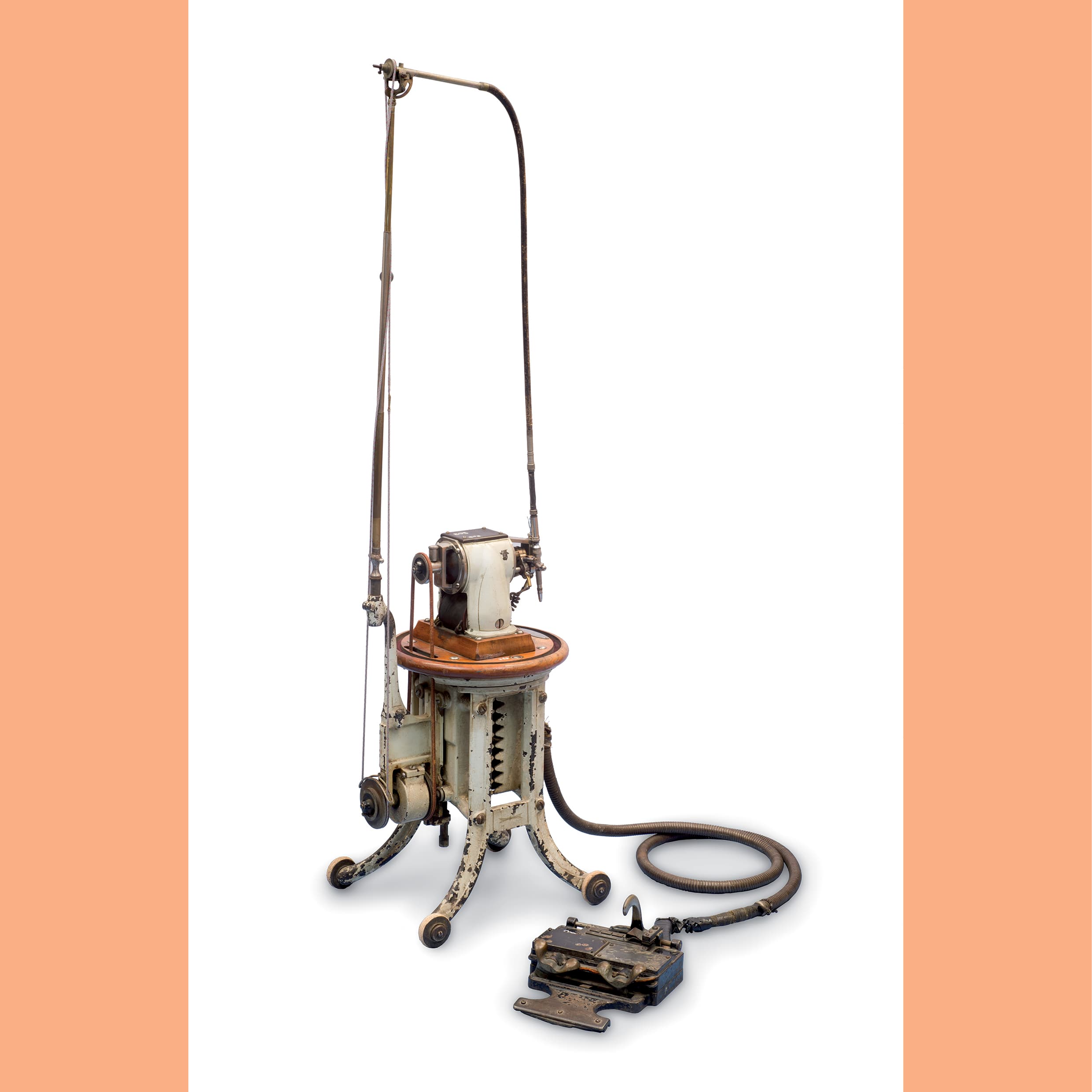
-
Dental chairs
Although the concept of not using a dental chair may seem strange to present-day dentists (and patients), that was indeed the case up to the 18th century. In the 10th century, Albucasis, a leading surgeon from Cordoba, compiled Al-Tasrif, a 30-volume medical encyclopedia, which included his newly designed dental instruments, and instructions for carrying out dental procedures with the patient lying down, resting their head in the dentist’s lap.1 Although depictions of dental charlatans from the 15th to the 17th centuries show hapless patients sitting in a variety of environments with the ‘dentist’ behind them, not until seven centuries after Albucasis did Pierre Fauchard, in Le chirurgien dentiste (1728), recommend that patients sit on a chair, or even on a chaise longue, rather than lying on the floor, the dentist approaching them from behind. The chair was essentially for the benefit of the patient, not the practitioner; early dentists worked standing up.
Early dental chairs were wooden, sometimes with a hand-cranked mechanism. They were replaced by metal ones, with lion-paw feet or a circular pedestal, ornately decorated in black paint with gold relief, a padded head-rest to match the plush red velvet seat for the patient, and a foot-rest—for easy access and for the patient to push against when required. The spittoon and bracket-table may have been attached to the chair, or free-standing, as seen in Mr McIntosh’s surgery of Colac.
The individual chair and its accoutrements were replaced by the ‘pump-up’ hydraulic chair, with a more serviceable black seat and rubber head-rest (to support the occiput), accompanied by a tall, free-standing unit from which a bracket-table (complete with chip syringes and cotton-wool dispenser), lights, spittoon and belt-driven drill—even a fan—emanated like tentacles. This in turn was replaced by space-age looks and technology: smooth lines, triplexes with high-speed evacuation, high- and low-speed drills appearing from nowhere, ultrasonic cleaners, intra-oral cameras, curing lights, and X-ray machines, with or without a spittoon—depending on your taste.
Dr Jeremy Graham
1. A Haloubi and A Kassab, ‘The achievements of Albucasis in the field of oral surgery’, Journal of the International Society for the History of Islamic Medicine, vols 6–7 (2007–08), pp. 12–15.
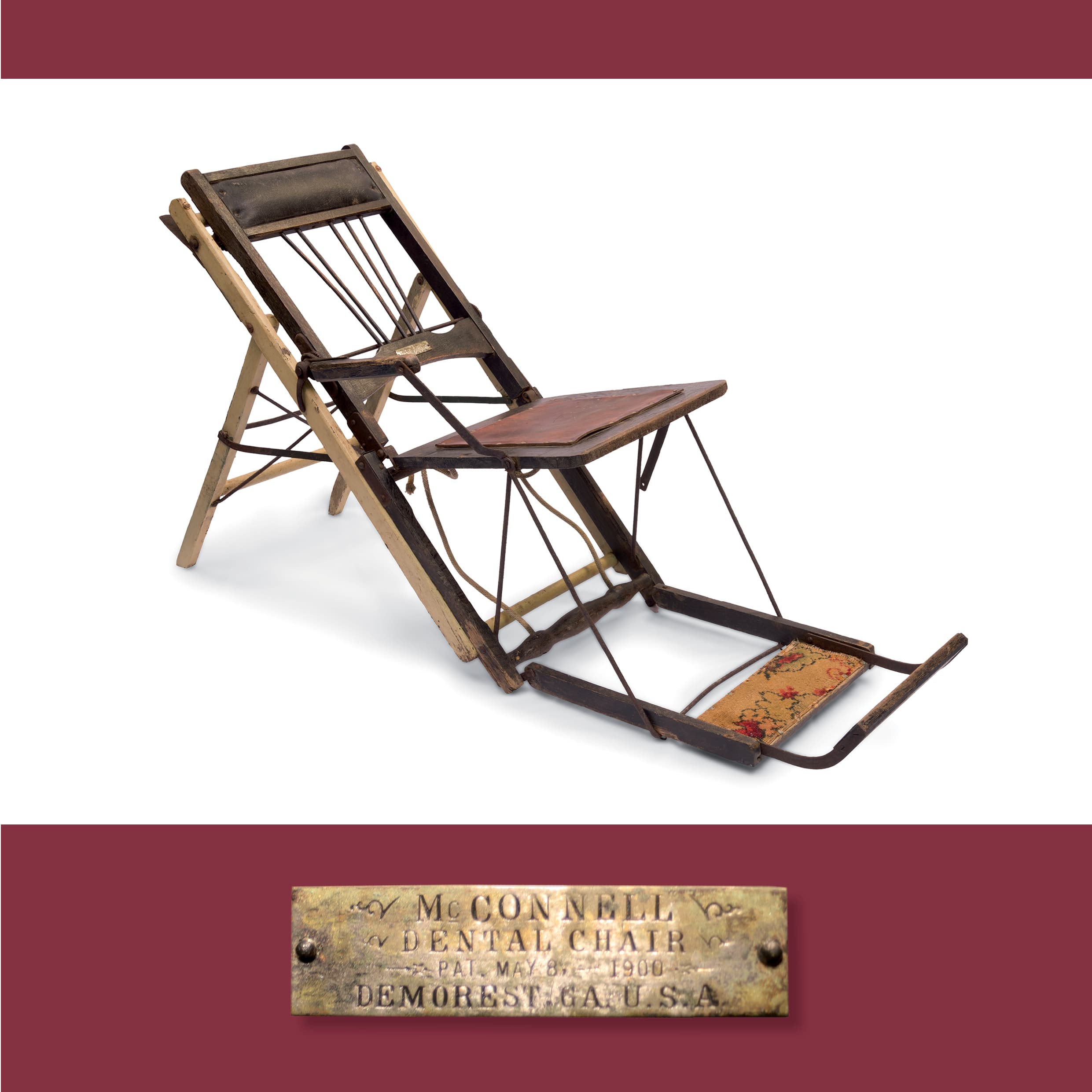
-
Tooth care
Teeth are among the first things we notice about a person’s facial appearance, and for this reason have been part of hygiene routines for millennia.1 The Babylonians and Egyptians used cleaning implements for teeth: toothbrushes were made by fraying the end of a twig, and toothsticks were found alongside their owners in Egyptian tombs. Around 1600 BC, the Chinese made ‘chewing sticks’ from aromatic tree twigs, to freshen breath. Elsewhere, tooth-cleaning sticks called miswaks are still in use in many communities as part of ritual hygiene practices dating back to the prophet Mohammed.
The Chinese are believed to have invented the first bristle toothbrush, made in the 15th century: bristles from the necks of Siberian boars were attached to a bone or bamboo handle. Europeans adapted this design to suit local preferences, often using the softer horsehair, and sometimes feathers. Around 1780, William Addis produced the first of the more modern toothbrushes, using a carved cattle-bone handle and swine bristles; by 1844 this evolved into the three-row bristle brush. Natural bristles were used for the next century or so, until Du Pont invented nylon in the 1930s, enabling the development of the truly modern toothbrush. In the 1950s softer nylon bristles became the norm, in response to market preferences.
Various powders, pastes or gels to clean teeth and sweeten breath have been developed over the years. Earlier versions included ingredients such as crushed eggshells, ashes, sodas and salts, chalk, betel nut, soaps and abrasives. Some Indigenous peoples routinely used charcoal to clean their teeth. Colgate began producing toothpastes commercially in the 1870s. More recent developments include reduced abrasiveness, improved flavour and texture, and increased use of stabilisers, creams and foams (notably sodium laurel sulphate). These pastes carry therapeutic agents that may prevent decay, reduce soft-tissue disease, bleach the teeth, disinfect, kill bacteria, and re-mineralise (like fluorides).
Professor Julie Satur
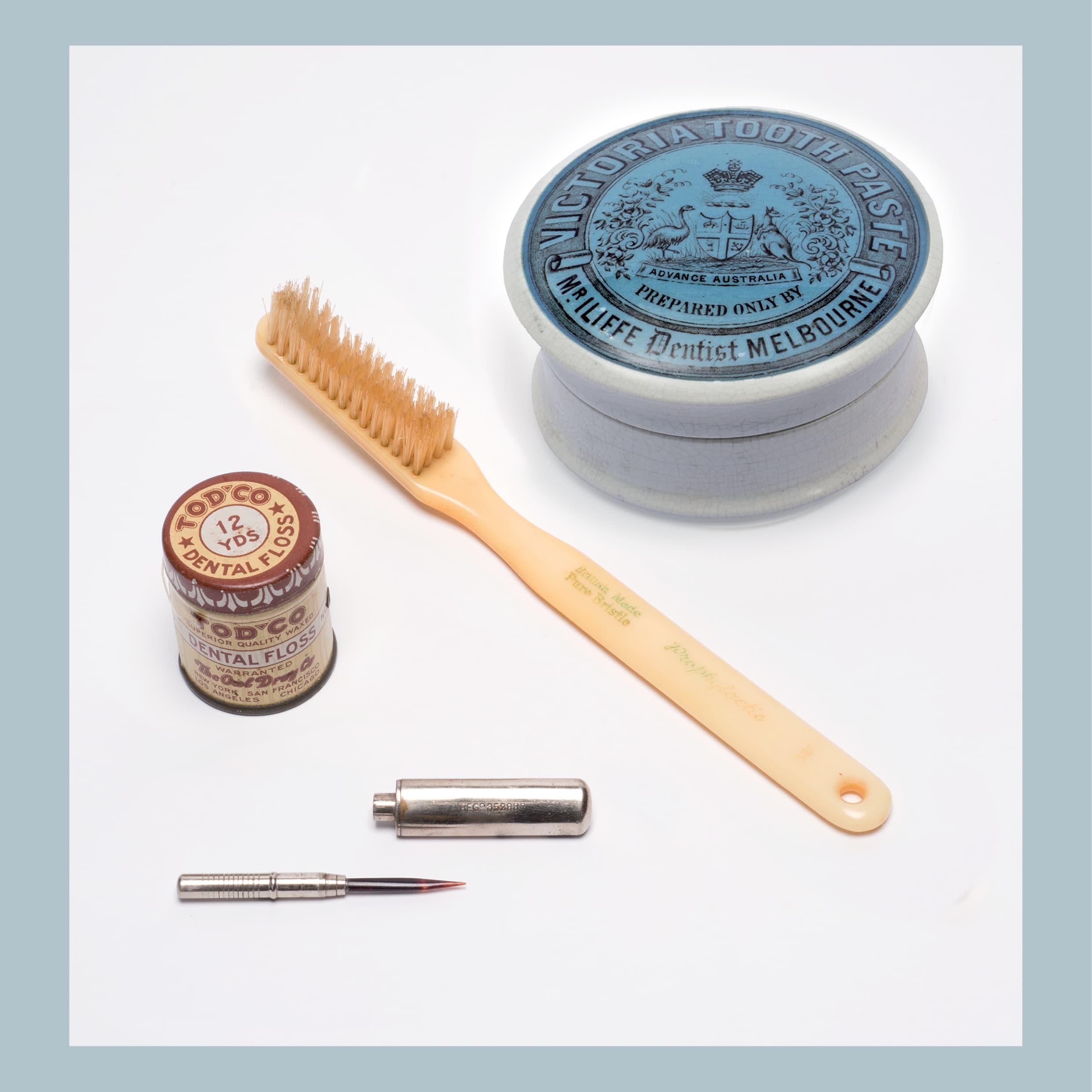
-
Advertising
The modern dental catalogue is an explosion of colour and excitement. It tries to lure dentists, through offers of discounts and claims of scientific superiority, to purchase the latest technology in order to simplify their clinical procedures, make them appear more modern than their competitors, or perhaps even to improve the oral health of their patients. Two items show how much things have changed over the past 150 years.
Plaque control is the cornerstone of prevention in dentistry, with plaque bacteria responsible for dental caries (decay) and periodontal (gum) disease—two of the most prevalent diseases affecting Australians. Encouraging people to brush their teeth regularly continues to play a major role in dental practice. Toothbrushes have evolved from chew-sticks with frayed ends to remove plaque and food debris from around the teeth and gums, to bristle brushes using animal hair in a wood or bone handle, which began to be mass produced by William Addis in England in 1780. The Maw & Son catalogue of 1869 shows a range of toothbrush-head designs and handle options, suggesting that, even then, manufacturers were attempting to segment the market with a specific brush-head and handle to suit different customers. Toothbrush design and marketing have come a long way since, with a move to synthetic bristles, plastic handles and then electric toothbrushes, with each modification designed to remove plaque more efficiently and improve oral health.
The Ritter chair parts catalogue of 1923 demonstrates a functional approach to the dental chair, in stark contrast to the emphasis on patient comfort that epitomises the modern equivalent. Much of today’s marketing of dental chairs focuses on style and colour—aspects absent from the 1923 catalogue. There is also the implication that the 1920s dentist had a central role to play in maintaining their dental chair, being able to order various parts to repair and update it as required. Given the complexity of the modern dental chair, this would be unthinkable today
Associate Professor Matthew Hopcraft
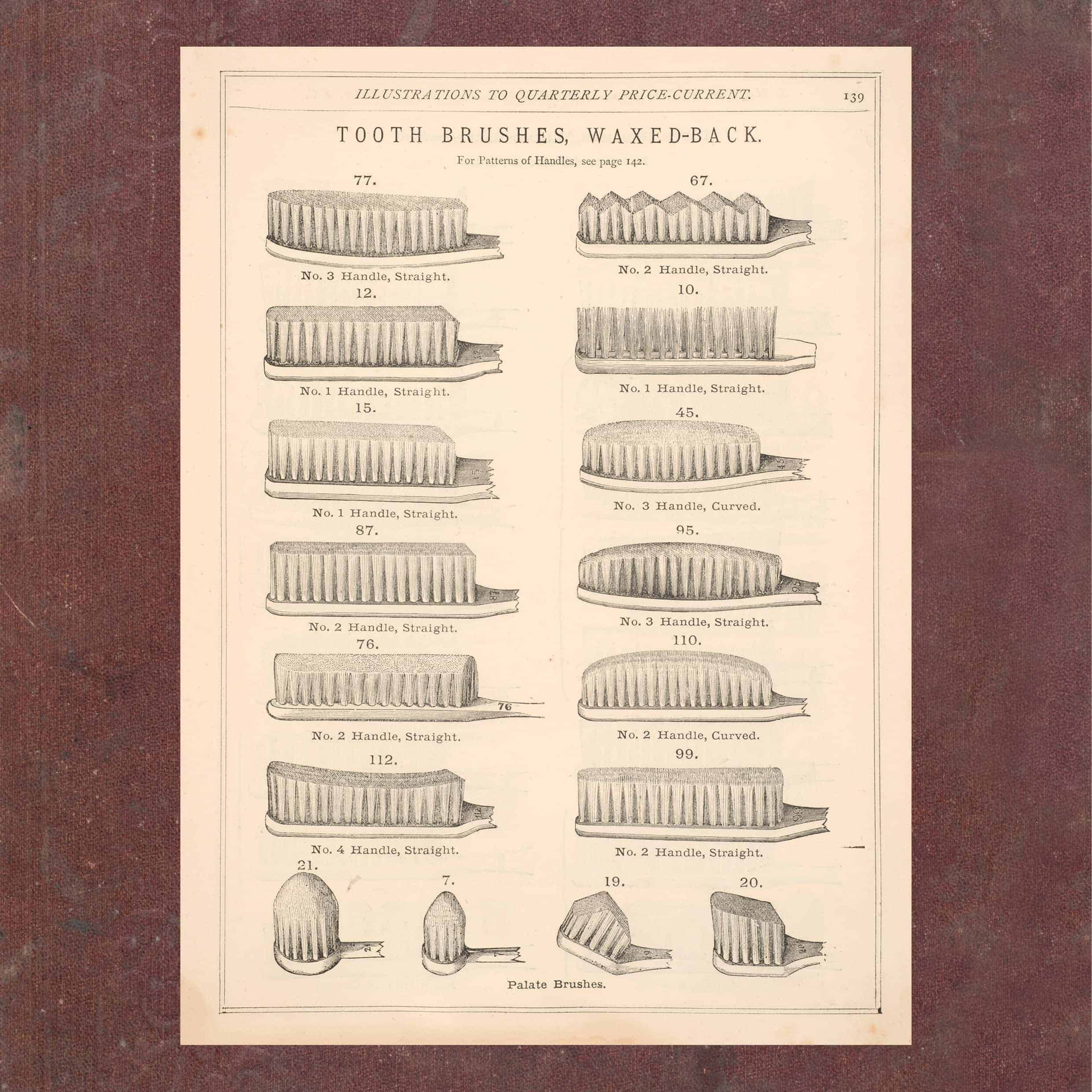
-
Teething
In past centuries teething was believed to be a major cause of child mortality. Various remedies and artefacts claimed to provide relief and even protection against this most serious risk. This example, a teething necklet dating probably from the 1950s, is in mint condition. Made from a black, velvet-like material, with instructions that it be worn ‘day and night’, it is too short to be chewed while being worn around the neck, so any benefits were not derived from chewing or sucking on it. In this sense it resembles amulets used in almost every world culture to avoid the ‘evil eye’.
Teething can cause pain, redness of the gums, fever, and loss of appetite. Although there is no remedy other than symptomatic relief, through the ages several tricks and tools have been invented to help babies (and their exhausted parents) muddle through. Growing up in South America, I was given cochayuyo, an edible seaweed (Durvillaea antarctica), which has been used for centuries by the Mapuche people to soothe their teething guaguas (babies). In the collection are other necklaces made of different materials for babies to chew on, and pain relief medications worn by a parent and made from material safe for a baby to chew. These served as alternatives to teething rings and their never-ending cycle of dropping and cleaning—familiar to parents all over the world.
Another example of teething relief is this beautiful and well-preserved three-in-one item dating from the 19th century. Here the artisan has attached mother-of-pearl to a sterling silver top to make a teether. The silver top bears a floral design, plus a whistle and two little bells. The flowers resemble Hyoscyamus niger, or henbane, long used in traditional herbal medicine for ailments of the bones, rheumatism, and toothache. No doubt the desperate parent hoped that when the rattle and whistle failed to distract their miserable infant, chewing would do the trick, maybe after dipping the tip in sugar or honey (or even rum, according to some accounts). In any case, this elegant pacifier would have made the perfect christening present. After all, it came with all the bells and whistles.
Professor Rodrigo Mariño
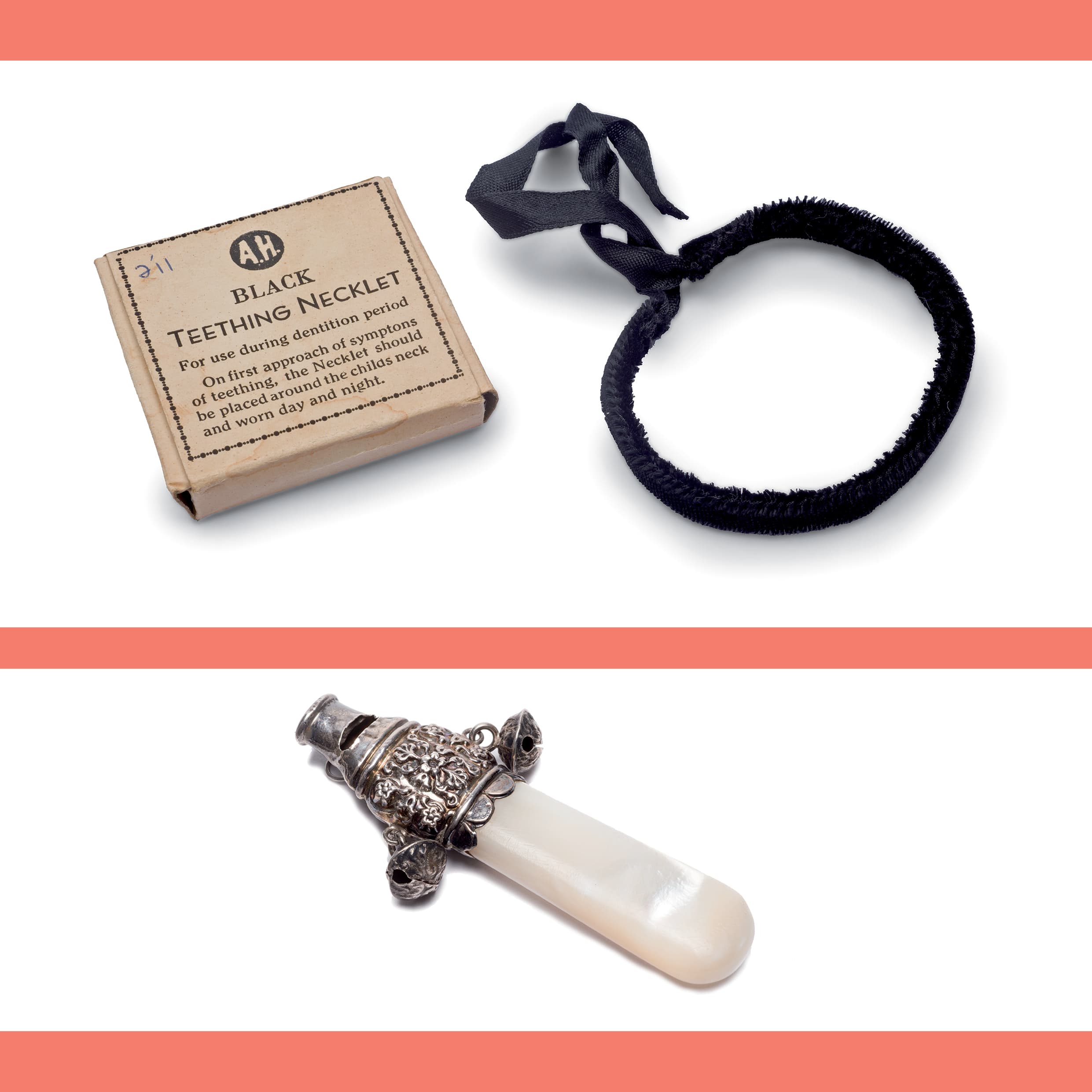
-
Dentistry and anaesthesia
Dentistry and dentists played an important role in the evolution of anaesthesia. Of all surgical procedures in the early 19th century, tooth extraction was by far the most common, and a regular reminder that surgery and pain were inseparable partners.
Although reports of pain relief in surgery appear in early European, Arabic, Chinese and Japanese literature, the herbal concoctions that were used remain obscure to us today, and were likely only partially effective. Operative surgery was a rare event. By the 1840s, three ingredients for successful mitigation of surgical pain had been available for some time: ether had been known since the 16th century; nitrous oxide had been described by Joseph Priestley in 1773; and chloroform was prepared independently by three different scientists in the 1830s. All had been observed to cause unconsciousness, but no-one saw the possibilities.
The first recorded clinical use of ether anaesthesia took place in Rochester, New York, when medical student William Clarke administered ether to ‘Miss Hobbie’, the sister of a fellow student, while the dentist Elijah Pope extracted her painful tooth. The anaesthetic’s effects were dismissed by Clarke’s preceptor, Professor Moore, as likely to be merely a hysterical reaction in a young lady, and Clarke did not repeat the event.
In 1844 another dentist, Horace Wells of Hartford in Connecticut, decided to experiment with nitrous oxide, or ‘laughing gas’, after observing its use by Gardner Colton, a travelling medical student–showman, for amusing the townsfolk. Having noticed a volunteer fail to respond to a painful gash while under the influence of the gas, Wells had his own tooth painlessly removed by a colleague after inhaling some. He continued to use nitrous oxide successfully in his practice and soon sought an opportunity to demonstrate its efficacy to the surgeons of Boston. His demonstration failed, as the medical student who submitted himself for the experiment cried out during the extraction, despite later acknowledging that he had felt no pain. Two years passed before another dentist, Wells’ former pupil William Morton, took the advice of a Boston chemist and experimented with ether on his students. On 30 September 1846, Eben Frost appeared at Morton’s door with excruciating toothache, pleading: ‘Can’t you mesmerise me?’ Morton replied, ‘I have something better’, and proceeded to apply ether on a handkerchief, before removing the tooth, while Frost ‘made neither sign nor sound but remained immobile’. The success led to another request to the surgeons at Boston’s Massachusetts General Hospital for an opportunity to demonstrate painless surgery. Gilbert Abbott submitted to the removal of a tumour under the jaw by chief surgeon John Warren, with Morton administering the ether. The success of that demonstration, on 16 October 1846, led to news of anaesthesia spreading around the globe.
The news and subsequent adoption of anaesthesia spread most prolifically after a letter from Jacob Bigelow to his surgical colleague and friend Francis Boott in London arrived on 16 December: ‘I send you an account of a new anodyne process lately introduced here, which promises to be one of the important discoveries of the present age. It has rendered many patients insensible to pain’. Boott wasted no time and, together with London dentist James Robinson, performed a tooth extraction under ether on 19 December. Two days later, the renowned surgeon Robert Liston performed a painless amputation using ether.
When news of ether anaesthesia arrived in Australia, it came from England, firstly in a short article in Bell’s Messenger, and then in more detail in the 9 January 1847 issue of The Illustrated London News. The journey of some 100 days meant that the latter report arrived in late May. The first use of ether in Australia took place on 7 June 1847, in both Sydney and Launceston. In Sydney dentist John Belisario and in Launceston surgeon James Pugh—both copying the apparatus shown in The Illustrated London News—successfully administered ether anaesthesia.
Dr Rod Westhorpe OAM
Attachment Size Rod Westhorpe.pdf
270 KB 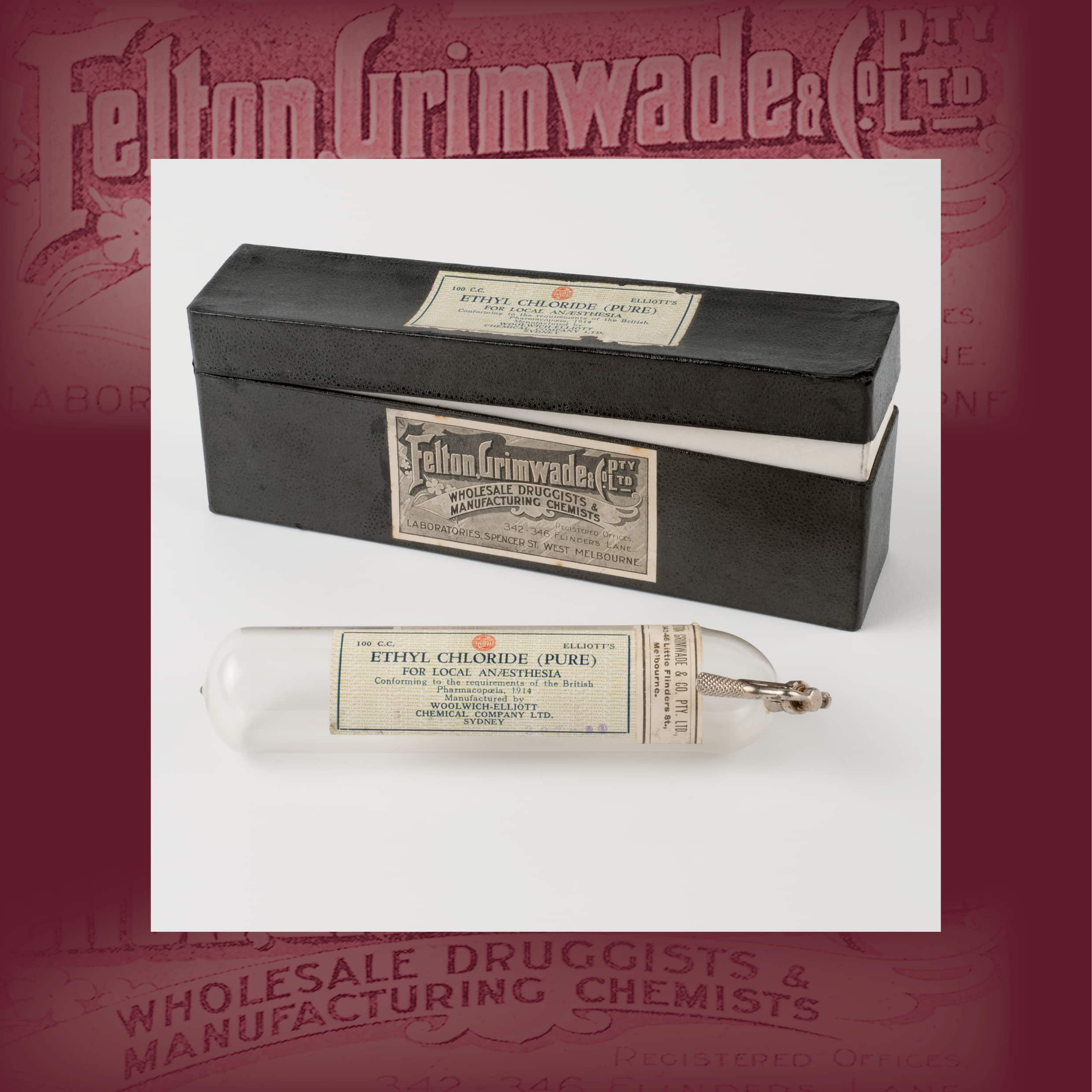
-
A pioneer in anaesthesia
Born in Melbourne and schooled in England, Geoffrey Kaye (1903–1986) studied medicine at the University of Melbourne, graduating in 1926. In the following year, he decided to specialise in anaesthesia, becoming the second full-time specialist anaesthetist in Australia.
Kaye’s enthusiasm for research, teaching and organisation cemented his place as a major contributor to the development of anaesthesia as a specialty in Australia. Soon after being appointed as honorary assistant anaesthetist to the Alfred Hospital in 1929, he visited the major anaesthesia centres in Great Britain, Europe and North America, and thereafter maintained close contact with prominent international anaesthesia researchers. He was one of the first in the world to examine the causes of mortality during anaesthesia, and he encouraged the application of science to what hitherto had been regarded as a part-time activity by general practitioners. He arranged and edited the first Australian anaesthesia textbook, Practical anaesthesia (1932), and was co-author of the second, Anaesthetic methods (1946). The latter was highly sought after as a practical guide for both specialists and non-specialists.
At the 1934 Australasian Medical Congress, Kaye convened a meeting of six prominent Australian anaesthetists, and so established the Australian Society of Anaesthetists, taking on the job of secretary. In 1937 he began a long association with the University of Melbourne as lecturer and instructor in anaesthesia to the medical and dental schools.
As an accomplished engineer, Kaye was able to develop and modify anaesthesia equipment, and also to cleverly section apparatus for use as teaching models. He was instrumental in designing equipment for wartime use in the field. After serving in the Middle East and Australia, in 1946 he returned to his teaching role, with newly allocated space for a library and museum. At the same time, the university introduced a Diploma in Anaesthetics, a forerunner of the specialist training program established under the auspices of the Royal Australasian College of Surgeons in 1952.
Kaye was an avid collector of anaesthesia apparatus, and of Georgian glassware and Asian porcelain. His anaesthesia collection forms the core of the Geoffrey Kaye Museum of Anaesthetic History at the Australian and New Zealand College of Anaesthetists in Melbourne.
Dr Rod Westhorpe OAM
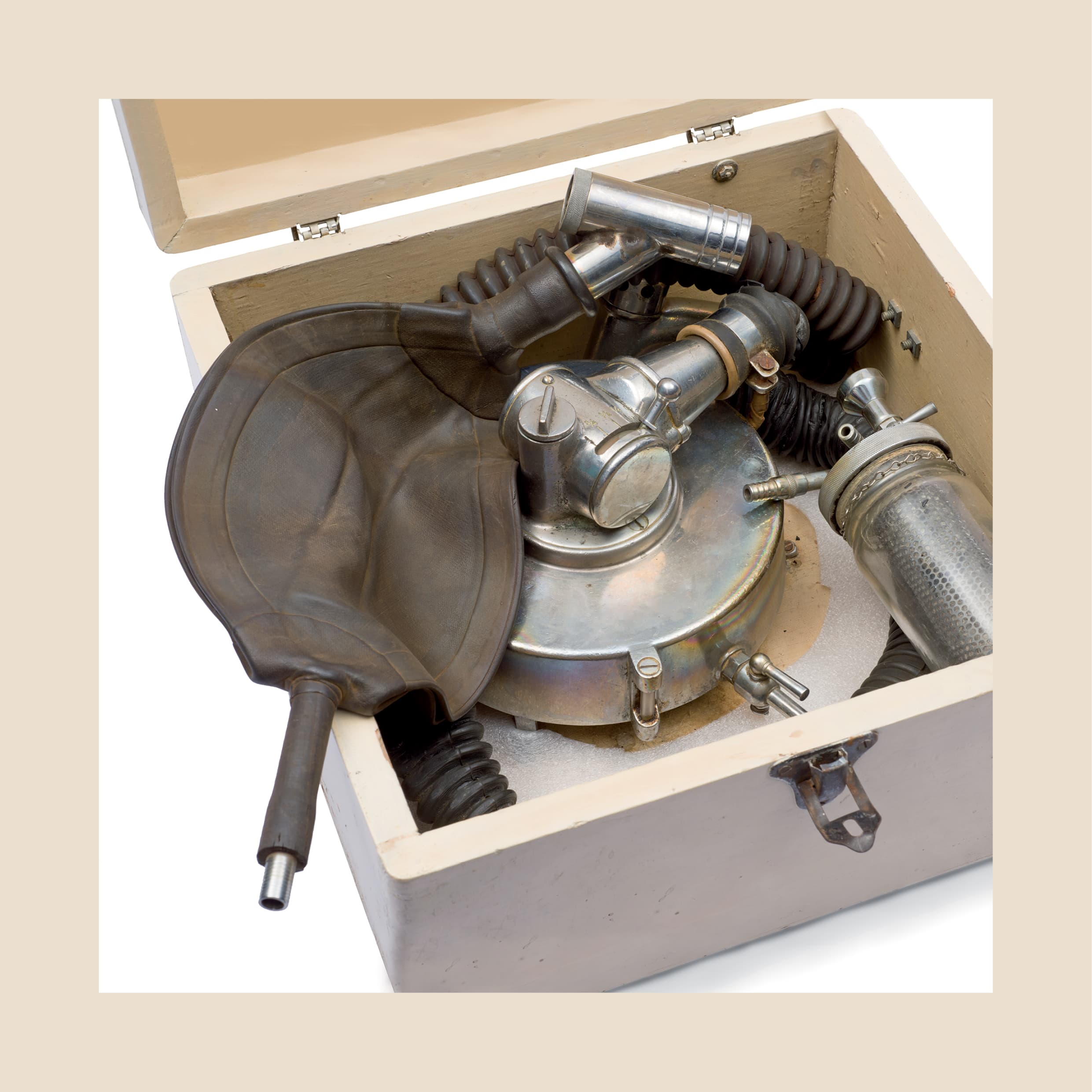
-
Managing decay: From extractions to prevention
Dental care, like medical care, has evolved over time. It is fair to say that, until the turn of the 20th century, the predominating form of treatment of dental disease (the most common being dental decay) was the removal (extraction) of teeth. In fact, with the advent of local anaesthesia (together with improved materials to make dentures), tooth removal, while certainly destructive, was an easy way to enable people to eat and chew food and also present an acceptable smile, without unattractive cavities in their front teeth. This approach to care became very popular, and there are stories from the early 20th century of young women about to marry having all their teeth removed, to be replaced by dentures paid for by their parents, to avoid the new husband having to devote precious funds to expensive dental care. Similarly, full dentures (preceded by removal of all teeth) became a popular 21st-birthday gift.
During World War I, the armed forces recognised that replacing the teeth with full dentures was the most efficient way to render fighting men ‘dentally fit’. Fortunately, with better understanding of disease processes and the rapid development of dental materials, repairing the effects of dental decay became the treatment of choice, followed by prevention of disease initiation.
For almost 100 years the ‘repair’ (restoration) of teeth affected by dental decay (caries) was dominated by the teachings of Dr GV Black (1835–1915), as embodied in his 1908 text A work on operative dentistry in two volumes. The dentist would remove the decay and place a restoration (‘filling’) of dental amalgam, which was the main material used at the time, and is still in use today.
Professor Mike Morgan, Professor Martin J Tyas AM and Dr Margaret A Stacey
Attachment Size Morgan+Tyas+Stacy.pdf
220 KB 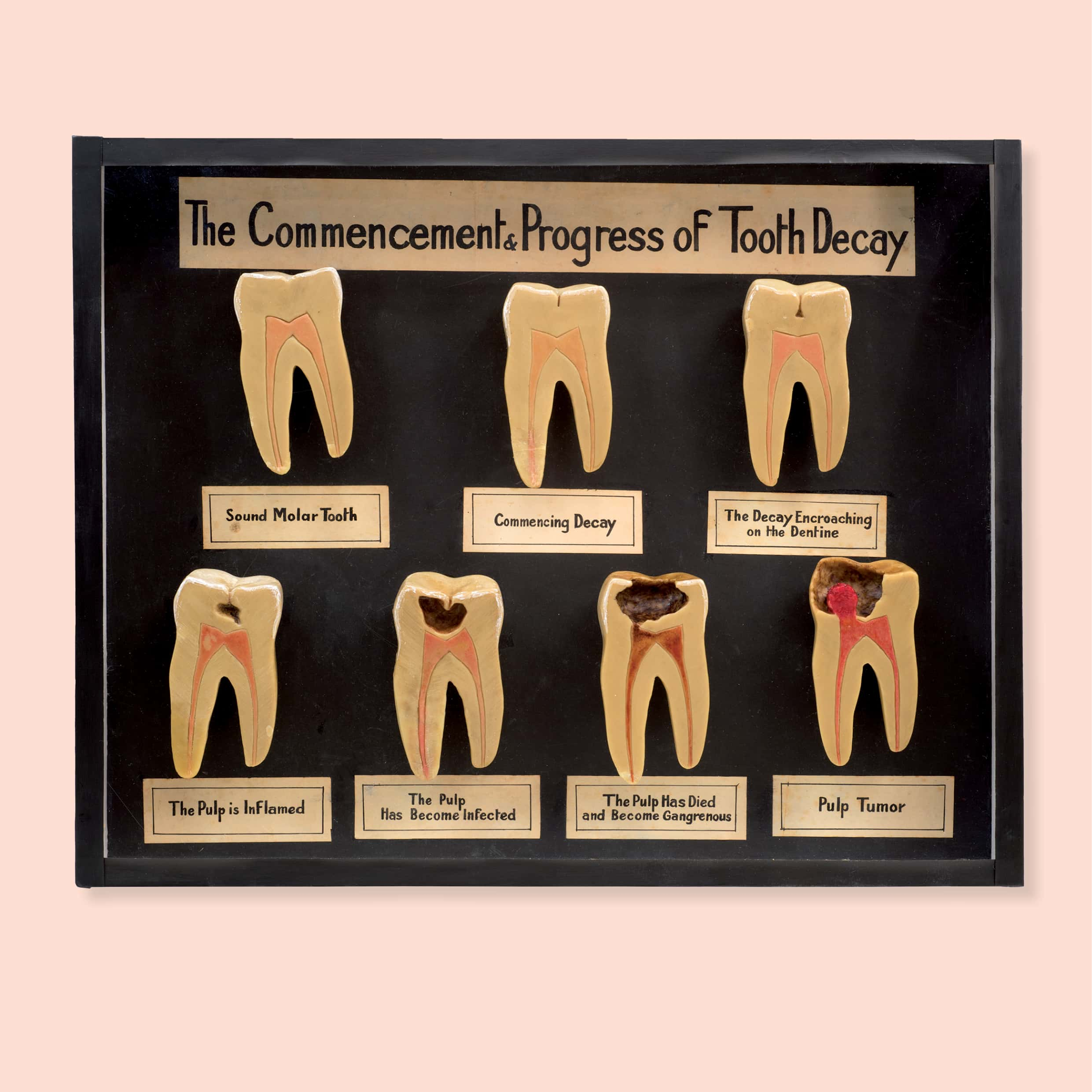
-
The Navy dentist: A dignified position
In the close confines of a ship at sea, certain positions have their own sobriquets, including the Dental Officer: ‘Fang-Bosun’, ‘Toothy’, sometimes just ‘Dentist’. But these nicknames are always used with a certain respect—even a tinge of affection. Australian Dental Officers (DO) have been in uniform since 1918, conspicuous by the burnt-orange colouring between their gold rings.
Since its formation in 1911, the Royal Australian Navy (RAN) recognised the importance of dental health in its serving members, and it paid civilian dentists to treat them, either in their own practices or in shore establishments in Victoria and New South Wales. In the early years of World War I, Australian sailors were treated by Royal Navy sources when available. But in December 1917, with enlistments increasing, the position of Surgeon Dentist was advertised for service afloat in the RAN, at a salary of £365 per annum. Honorary Lieutenant Milton Atwill (1888–1965), a Dental Officer in the Australian Army Medical Corps, was selected from the 26 applications received. He was appointed on 8 April 1918, posted to Garden Island in Sydney and then to HMAS Cerberus to await passage to the UK, joining Australia (I) in July. Although his tenure was short, ‘paying off’ in September 1919, Atwill’s foresight in suggesting that the RAN create a structured Dental Branch, with the DOs supported by Dental Assistants and Dental Mechanics, was prescient.
The number of DOs steadily increased in the inter-war years, eventually having enough to warrant a Surgeon Commander (Dental) in charge of the Dental Branch, much as it is in 2020. With the onset and progress of World War II, the Dental Branch grew. In general the RAN’s larger ships, such as cruisers, carried DOs, while forward bases and the smaller fleet units, such as destroyers and frigates, were served by travelling DOs
They serve afloat and ashore, still in the manner described in the editorial of The Commonwealth Dental Review of May 1918: ‘taken on the whole then the position of Dentist in the Royal Australian Navy is a dignified one and one which the profession as a whole will be pleased to know has been established’.
Dr Jeremy Graham
More information

-
Strong teeth, strong soldiers
Before World War I there was no dental service in the Australian Army. The first Australian Imperial Force (AIF) contingent was sent to Egypt without accompanying military dental support—contrary to the advice of the Australian dental associations. Many AIF recruits were given dental treatment before they departed, through the volunteerism of the dental profession and the requisitioning of dental hospitals in each state. In Melbourne, the effort to make the departing troops dentally fit was overseen by the Recruits Dental Relief Committee, which included former prime minister Alfred Deakin, newspaper proprietor Geoffrey Syme, registrar of the Dental Board Ernest Joske, and acting dean of the University of Melbourne’s Faculty of Dental Science, Thomas FW Hall. Major Hall was appointed Senior Dental Officer for Victoria and was later promoted to Principal Dental Officer, responsible for organising dental services throughout the Commonwealth of Australia.1…
The 23rd of April 1943 was a historic day for Australian Army dentistry, with the creation of a professionally autonomous dental service to improve the quality of service to our troops, and thus the AADC was separated from the Australian Army Medical Corps.2 By the end of this war, 435 Dental Officers had served with the Australian Army. Dr Gordon Rowell, president of the Australian Dental Association, noted:
… the War created camaraderie within the dental profession among individual dentists both within and outside the Services. Dentists came to regard their former ‘opposition’ as their ‘colleagues’ and thus developed a new sense of professional maturity so sadly lacking in the pre-war days.
In 1948 the Dental Corps was granted a royal charter for its service in World War II, and has gone on to provide services in war, peacekeeping and humanitarian deployments. Since 1945, Royal Australian Army Dental Corps personnel have served Australia with distinction around the world, including in Japan, Korea, Malaysia, Vietnam, Iraq, Somalia, Rwanda, New Guinea, Bougainville, East Timor and Afghanistan.
Colonel Robert Adams
More information
1 S Kuusk, Fang farriers: Australian Army dentistry in war and peace; A history of the Royal Australian Army Dental Corps. Volume 1, 1914–1939, Adelaide: Openbook Howden, 2015.
2 V Bird, ‘Director’s message’, Cadmus: The Magazine of the Royal Australian Army Dental Corps, 12th edn, 1993, p. 5.
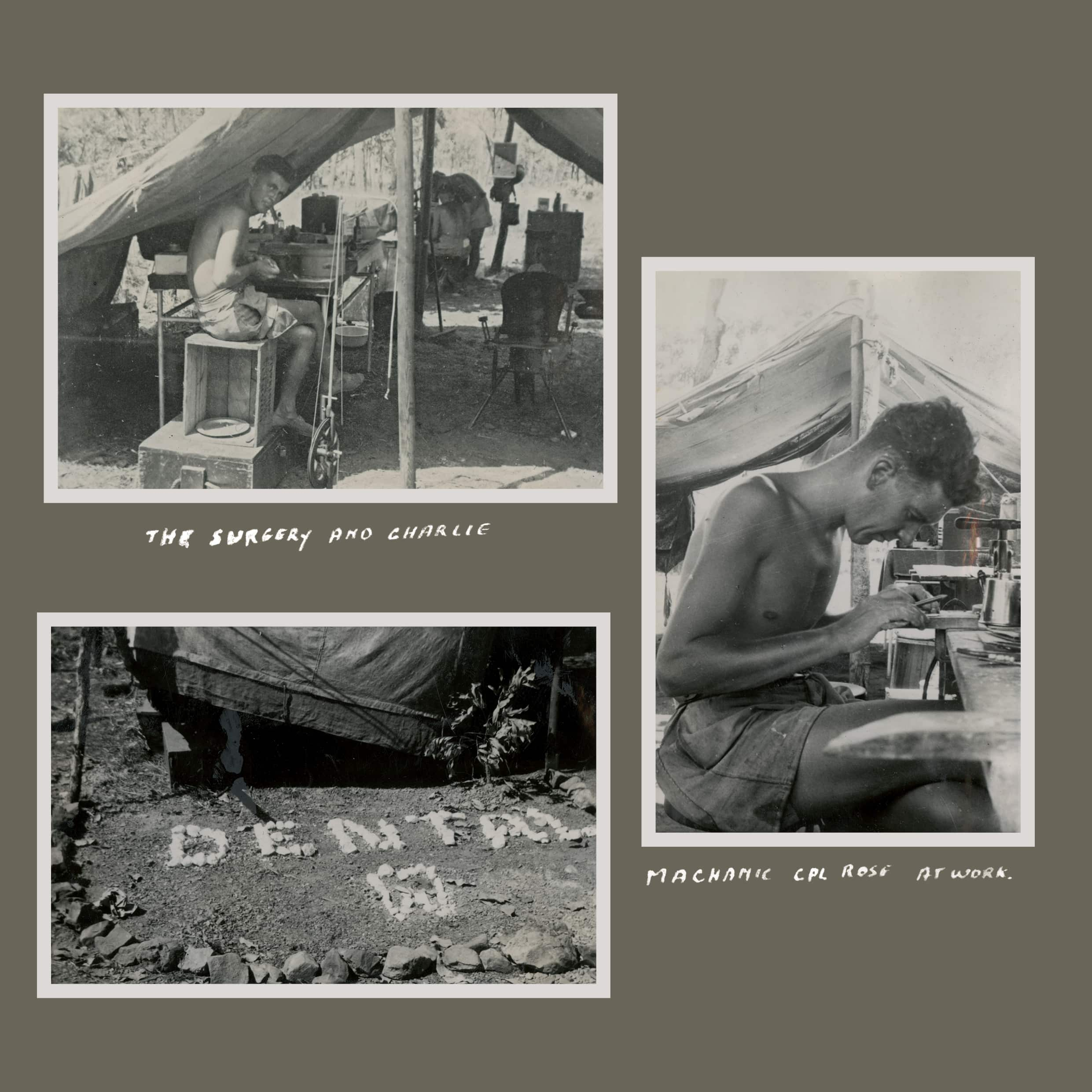
-
Dental Services in the Air Force
Military aviation in Australia started at Point Cook in Victoria in 1912 with the establishment of the Central Flying School (CFS). Australia was the first British dominion to develop an aviation corps after this had been recommended by the Imperial Conference in London in 1911. By 1914 it was known as the Australian Flying Corps (AFC). As with the Royal Flying Corps (RFC) in Britain, the AFC was a part of the Army, and dental care for its members was provided initially by the Australian Army Dental Service.1
The Royal Australian Air Force (RAAF) was formed in 1921. Six years later a dental clinic was established at the CFS at RAAF Base Point Cook, and a Dental Officer with the rank of Flying Officer was appointed. He was also responsible for treating personnel at the RAAF Base Laverton and at Air Force Headquarters at Victoria Barracks in Melbourne. In 1937 there were only three uniformed RAAF Dental Officers, but with the rapid growth of the RAAF in World War II this number increased from five in 1939 to 227 in 1945, with concomitant increases in Dental Orderlies (assistants) and Dental Mechanics (technicians).
The wartime structure of the RAAF Dental Branch was the result of the energy and intellect of one man: Norman Henry Andrews LDS(Vic), BDSc(Melb), DDSc(Melb). Initially the RAAF Dental Branch was administered by the Director of Medical Services (Air), a position under the control of Army medical staff. In April 1940 the RAAF Medical Service separated from the Army. Andrews, the second uniformed RAAF Dental Officer, had enlisted in 1933 and in 1943 became the RAAF’s first Director of Dental Services. He established new dental centres at major bases, created mobile and transportable dental units, and encouraged the professional development of all personnel by starting a journal and arranging lectures by visiting experts. The aim was to make personnel dentally fit in base areas and to keep them fit in forward areas. This required RAAF dental units to be deployed to northern Australia, New Guinea, the United Kingdom, the Middle East and Africa…Dental Officers have continued to serve in Australia and overseas, as members of the Permanent Air Force and of the Specialist Reserve, until the present day.
Air Commodore Rowan D Story AM, RFD
1 Sources for this essay include History of the RAAF Dental Branch, www.defence.gov.au/health/about/docs/RAAFDental.pdf
(viewed 26 November 2019).
2 AS Walker, Clinical problems of war, Australia in the War of 1939–1945; Series 5: Medical, vol. 1, Canberra: Australian War
Memorial, 1952, pp. 554–66; 617–18.
3 TH Clouston and FA Walker, ‘The Clouston-Walker splint for pin fixation’, British Dental Journal, vol. 74 (1943), pp. 147–52.
More information
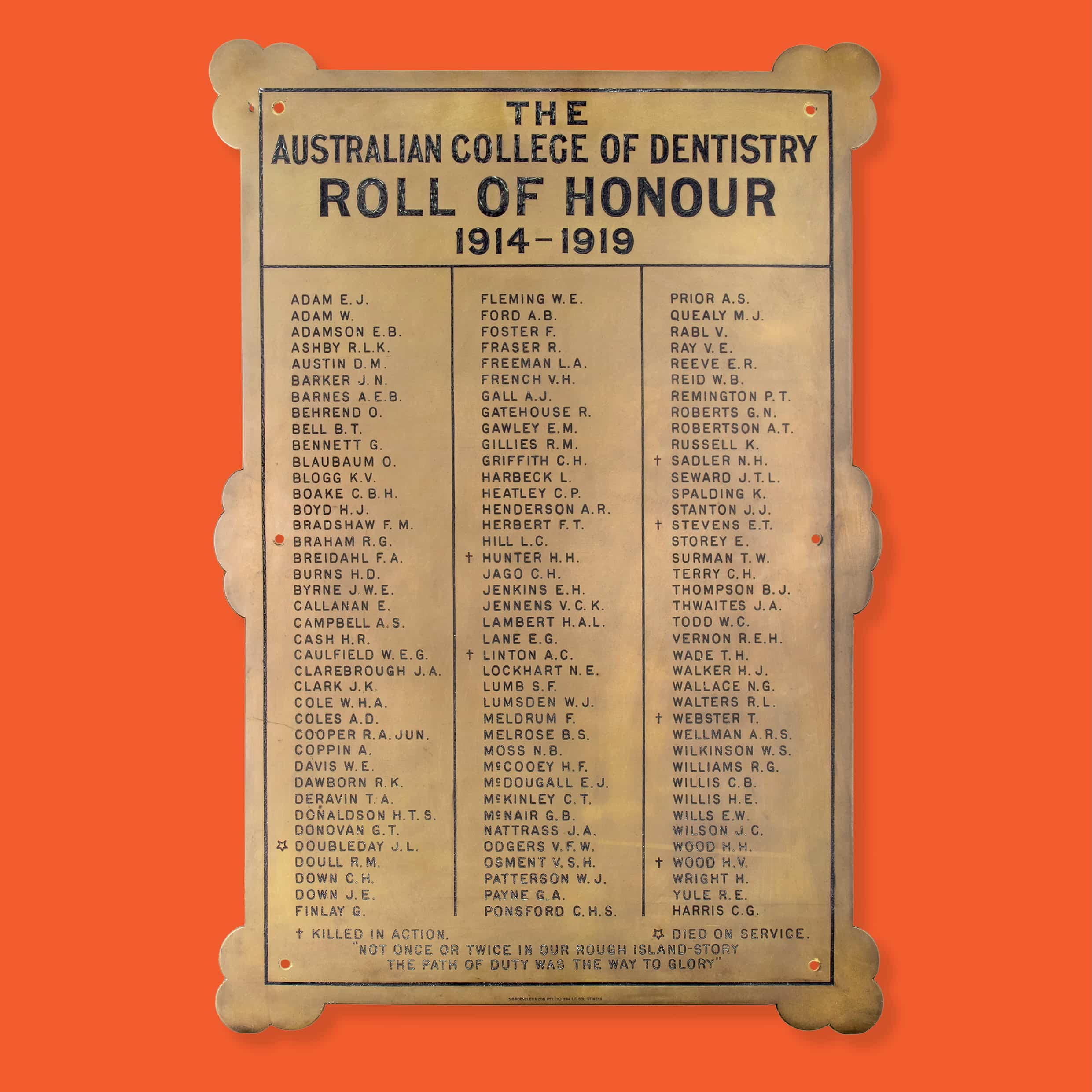
-
A famous man of Victorian dentistry
In 1925 The Australian Journal of Dentistry described Thomas Frederick William Hall as one of the ‘Famous Men in Victorian Dentistry’. Hall (1866–1941) emigrated to Melbourne from England in 1880. He was apprenticed to a practising dentist in Emerald Hill (South Melbourne) before becoming a licensed dentist in 1888. Hall practised initially in Bank Street, South Melbourne, then in the Melbourne Mansions at 71 Collins Street.
From a base of apprenticeship training, Hall was to become one of the leaders in the transformation of dental education in Victoria to a tertiary system. As a founding member of the Australian College of Dentistry, Hall was a strong advocate for the college to be affiliated with the University of Melbourne, which was achieved in 1904. In 1905, Dr John Springthorpe, as inaugural dean of the Faculty of Dentistry, introduced the degree of Bachelor of Dental Surgery (later Bachelor of Dental Science). That year Hall became a member of the Faculty of Dentistry, remaining a member from 1905 to 1932, and erving as its dean from 1915 to 1920. He believed that ‘the establishment of the degree enhanced the status of dentistry considerably’.
Hall was a member of the Dental Board 1910–32, and of the Australian Dental Association 1928–36. He was also influential in establishing dental services for the armed forces during World War I. In 1915, as a major in the Victorian militia, he was appointed to the Medical Branch to provide dental services for the Australian Military Forces, for which he was promoted to lieutenant colonel. In 1919, at the request of the Royal Australian Navy, he advised on the formation of the Dental Service of its Medical Branch.
Thomas Hall’s status as a pioneer of the profession of dentistry was acknowledged at the inaugural Ernest Joske Oration, which was delivered at the University of Melbourne’s Union Theatre by Dr RM Gillies, president of the Dental Board, in 1941.
Dr Jacqueline Healy
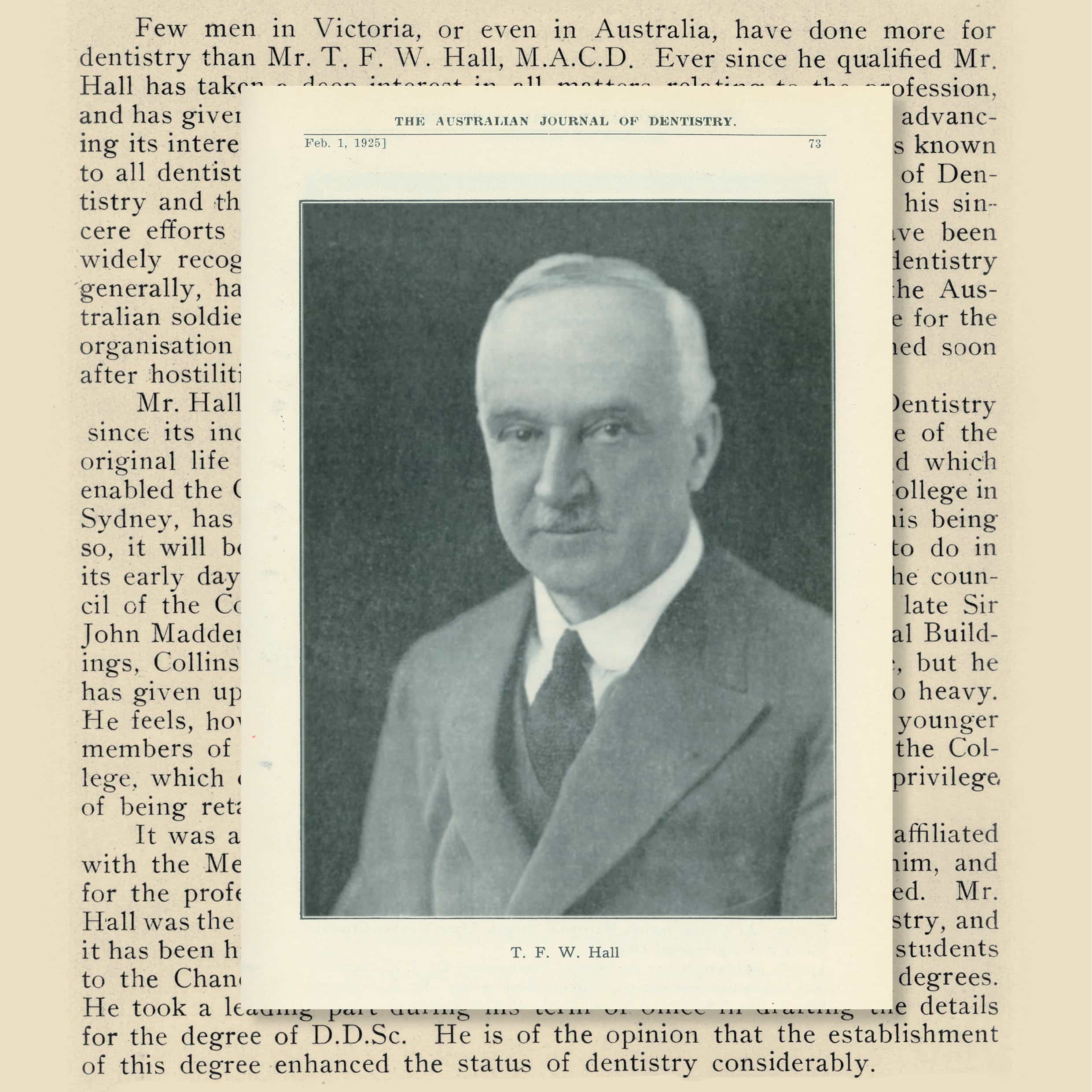
-
Dentistry in the Great War
Kenneth Russell (1885–1945) was born in Wellington, New Zealand. He began his dental training at the age of 16, as apprentice to Mr Arthur H Bell, dentist, of Collins Street in Melbourne. In 1916 he joined the Australian Imperial Force (AIF) and embarked as a Captain on HMAT Themistocles. Russell’s appointment as a Captain represented an important stage in the development of the dental profession in Australia—an acceptance that the level of knowledge, skill and training achieved by Dental Officers was equivalent to that of Medical Officers. Previously, the public and the medical profession recognised only the strictly technical elements of dentistry, remaining largely ignorant of its scientific and artistic aspects.1
Captain Russell served as a Dental Officer, firstly in Egypt and then in France. In December 1917 he was attached to the Queen’s Hospital in Sidcup, England. He was promoted to the rank of Major and was, apart from caring for patients with jaw and facial injuries, responsible for training Dental Officers in the special methods of treatment used at that time. In 1919 he described his work at Sidcup:
The work consists of treating fractured jaws (splinting etc) and making special appliances for facial operations, making a collection of splints and prosthetic appliances for the Universities of Sydney, Melbourne and Adelaide. This has now been completed. In addition dental officers have been attached for a course of instruction for varying periods. Capt’s Watson (Sydney), Findlay (Melbourne) and Taunton (Adelaide) are the officers. The mechanics, who at first numbered two are now, at date, 7. I think that 6 capable mechanics are required for a unit treating 100 beds as we have been with two dental officers.2
The Dental Mechanics of the Australian Army Dental Service demonstrated a very high level of technical skill in constructing these appliances, often under the most difficult physical circumstances.
After the war Russell returned to his practice in Collins Street. In 1921 the University of Melbourne awarded him the degree of Doctor of Dental Science for a thesis based on his work during the Great War, titled ‘Restoration of the superior maxilla by means of prosthetic appliances’.
Air Commodore Rowan D Story AM, RFD
1 AG Butler, letter to K Russell, 21 April 1945. Newland and Russell, P 29, 41 454, Australian War Memorial, Canberra.
2 K Russell, letter to Staff Officer Army Dental Service, AIF Headquarters, London, 26 February 1919. 41 454, Australian War Memorial, Canberra.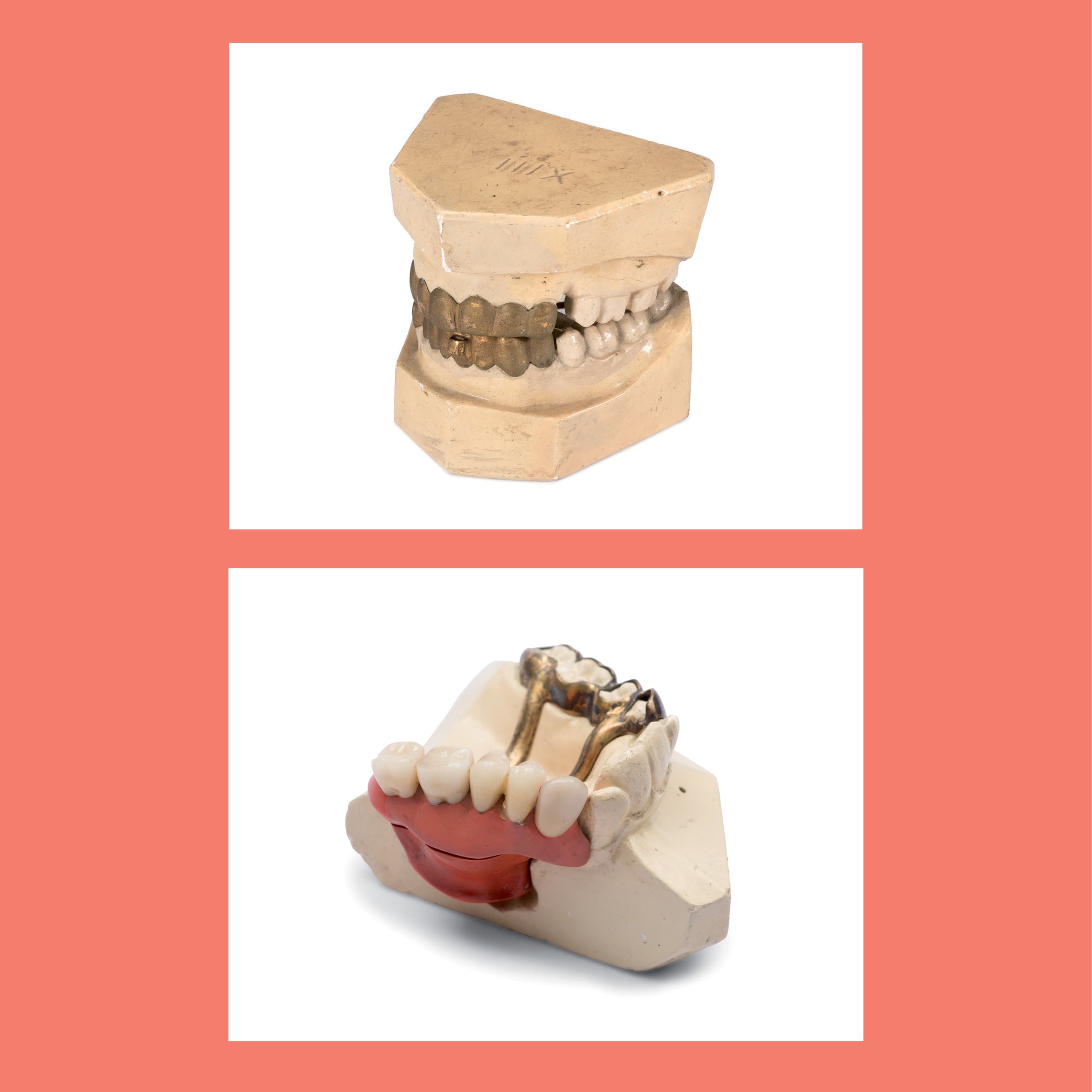
-
The supreme sacrifice
HMAS Sydney, a light cruiser, was returning home from convoy duties when on 19 November 1941 she came upon the disguised German raider HSK Kormoran off Carnarvon, Western Australia. She was drawn within range, and Kormoran’s salvoes tore into Sydney’s bridge and the gunnery director control tower; a torpedo disabled two gun turrets and impeded her progress through the water. Sydney was able to return fire with one turret, forcing Kormoran to withdraw, but eventually sinking with 645 men on board. The dental surgery sustained significant damage. Its staff were 18-year-old Able Seaman Sick Berth Attendant Stewart Laxton and Surgeon Lieutenant (Dental) Mervyn Townsend.
Mervyn Clive Townsend was born in Bairnsdale in 1917, the youngest of three boys. His father was headmaster at Bairnsdale High School (1916–29) and then at Bendigo High School. In 1934 Mervyn attended Melbourne High School before enrolling in dentistry at the University of Melbourne. He graduated BDSc in September 1939, and worked in Dr Max Casley’s Toorak practice before accepting a commission in the RAN on 14 October 1940. He joined Sydney as Dental Officer in April 1941. For the following seven months, Sydney undertook convoy duties in the Pacific and Indian Oceans before her fateful encounter with Kormoran.
Three months after the engagement, the decomposing body of a man wearing overalls was recovered off Christmas Island, where he was then buried in an unmarked grave. In 2006 these remains were rediscovered and analysed, revealing a tall, relatively young Caucasian male of Irish-Scottish heritage. The overalls were later determined to be blue, as worn by the ship’s company, not the white worn by officers. So the unknown sailor could not have been Mervyn. An examination by two Navy forensic dentists made various very detailed findings. Approximately 300 dental records held in Sydney went down with her. Would they have shown that Mervyn treated this sailor on board?
As Mervyn was the first of five members of the Australian Dental Association Victorian Branch (ADAVB) to lose their lives during World War II, the ADAVB established in his honour the Mervyn Townsend Memorial Prize in Orthodontics, awarded annually to a final-year DDSc student at the University of Melbourne.
Dr Jeremy Graham

-
Wartime ingenuity
In February 1942 some Australian servicemen on the island of Ambon, Indonesia, were captured by the Japanese and held there and on Hainan island until cessation of hostilities. After the death of the only Australian medical practitioner, Captain PM Davidson, on 15 February 1943, responsibility for the Australian prisoners’ medical care fell to a dentist, Captain Gordon Carlyle Marshall (1913–1985), and a doctor of the Royal East Indies Medical Services, Captain JHQ Ehlhart.1
Conditions on Ambon were very difficult: the hospital hut was a primitive structure measuring just 60 by 30 metres; medical instruments and medicines were in short supply; and prisoners suffered from diseases such as beri-beri, dengue fever, enteritis, tuberculosis, dysentery and stomatitis. Marshall
and Ehlhart would request supplies from the Japanese but were often refused or told they were not available. So, through necessity they improvised. As Joan Beaumont explains:Marshall experimented with making yeast a source of vitamin B … He also made sunglasses for the worst victims of conjunctivitis, from celluloid cut from anti-gas goggles … Some of Marshall’s most ingenious creations were, not surprisingly, in the area of dentistry. A dentist’s engine was made from an old bicycle wheel connected to a drill attachment by a series of wires and small wheels. Some dentures were fashioned from aluminium. They performed well but they had the habit of giving the wearers a shock when something hot was drunk.2
Held in the collection are some sand-cast aluminium dentures, made of metal salvaged from army water bottles and scrap from planes. These demonstrate Marshall’s ingenuity and skill, and the resourcefulness characteristic of many in the profession during wartime. As the late Professor Emeritus Henry Forman Atkinson commented: ‘Captain Marshall as a dental student would have had some contact with the casting of metal at the Australian College of Dentistry, but to achieve this result in the appalling conditions of a disease ridden prisoner of war camp … is almost beyond belief.’3
Dr Jacqueline Healy
1 Joan Beaumont, Gull Force: Survival and leadership in captivity 1941–1945, Sydney: Allen & Unwin, 1988, pp. 3, 107.
2 Ibid, p. 128.
3 HF Atkinson, ‘From the dental museum: In praise of ivory towers’, Dent-al: Alumni Newsletter, issue 5 (2006), p. 4.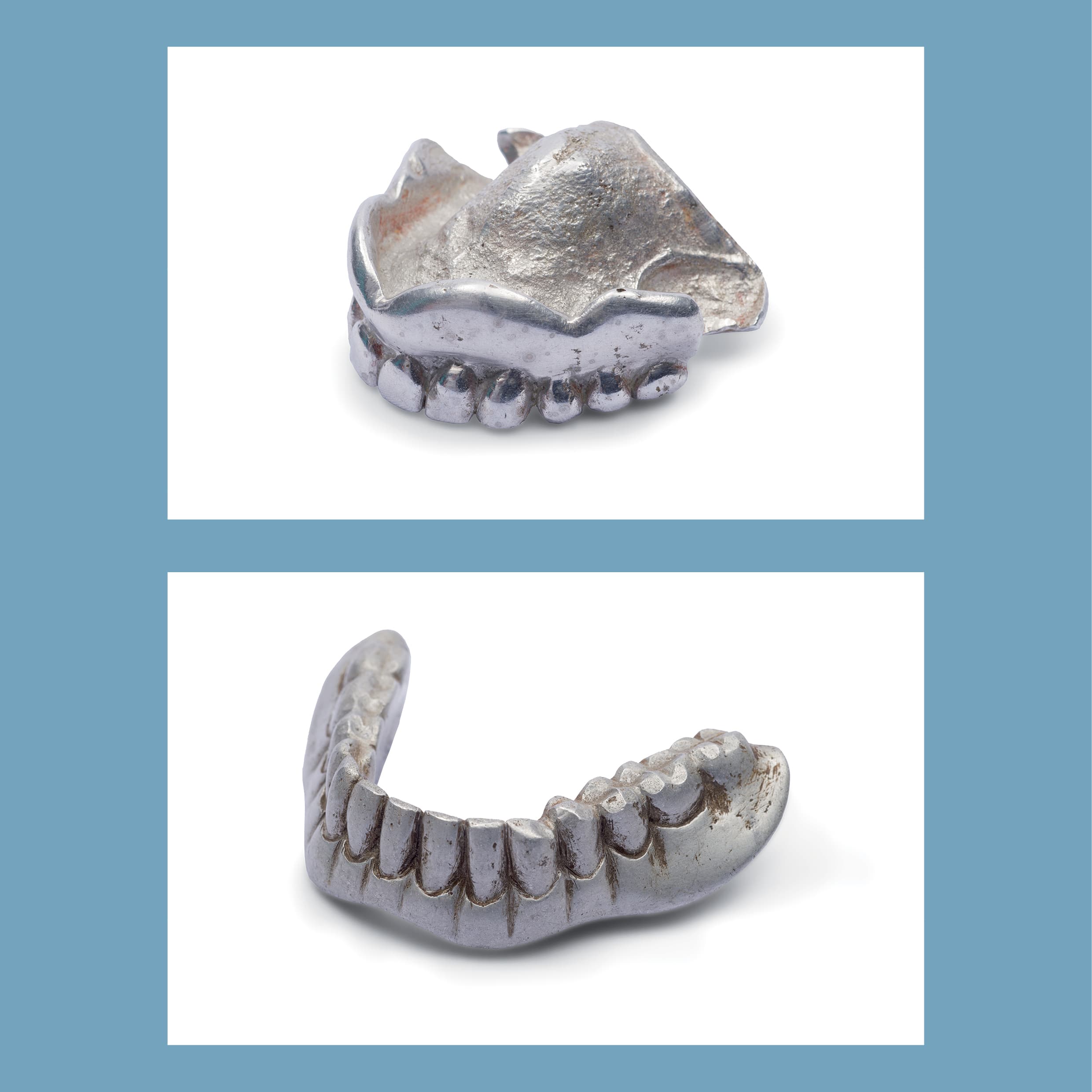
-
Teeth: Our record-keepers and story-tellers
Before the development of tools, implements and dental prostheses (however primitive the first of these were), human survival depended on a functioning dentition. Teeth meant life. This is still the case for many organisms today: if its teeth are lost, or cannot function—due to malocclusion, for example—the organism is unable to catch prey or break down other food sources and, as a consequence, dies. It might be this brutal fact that gives the image of teeth such power. Add to this the ability of teeth to seize, cut and cause trauma, and the symbolism of teeth is elevated further. Without teeth, all is lost—but the presence of teeth can mean danger!
Extracted teeth have long been used in stories and legends to represent trauma, disease and violence. Today, an image of an extracted tooth is often used in dental clinic logos, even though that is exactly what dentists are trying to help you prevent.
Odontologists and researchers in mineralised tissue spend a lot of time around teeth, either extracted or situated in the jaws of humans and animals now reduced to skeletons. They appreciate the importance of teeth to the human story, due to their understanding of how teeth develop and what they can tell us about human life and health.
Dr Rita Hardiman
More Information
1 Joan Beaumont, Gull Force: Survival and leadership in captivity 1941–1945, Sydney: Allen & Unwin, 1988, pp. 3, 107.
2 Ibid, p. 128.
3 HF Atkinson, ‘From the dental museum: In praise of ivory towers’, Dent-al: Alumni Newsletter, issue 5 (2006), p. 4.
-
Martha Needle and Frances Knorr
These are the skulls of Martha Needle and Frances Lydia ‘Minnie’ Knorr, both executed by hanging in 1894. Needle was sentenced to death for the murder of her husband, children and future brother-in-law by poisoning. She was executed at the Melbourne Gaol, aged 30 years. Knorr, a ‘baby farmer’, was sentenced to death for the murder of three infants in her care, and executed at Pentridge Gaol. She was 27 years old. Both women led tragic lives and endured circumstances that undoubtedly contributed to their criminal behaviour.
The skulls were originally housed and presumably on display at the Old Melbourne Gaol, before custodianship was granted through the National Trust to the Melbourne Dental School in 2006.
Both skulls are covered with cream-coloured, lead-based paint. Despite this covering, if you look closely the skulls reveal aspects of these women’s lives. Both have spaces where teeth were lost or extracted during life. In the spaces where hollow sockets remain, no bone remodelling has occurred, so these teeth were most likely lost post-mortem.
In Frances Knorr’s skull, only two mandibular canine teeth remain. The incisors and premolars were presumably lost post-mortem, but sockets for the mandibular molars have remodelled, indicating they were lost during life. The story is similar in her upper jaw: some teeth lost during life, some after death.
Martha Needle also lost teeth before and after death. Her skull retains some molars in the lower and upper jaws, but she lost all premolars in her upper jaw during her lifetime. There are some moderately sized calculus deposits on the mandibular tooth surfaces facing the oral cavity.
Neither of these women would have been asked permission before execution for her remains to be held and displayed. Attitudes to the collection, retention and appropriate use of human remains have changed significantly in the meantime. Today, we learn from these examples by studying physical features of the skull and teeth. If we are to be responsible and ethical custodians, we should use these specimens to learn about the women’s lives and circumstances in order to benefit people today and in the future.
Dr Rita Hardiman
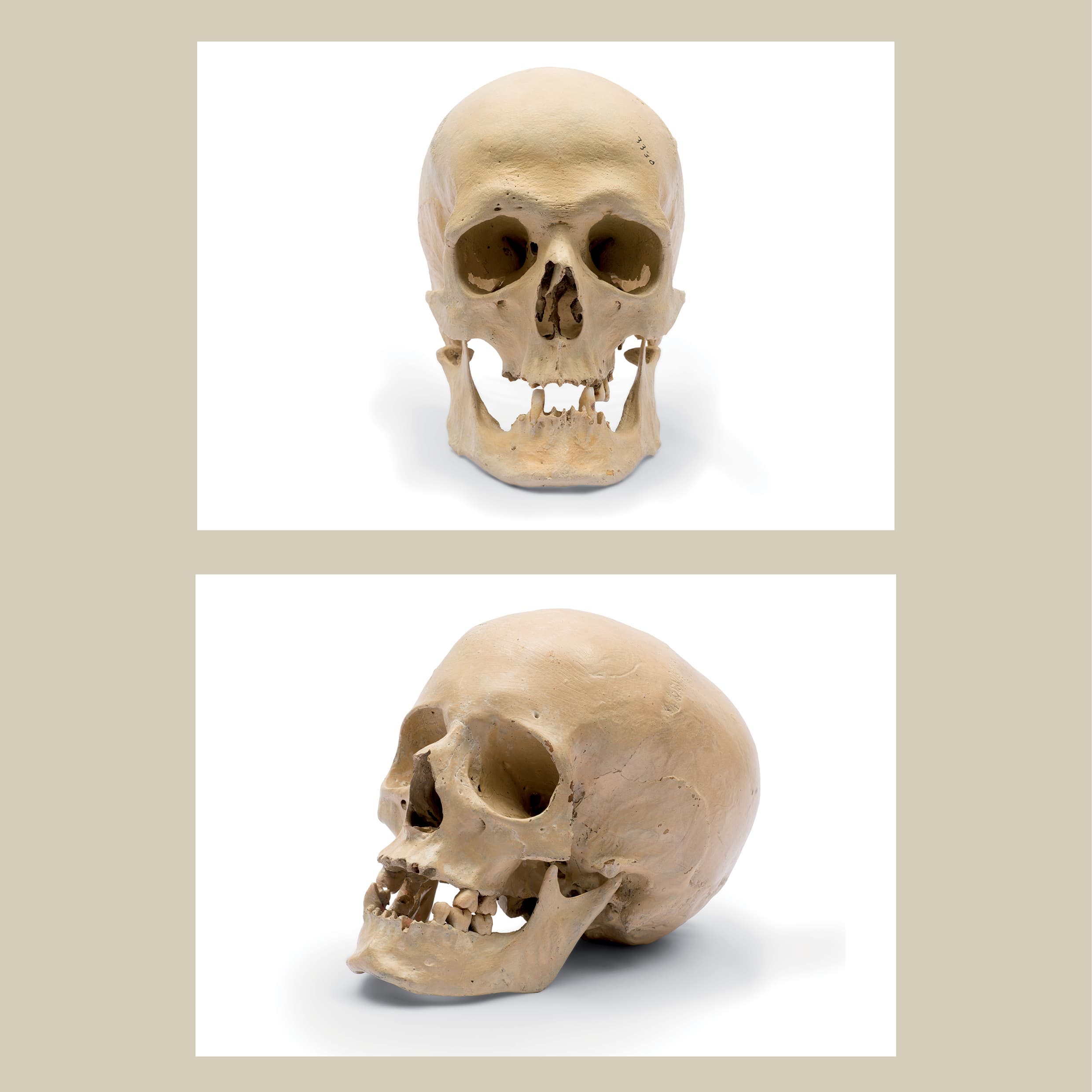
-
Thylacine!
The thylacine (Thylacinus cynocephalus), or Tasmanian tiger, was a carnivorous marsupial. Once commonly found in mainland Australia and New Guinea, it is now extinct. The most likely last living thylacines were held at Hobart Zoo—all were dead by 1936. Footage of this last group of thylacines shows them pacing and lounging in their enclosure, and displaying their impressively large mouth-gape.
The thylacine is an excellent example of convergent (or parallel) evolution: the process by which two or more unrelated species evolve the same or similar physical features.
A thylacine’s skull closely resembles those of carnivores such as dogs, foxes and wolves, but it is a close relative to none of these, the thylacine being a marsupial, while the others mentioned are placental carnivores. A distinctive feature of thylacines is the dentition: four incisors, one canine, three premolars and four molars on each side, as opposed to the relative three, one, four and three in foxes and wolves.
Collected samples of thylacines exist in many countries, in the form of preserved pups and skeletal material, for example. The International Thylacine Specimen Database has been published as a record of all thylacine specimens held in museum and university collections.1
Several collection items are a sad reminder of what is lost to us through the thylacine’s extinction. A bisected skull and these plaster tooth models were used in education to illustrate anatomical differences and similarities between different animals’ teeth, and the development and evolution of tooth cusp form in different species. The tooth models are part of a larger series made by Professor CH Down in the Faculty of Dental Science, which also includes models of Tasmanian devil, koala and kangaroo teeth.
Dr Rita Hardiman
- SR Sleightholme and CR Campbell, ‘The International Thylacine Specimen Database (6 revision—project summary & final report)’, Australian Zoologist, vol. 39, no. 3 (2018), pp. 480–512.
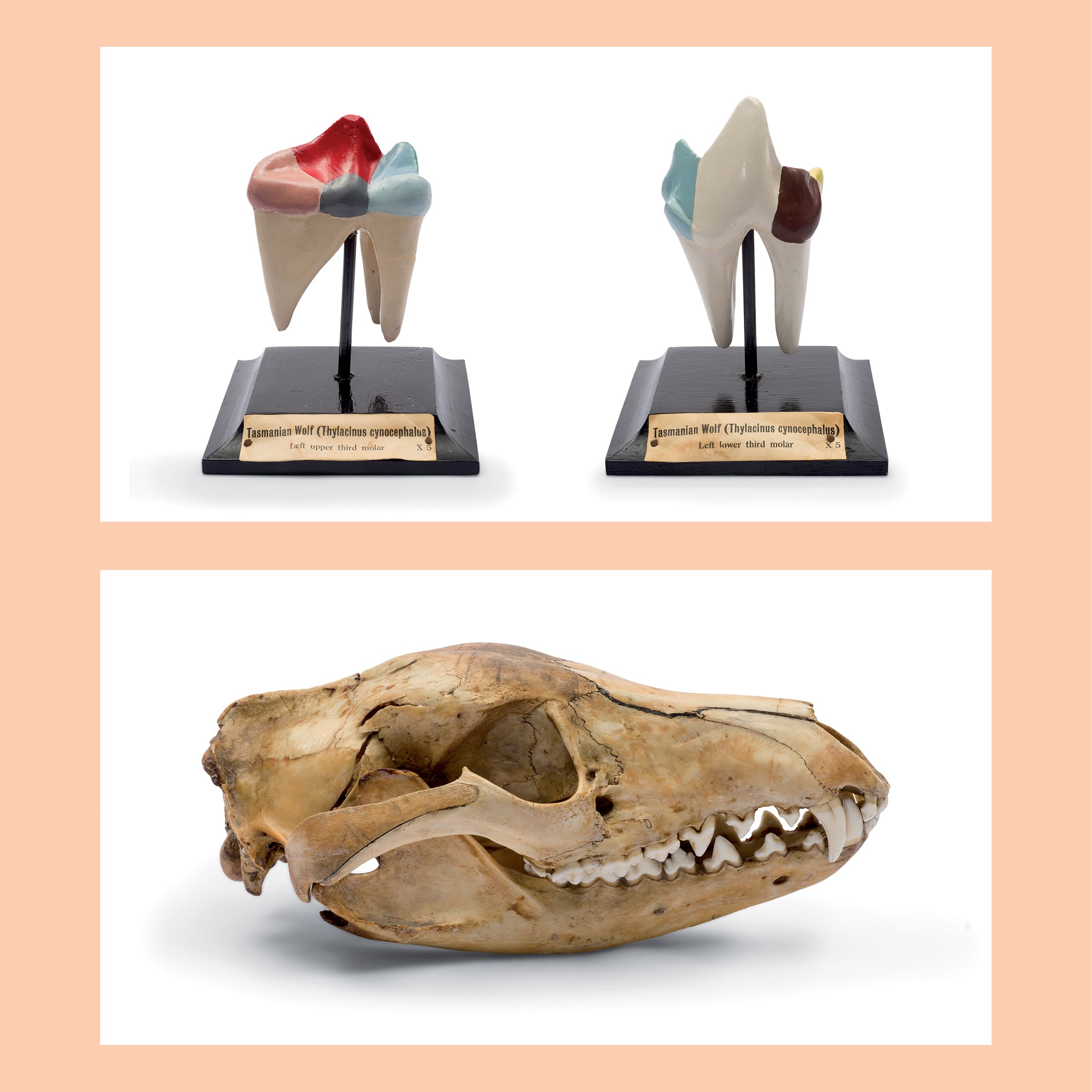
-
Identifying the dead
When a person dies unexpectedly, or in unusual or violent circumstances, in Australia it is generally the responsibility of forensic pathologists to establish the cause and mechanism of death. Sometimes the deceased person’s identity is not known, in which case identification can usually be resolved by comparing some form of ante-mortem record with post-mortem findings at autopsy. This can be done in various ways, such as fingerprint comparison.1
However, not all human remains are suitable for such comparisons. This may be because of post-mortem alteration of the body by putrefaction, burning or traumatic physical injury. In such circumstances the skeletal remains provide the most robust source of information. In life the teeth, being the only parts of the skeleton naturally exposed and visible, are more likely to have been documented in some way. Photographs of the living person may show them smiling, revealing the number, shape and arrangement of the front teeth, which may be sufficient to establish identity. The person’s treating dentist can furnish X-ray images of the teeth and jaws. These also provide information about past treatments, such as placement of fillings and other restorations.
Fortunately, the teeth (and materials used by dentists to repair or replace them) are usually very resistant to breakdown. Teeth’s mineral component does not melt below l600 °C—higher than the melting point of most metals. Further, as dental tissues are progressively subjected to increasing heat, the sub-microscopic apatite crystals, which provide teeth with their hardness in life, fuse by sintering, so that even after the complete combustion of any binding organic components of the teeth has occurred, their morphology and component tissues remain, albeit in a shrunken and friable state. Dentures or false teeth are made of metal or acrylic, both extremely resistant to chemical destruction. Although acrylic is vulnerable to burning, such dentures, protected at the expense of the oro-facial tissues enveloping them, frequently survive a fatal conflagration.
Once a putative identity has been established, and because almost everyone in Australia has had a dental examination at some stage of their life, excellent records often exist for comparison with these most persistent and stable parts of the remains.
Professor John G Clement (1948–2018)
More information
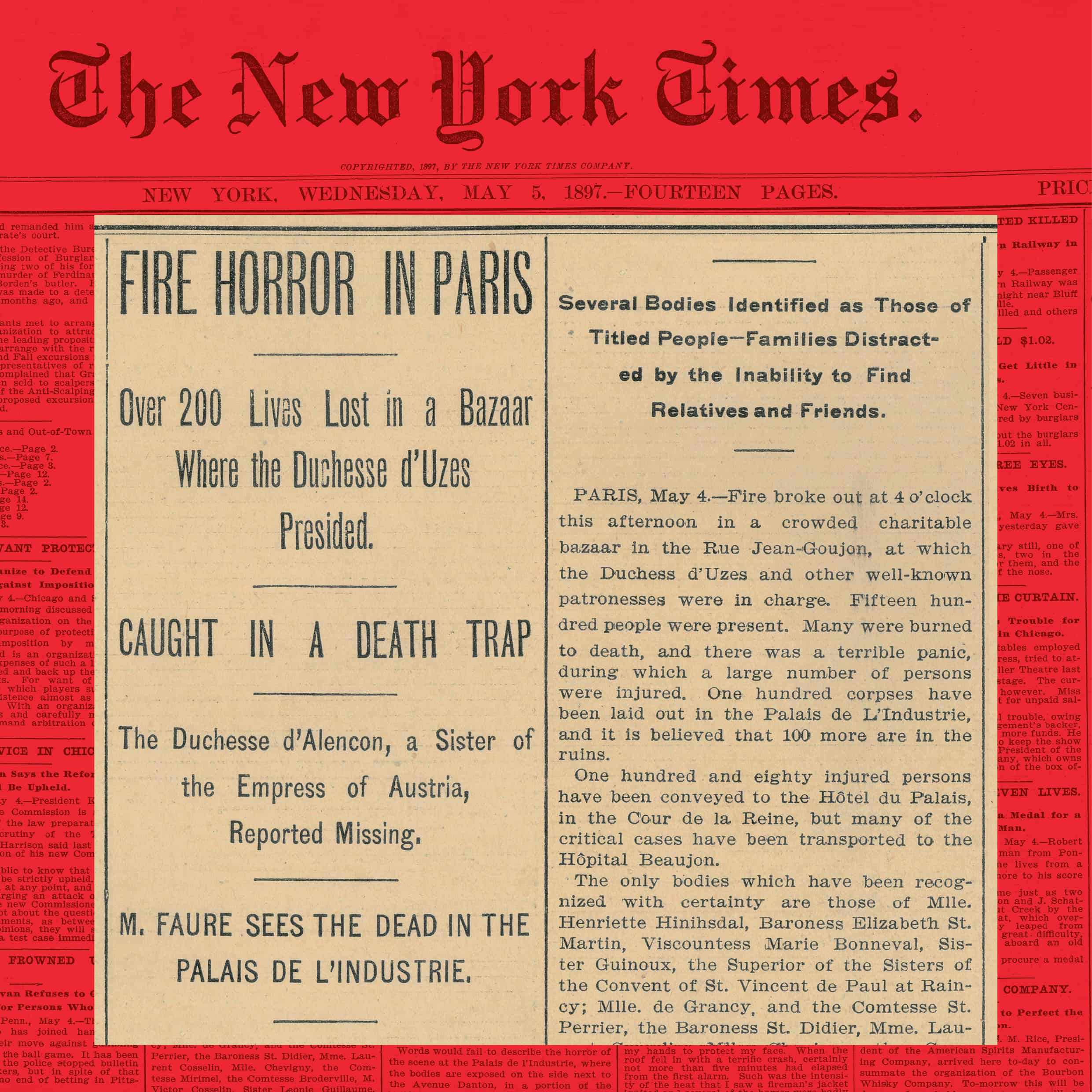
-
The teaching of dentistry
When I enrolled as a student in the Faculty of Dental Science in 1949 I knew very little about dentistry, let alone the teaching of dentists, apart from my own experience as a patient needing drilling and filling. Although World War II had been over for four years, there were still shortages of materials and equipment, and during my five-year course we used foot-driven drills for part of the time and ex-army, belt-driven electric engines for the remainder. This changed in 1952 when the college’s treatment clinic was refurbished with all-electric motors, and with chairs and units designed to be easily moved to the new dental hospital that was in the planning stages.
This was an era in which extraction was often the preferred treatment for decayed teeth, and the more aesthetically pleasing acrylic resin was replacing vulcanite (vulcanised rubber) as a material for dentures. Gold was still relatively cheap, and as a filling material was generally preferred over dental amalgam (a silver-tin-mercury mix). Local anaesthesia was in transition from cocaine and novocaine to more effective agents such as xylocaine. General anaesthesia was often used with difficult patients, and the need for adequate oxygenation during these procedures was slowly being recognised. Tooth-coloured materials were only semi-permanent, while the longer-lasting fused porcelain crowns were much more expensive. Preventive dentistry was in its infancy, and the need to preserve remaining tooth structure during tooth preparation was not considered of great importance.
In the mid-1950s the introduction of the air-rotor high-speed drill made the task of tooth preparation for restoration much faster and less painful for patients. Other innovations included elastic-type impression materials; better understanding of the growth and development of the head, mouth and jaws, leading to better orthodontic care; and use of antibiotics to counter infections in the oral cavity and surrounding tissues—which in turn enabled more extensive surgical procedures to correct growth abnormalities. In the late 1960s the first truly adhesive restorative materials appeared on the market, along with acid-etching of enamel to retain tooth-coloured restorative materials. These were at first chemically activated and often fast-setting, making manipulation difficult. Today we have materials that remain soft until hardened by exposure to bright light.
Associate Professor John Harcourt OAM
More Information

-
Fluff
Professor Emeritus Charles Harold Down DDSc, FRSRCS, FACD (1893–1965), known to generations of the profession as ‘Fluff’, was the first lecturer in conservative dental surgery at the Australian College of Dentistry, retiring in 1958. He was educated at the University of Melbourne, graduating in 1912 from the recently established BDSc. After graduation, he volunteered with the AIF and was appointed a captain in the Dental Department of the Medical Corps, embarking on 1 July 1918 to Europe.
Down entered private practice after returning from service overseas. His career in dental education began in the early 1920s, when he was appointed as a demonstrator to the University of Melbourne. Subsequently he became lecturer in operative technique, then senior lecturer in charge of conservative dentistry at the College of Dentistry in 1934, and in 1949 when he was appointed foundation professor of conservative dentistry and associate dean of the Dental Faculty. He continued to work after retirement in 1958, being listed as an honorary consultant dental surgeon at the Dental Hospital of Melbourne in the 1960 Calendar of the University of Melbourne.
Professor Down was an innovative and dedicated educator. He developed a technique for the production of large-scale teaching models with which he demonstrated the
GV Black system of cavity classification (see page 48). Some of these models were displayed in the Spring Street building that housed the Australian College of Dentistry from 1907 to 1963. He also produced large chalk-pastel drawings in black, white and green, depicting the human teeth (pictured here and on page 23), used as part of his work as a part-time senior lecturer in the Department of Conservative Dental Surgery of the Australian College of Dentistry in the early 1930s. These drawings were included in his thesis, ‘The teaching of operative technique and tooth morphology by visual methods’. The thesis was submitted for the degree of Doctor of Dental Science, University of Melbourne, Department of Conservative Dental Surgery, on 12 March 1938. A selection of Down’s drawings is part of the Henry Forman Atkinson Dental Museum collection—a lasting reminder of early innovation in teaching practice.
Associate Professor John Harcourt OAM
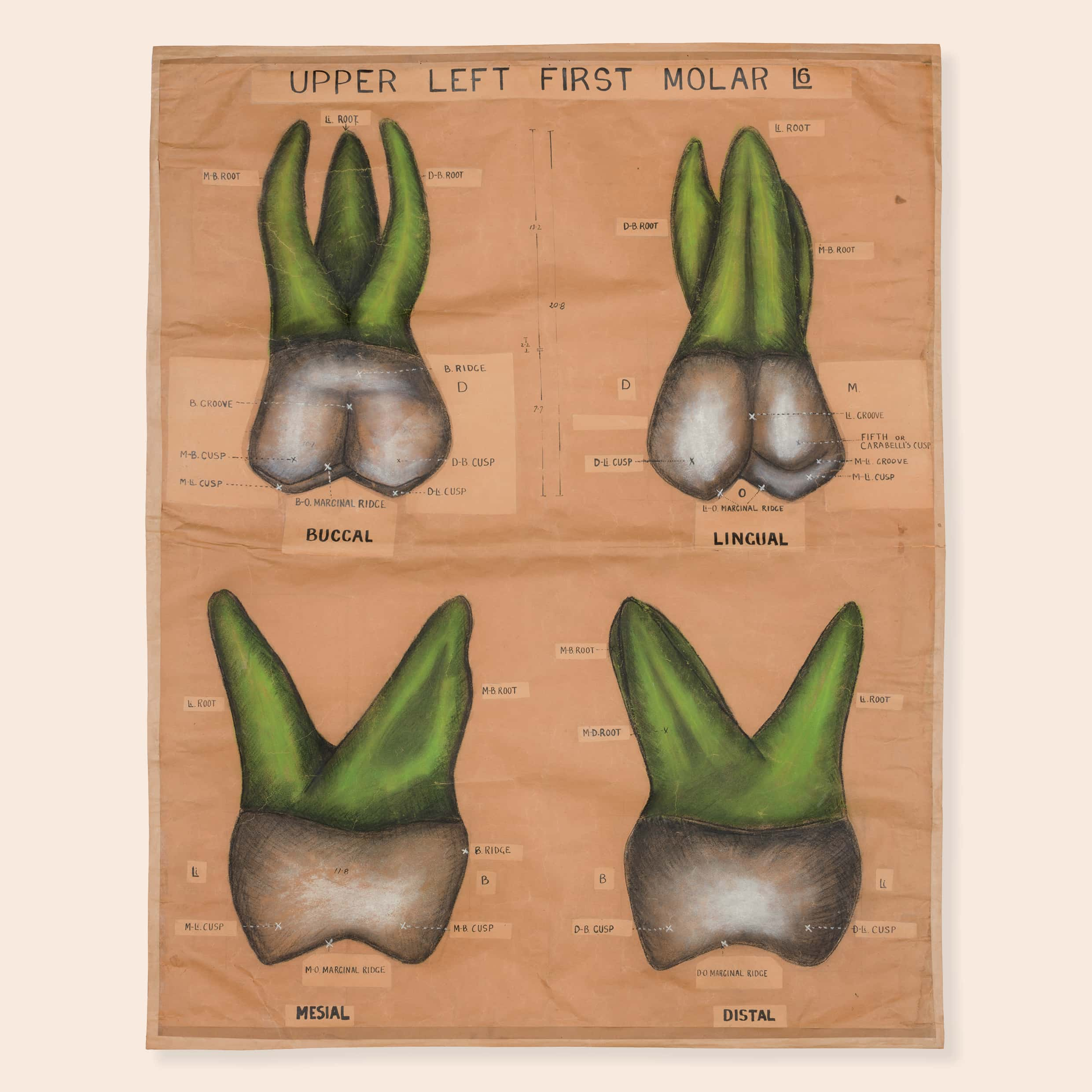
-
A man of boundless energy
William John Tuckfield (1881–1969), dentist and academic, was born at Belfast (Port Fairy) in western Victoria. ‘Tucky’, as he was known, received the diploma of the Australian College of Dentistry and was registered as a dentist in 1902 by the Dental Board of Victoria.1 He served in the Australian Army Medical Corps (Dental Services) in 1915–18, becoming honorary captain in 1917.
Elected a member of the Faculty of Dental Science of the University of Melbourne in 1908, he was dean in 1922–23 and retired in 1959, having been acting professor of dental prosthetics since 1949. He edited The Australian Journal of Dentistry (1914–56), then became editor emeritus of the new Australian Dental Journal. His editorials, articles and letters, devoted to the support of the profession, revealed an uncompromising approach. With boundless mental and physical energy, he worked seven days a week in private and hospital practice: teaching, editing, and engaging in dental politics. He was president of the Odontological Society of Victoria (1910), the Alumni Society of the Australian College of Dentistry (1921) and the Australian Dental Association (1939–41). Chairman and president of the Australian College of Dentistry and the Dental Hospital in 1915–16, he still worked there at the age of 72 as building officer. His lifelong interest in visual aids developed from the magic lantern, through the deep-focus camera, to colour cinematography, in which he made a significant contribution to clinical teaching. He retired in 1963 and resigned from the council in 1967.
An outstanding clinician, Tuckfield had a high level of technical skill, which was communicated in his only book, Full denture technique (Melbourne, 1944). Although he showed no interest in working for higher qualifications—either through study or research—he never failed to help others to succeed. His achievements were recognised by the awarding of honorary degrees from Northwestern University, USA (DSc, 1925) and the University of Melbourne (DDSc, 1944; LLD, 1963), and by an Honorary Fellowship in Dental Surgery from the Royal College of Surgeons, London (1948).
Professor Emeritus Henry Forman Atkinson MBE (1912–2016)
- This is an edited version of HF Atkinson, ‘Tuckfield, William John (1881–1969)’, Australian dictionary of biography, vol. 12, Melbourne University Press, 1990.
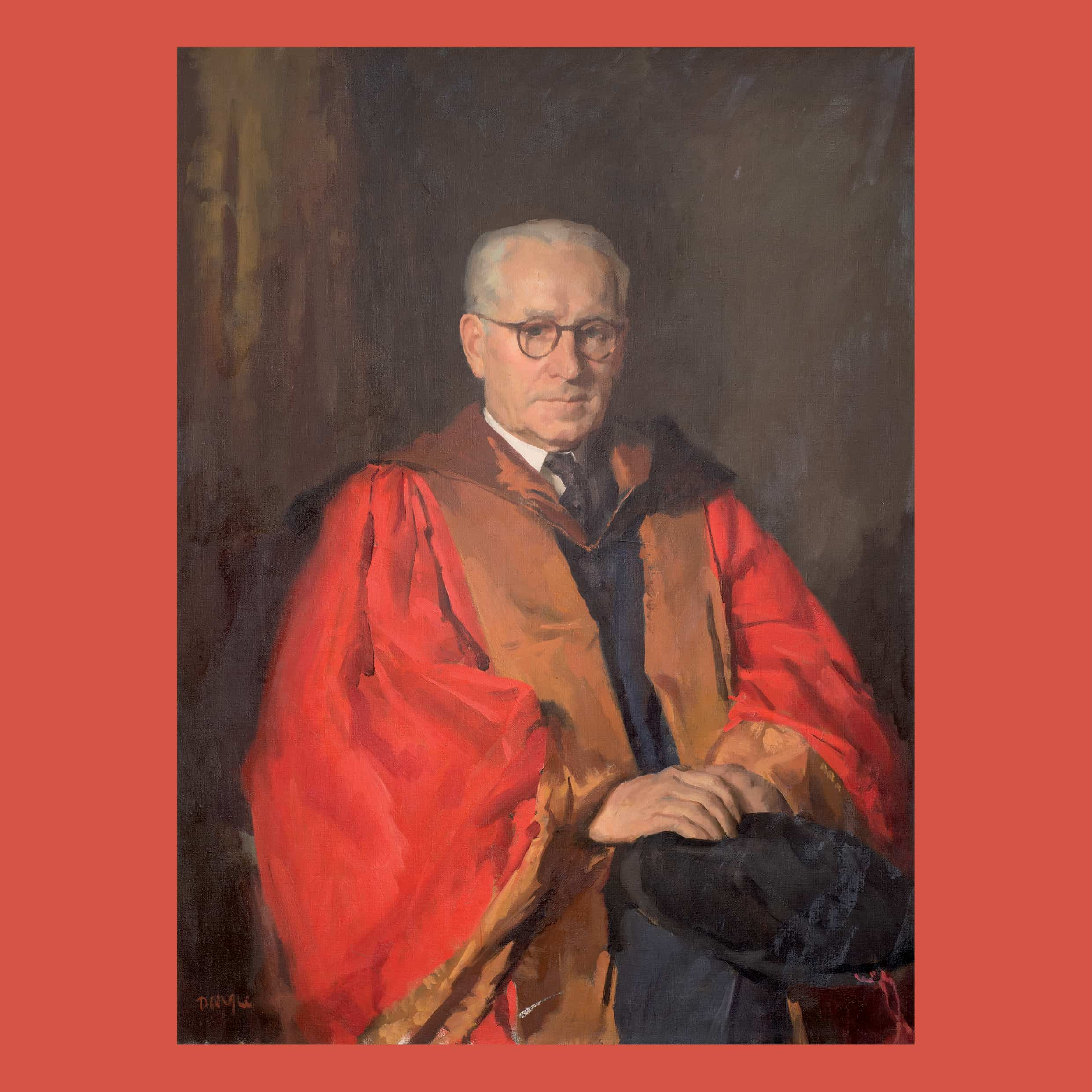
-
A big contributor
Professor Emeritus Sir Arthur Barton Pilgrim Amies (1902–1976) was dean of the University of Melbourne’s Faculty of Dental Science from 1934 until he retired in 1967. He contributed immensely to dentistry and oral and maxillofacial surgery in Victoria.
He was a ‘big man physically’ with a big personality that ‘inevitably led to differences of opinion with other similar personalities’.1 But it was his personality and spirit that enabled him to achieve so much.
Amies was born in Perth, Western Australia. He completed dentistry at the University of Melbourne in 1924, and medicine at Edinburgh University in 1928. Returning to general dental practice in Melbourne, Amies concurrently completed a DDSc (1929) and DLO (1933). In 1934 he was awarded an FRACS after previously attaining an FRCS(Ed). His private practice, meanwhile, matured into one of oral surgery, radiology and anaesthesia. Amies was an honorary consultant at the Dental, Royal Melbourne, and Royal Victorian Eye and Ear hospitals, and consultant oral surgeon to the Alfred Hospital.
In June 1940 Amies joined the Australian Imperial Force, serving with the 4th Australian General Hospital at Tobruk and the faciomaxillary/plastic surgery unit at the 2nd Australian General Hospital in Egypt. After the war he became president of Melbourne Legacy in 1955 and patron of the ‘Rats of Tobruk’, received a CMG in 1949 and was knighted in 1957.
Amies’ contribution to dentistry was extraordinary. As well as being dean of the faculty for 33 years, he was president of the Australian Dental Association Victorian Branch (1936–37), president of the federal association (1937–39) and an honorary life member from 1970. He established the Dental Research Laboratory (later the Australian Dental Standards Laboratory) in the 1930s and served on the Dental Board of Victoria (1933–35 and 1955–58). Amies was also the driving force, from the 1930s, behind the construction of the new dental school and hospital (later the Royal Dental Hospital of Melbourne) at Haymarket, which opened in 1963.
Associate Professor Arun Chandu
- CRN, ‘Obituary: Professor Emeritus Sir Arthur Amies’, Australian Dental Journal, vol. 22, no. 1 (February 1977), pp. 59–60; Amies, Arthur Barton Pilgrim’ (finding aid to series 77/13, 79/44 and 94/67), University of Melbourne Archives.
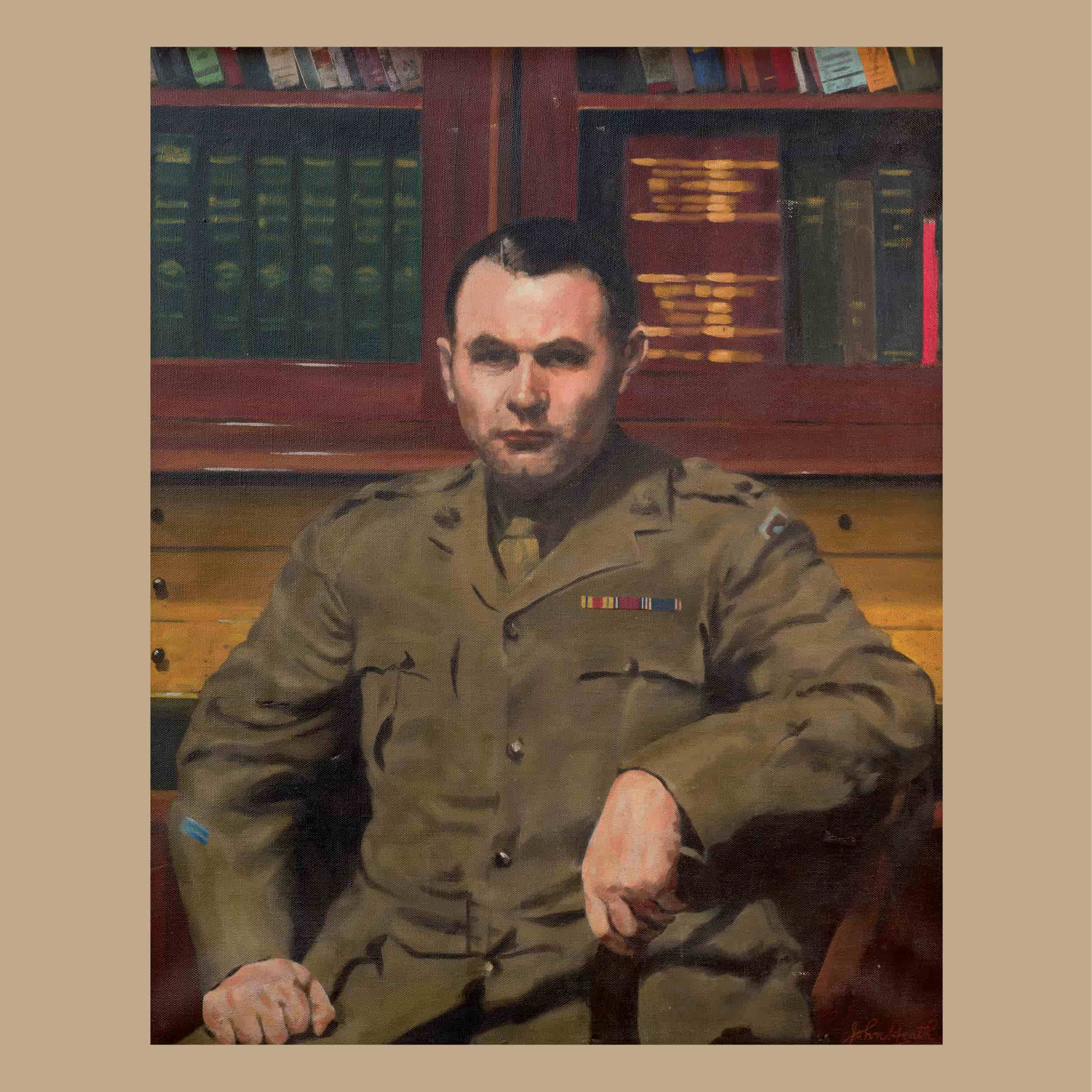
-
A wise leader and generous teacher
Kenneth Thomas Adamson (1904–1976) was born in 1904 in Melbourne.1 His father was a dentist. Graduating BDSc from the University of Melbourne in 1927, he was appointed a house surgeon at the Melbourne Dental Hospital, where his research led to a DDSc in 1929. He was to become lecturer, senior lecturer and head of the department of orthodontics in the Australian College of Dentistry, while continuing as honorary consultant to the hospital.
Joining the university’s Faculty of Dental Science as a senior lecturer in 1935, Adamson was an honorary captain in the Australian Military Forces during World War II. He was on the council of the Australian College of Dentistry (until 1963) and on the council of the Dental Hospital (from 1947). He was president (1935), honorary secretary (1944), and permanent vice-president (from 1962) of the Australian Dental Association (ADA) Victorian Branch, federal president 1954–60 and a life member from 1970. He was president (1954–57) of the Australian Society of Orthodontists and a founding member of the (Royal) Australian College of Dental Surgeons (president 1968–70). Professional honours were granted by the American Dental Association, British Society for the Study of Orthodontics, RACDS and the Royal College of Surgeons, England.
Adamson was often called upon for his leadership, knowledge and connections. In the ADA he helped to weld state delegates into a body with a like-minded professional outlook. An excellent and generous teacher, he published regularly in The Australian Dental Journal. He was patient and skilful in making orthodontic appliances, and his practice flourished. His concern with public health was revealed on the council of the Dental Hospital. Under his chairmanship the Dental Alumni Research Foundation collected funds to build a research centre on the grounds of the hospital for use by the university; in 1975 he played a central role in combining the university and hospital departments of orthodontics into a single, self-contained unit for treatment, teaching and research, which was named in his honour.
Professor Emeritus Henry Forman Atkinson MBE (1912–2016)
- This is an edited version of HF Atkinson, ‘Adamson, Sir Kenneth Thomas (1904–1976)’, Australian dictionary of biography, vol. 13, Melbourne University Press, 1993.
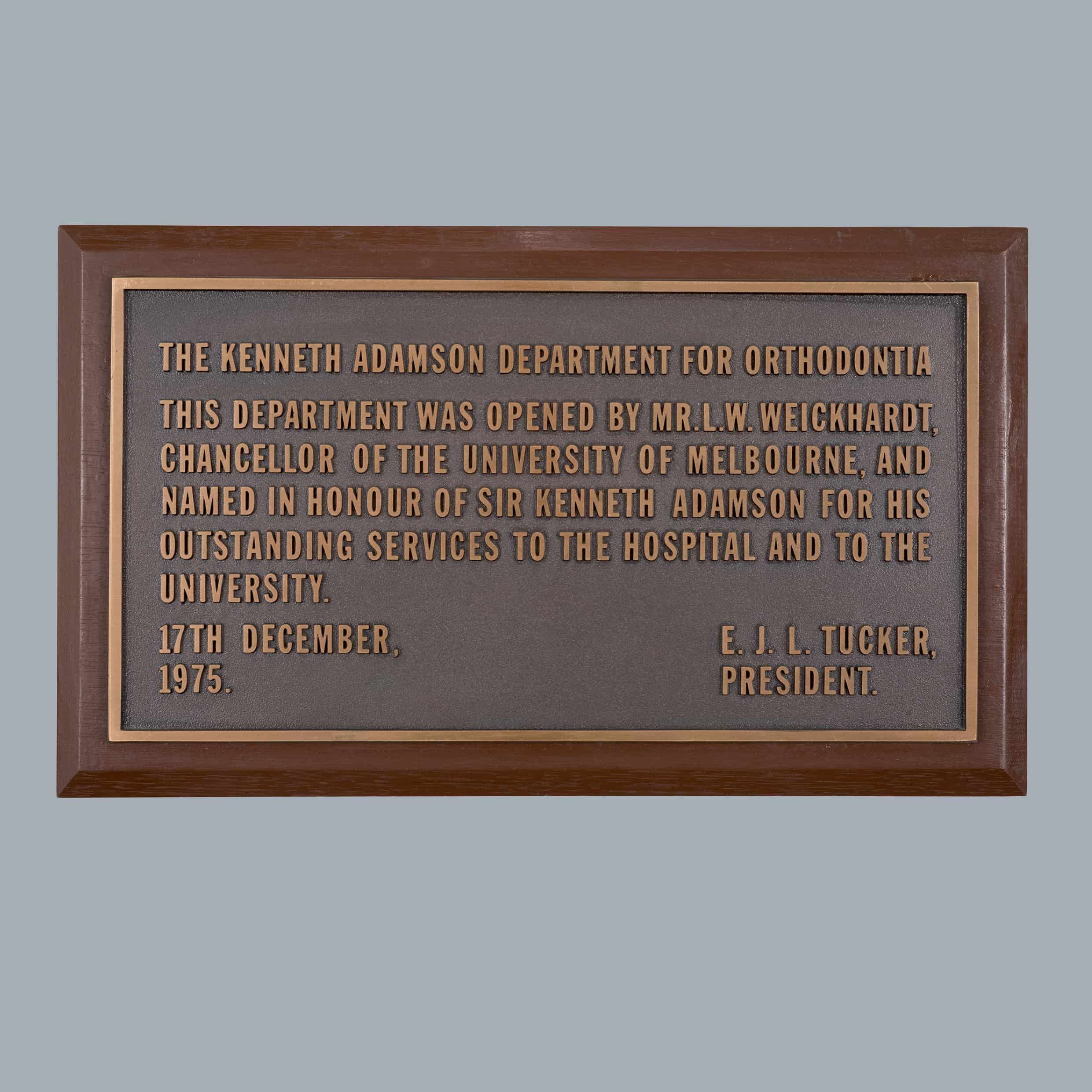
-
A merchant of change
Elsdon ‘Tony’ Storey (1924–1988) was born into a Melbourne dental family, with his father (also called Elsdon) and uncle both dentists, his mother a dental nurse, and one son becoming a dentist. After matriculating in 1941 he graduated in dentistry at the University of Melbourne in 1945, joining the Faculty of Dental Science in 1948. In 1955 he was awarded a Nuffield Scholarship, which took him and his family to the UK, resulting in papers on tooth movement through bone, still cited today, and he was awarded his PhD in 1959. In 1963 Elsdon was appointed professor of conservative dentistry and subsequently inaugural chair of child dental health (1974) and dean (1971–77 and 1980–81).
Elsdon had interests outside dentistry, especially painting and drawing. We heard stories of him making his own paint on the kitchen stove and ageing paints in his attic, and especially of his love of Rembrandt’s portraits. Elsdon created many paintings, particularly around the city of Melbourne and later Lorne on Victoria’s west coast, with paintings being presented in 2012 to the previous two Elsdon Storey Chairs of child dental health, Professor Emeritus Louise Brearley Messer and the author. The love and support of his wife, Dr Patricia Gladwell-Storey, were obvious to those who knew the couple.
Elsdon Storey will be remembered for his strong promotion of child oral health and the benefits of water fluoridation, at a time when child oral health was not considered important. He was criticised and attacked from many sides for these beliefs, even by his dean, Sir Arthur Amies! Nevertheless, due to the persistence of Elsdon and his fellow campaigners (including his brother Haddon Storey, an attorney-general of Victoria), reticulated water fluoridation was introduced into Victoria in the 1960s–70s. This advocacy for and devotion to the improvement of oral health, especially in children, has led to four decades of markedly decreased oral health burden for the Victorian population.
Professor David J Manton
Many facts here were recalled from a 2012 presentation given by Elsdon Storey’s daughter-in-law, Associate Professor Christine Rodda. See also WE Chalmers, ‘Obituary: Professor Emeritus Elsdon (Tony) Storey’, Australian Orthodontic Journal, vol. 11, no. 1 (March 1989), p. 79.
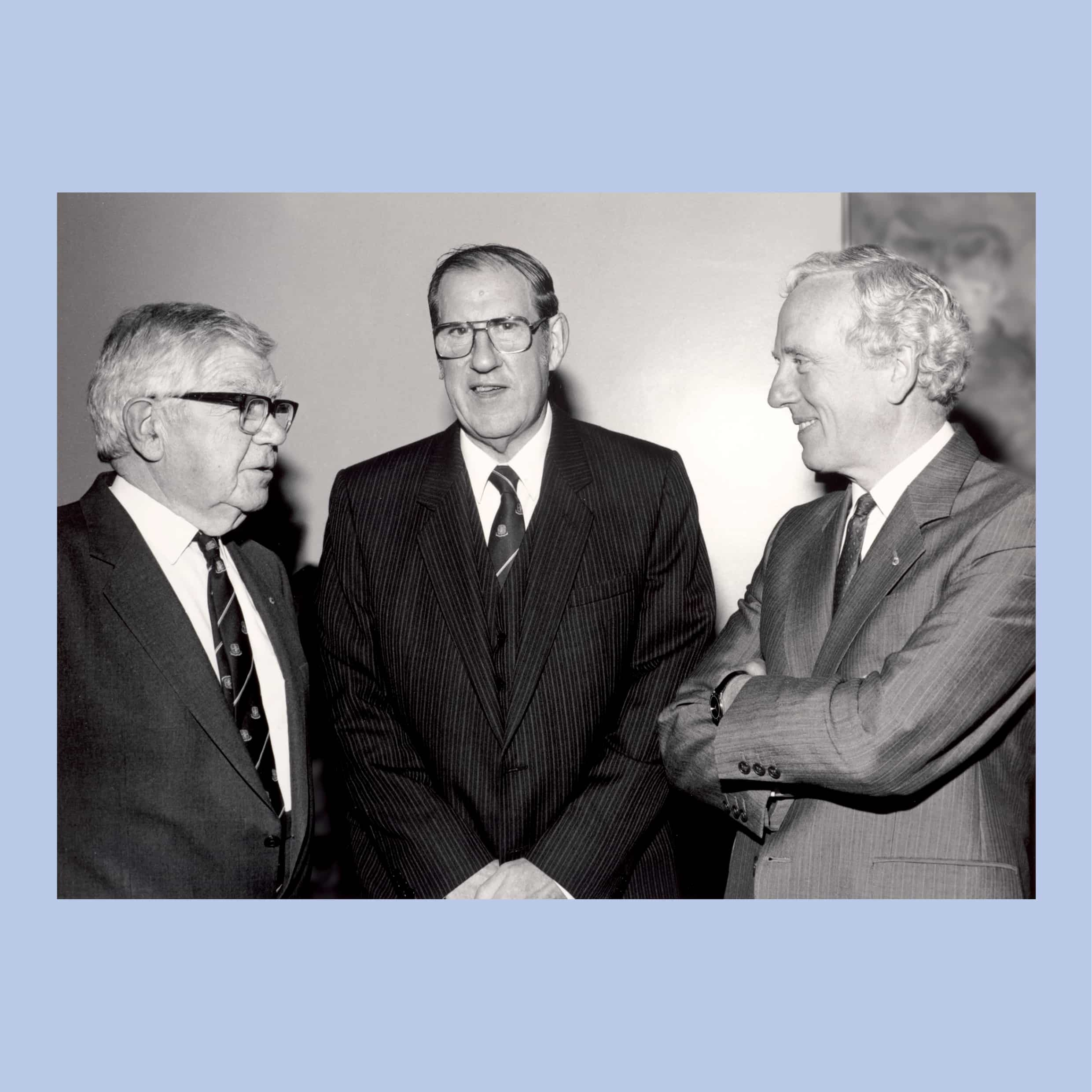
-
A leader and historian of the profession
Professor Emeritus Henry Forman Atkinson MBE, LDS, MSc, DDS, MDSc, FDSRCS (1912–2016) came from Manchester Dental School to the Australian College of Dentistry in 1953 as professor of dental prosthetics. He immediately set his stamp on the department by insisting on all staff members participating in research projects as well as performing their teaching duties. He employed a dental technician, Mr Roy Burgess, to assist staff in their clinical work and patient care.
Professor Atkinson formed a firm and lasting friendship with Dr William Tuckfield, whom he succeeded as head of department. He was in many ways a formal person, but nevertheless approachable and willing to listen to new ideas. He and his wife invited the departmental staff several times to social evenings at their home in Ivanhoe, where his interest in model railways was apparent in the miniature rail circuit in their front garden.
During his first few years he liaised with the architects and builders of the new dental hospital and school being planned for the old Haymarket site. In 1962, in preparation for the move, many projects were put on hold as we packed up items that were needed, and discarded those that were not. We moved into a partial building site in February 1963, ready for the new academic year. It was a real change, as now each staff member had his or her own office and separate telephone! Not long after we moved, Professor Atkinson was instrumental in arranging for the Melbourne Dental Hospital to provide dental technicians to assist undergraduate students with the technical aspects of their patient care in prosthetics.
Professor Atkinson became dean of the Faculty of Dental Science on the retirement of Sir Arthur Amies in 1967. He had not always seen eye to eye with Sir Arthur, particularly over the question of fluoridation of water supplies, for which he was an ardent advocate. Overall, he was always supportive of his staff, and after retiring in 1978 maintained his association with the school through his interest in the dental museum (now named in his honour) right up to his death at age 103.
Associate Professor John Harcourt OAM
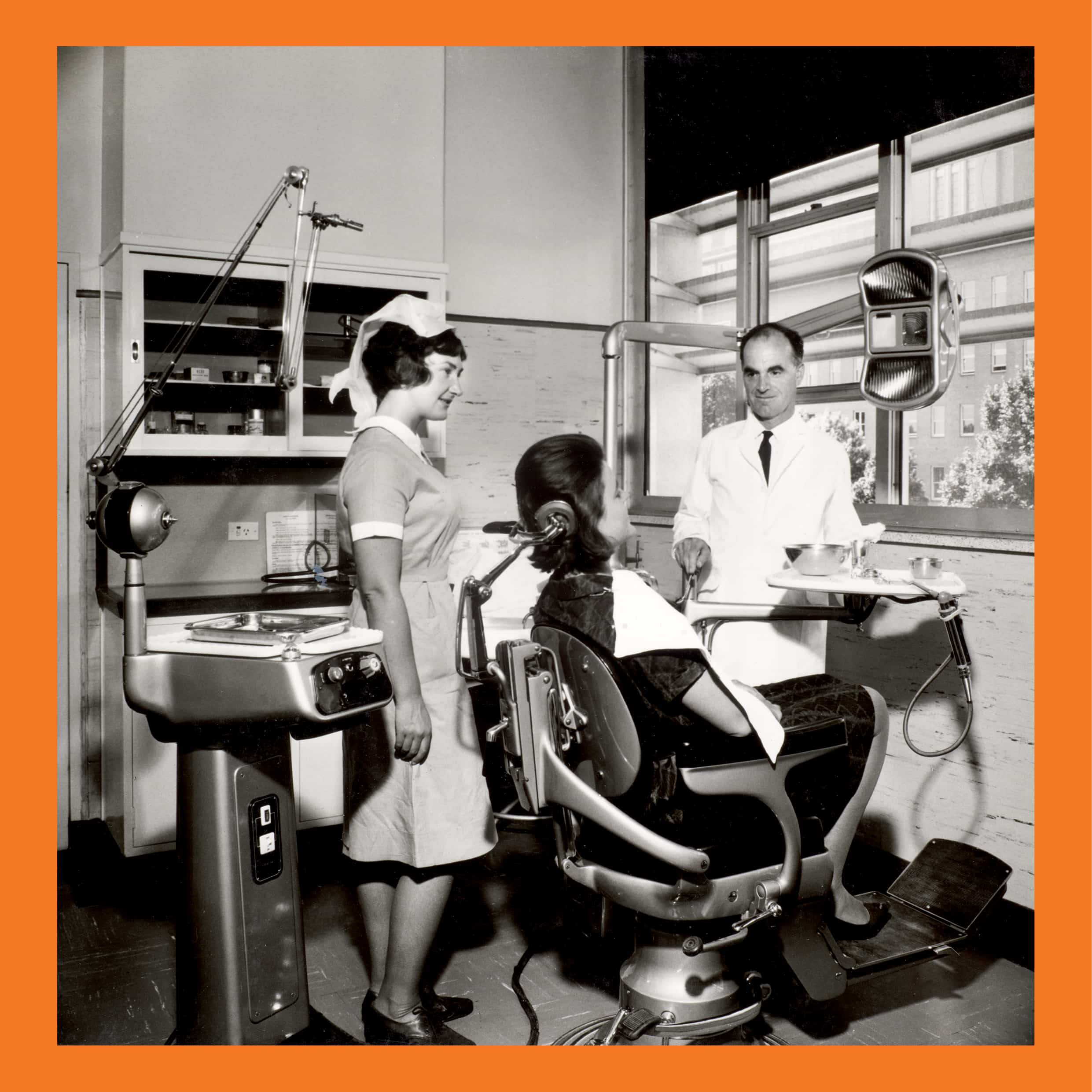
-
Endodontics—from obscurity to prominence
Asja Alma Vernieks (née Stragis, 1931–2002) was born in Liepaja, Latvia. In October 1944, as the Red Army approached, her family fled to Germany and entered a displaced persons camp. She completed her secondary education and was offered a place to study dentistry at the University of Münster. However, her family’s decision to move to Australia in 1950 obliged her to decline the opportunity. After they had settled in Melbourne, Asja worked as a nursing aide at the (Royal) Women’s Hospital. But she remained steadfast in her ambition to pursue a career in dentistry and in 1952 began studying for her Bachelor of Dental Science at the University of Melbourne.
Following her graduation in 1957, Dr Vernieks practised privately for a period, before returning to the university to work as a demonstrator. She progressed to lecturer in conservative dentistry and later became a senior lecturer in restorative dentistry. She came to specialise in endodontics (the study and treatment of the dental pulp), teaching the subject from early in her career until her retirement in 1988, and playing an important role in bringing the subject of endodontics from obscurity into prominence. In the 1970s, when the Dental Board of Victoria decided to recognise dental specialisations, Asja took on teaching endodontics at graduate level and, due to her knowledge and experience, she was registered by the Dental Board as a specialist endodontist. She obtained her Master of Dental Science in 1975.
Dr Vernieks became the first chairperson of the Dental Staff Association in the Royal Melbourne Dental Hospital in Parkville and played an active role in the hospital’s administration. She was a prominent member of the Australian Dental Association Victorian Branch, serving as a member of its council in 1983–84. In 1958 she had married Janis Vernieks and later the couple welcomed a daughter, Astrid. Asja continued to work full-time at the Dental School while raising her family. After her retirement in 1988 she moved to Yarrawonga, where she remained active in the community, including serving as president of the local community health centre before moving to be with her daughter in 2000. She died in January 2002.
Susannah Britt
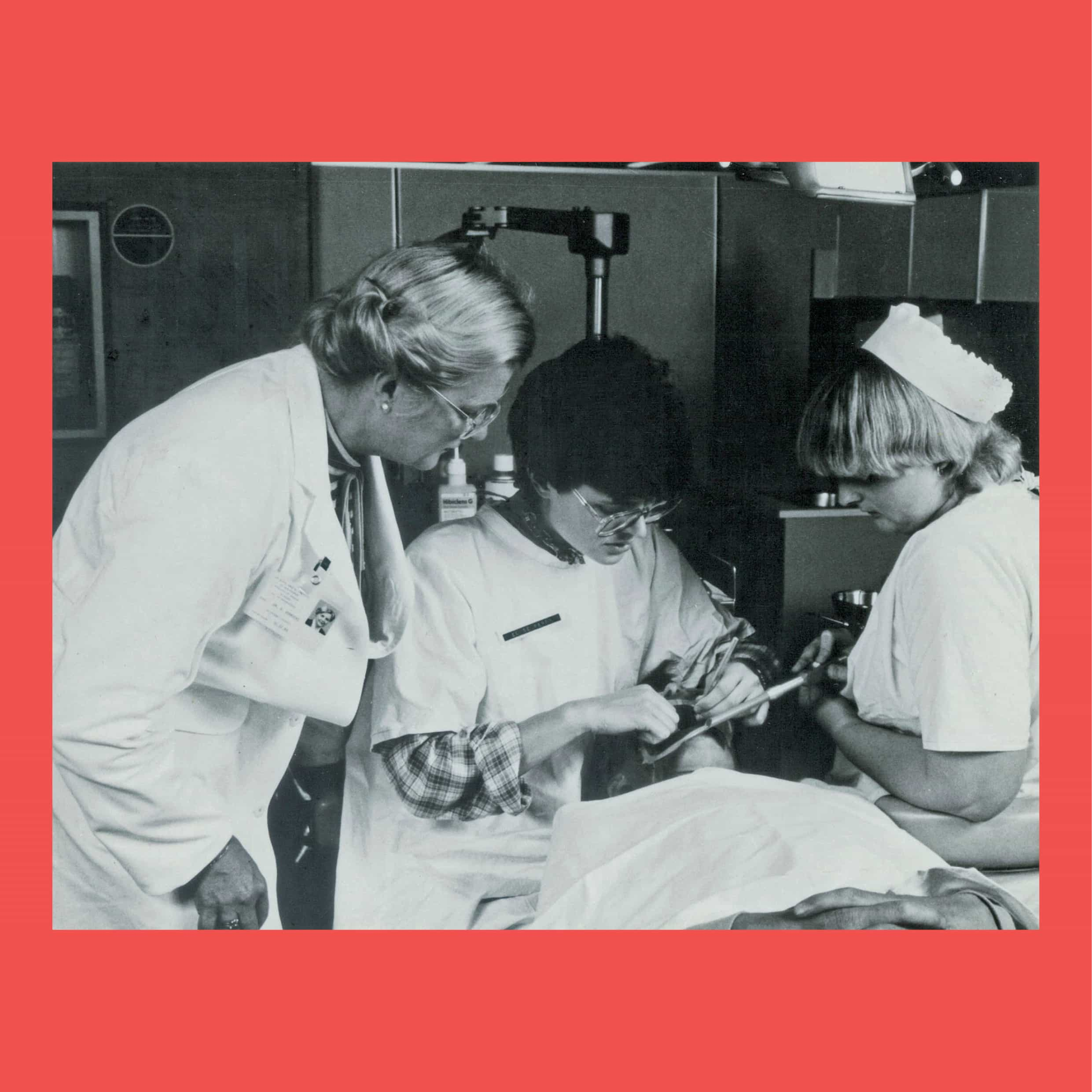
-
A youthful and dedicated innovator
Dr Geoffrey John Wylie BDSc, DDS (Toronto), FRACDS led a passionate career in dentistry, and is remembered with great affection and admiration by his former colleagues as an enthusiastic academic and an inspiring teacher to his students at the University of Melbourne. He devoted himself to conservative dentistry, making a significant contribution to the field over his career. Geoffrey was driven by excellence in his clinical work and excited by innovation; his services were widely lauded in Victoria. His zeal and commitment in advocating for good dental health were evident through his lectures and his influence as an educator.
Geoffrey died on 29 September 1979 at the young age of 40. He devoted 17 extraordinary years of his life to his practice and research in dentistry. In recognition of his outstanding contribution to the cause of dentistry and in memory of his life and work a fundraising appeal was made following his death. In 1982 the Dental Faculty recommended to the University of Melbourne council that the capital in this fund be used to build a centre for postgraduate and continuing education and audiovisual development, reflecting both Dr Wylie’s particular interests and the growing general interest in audiovisual teaching methods. This idea culminated in 1984 with the opening of the Geoffrey J. Wylie Conference Centre on the fourth floor of the East Wing of the former Royal Melbourne Dental Hospital in Elizabeth Street. In 2003, when the Melbourne Dental School moved to its current location at 720 Swanston Street, Geoffrey’s legacy continued to be recognised with the naming of the Geoffrey Wylie Lecture Theatre. The 87-seat theatre’s focus on the most advanced audiovisual teaching equipment was a fitting tribute to Geoffrey’s own interest in the use of audiovisual aids in his teaching.
Dr Simon G Wylie
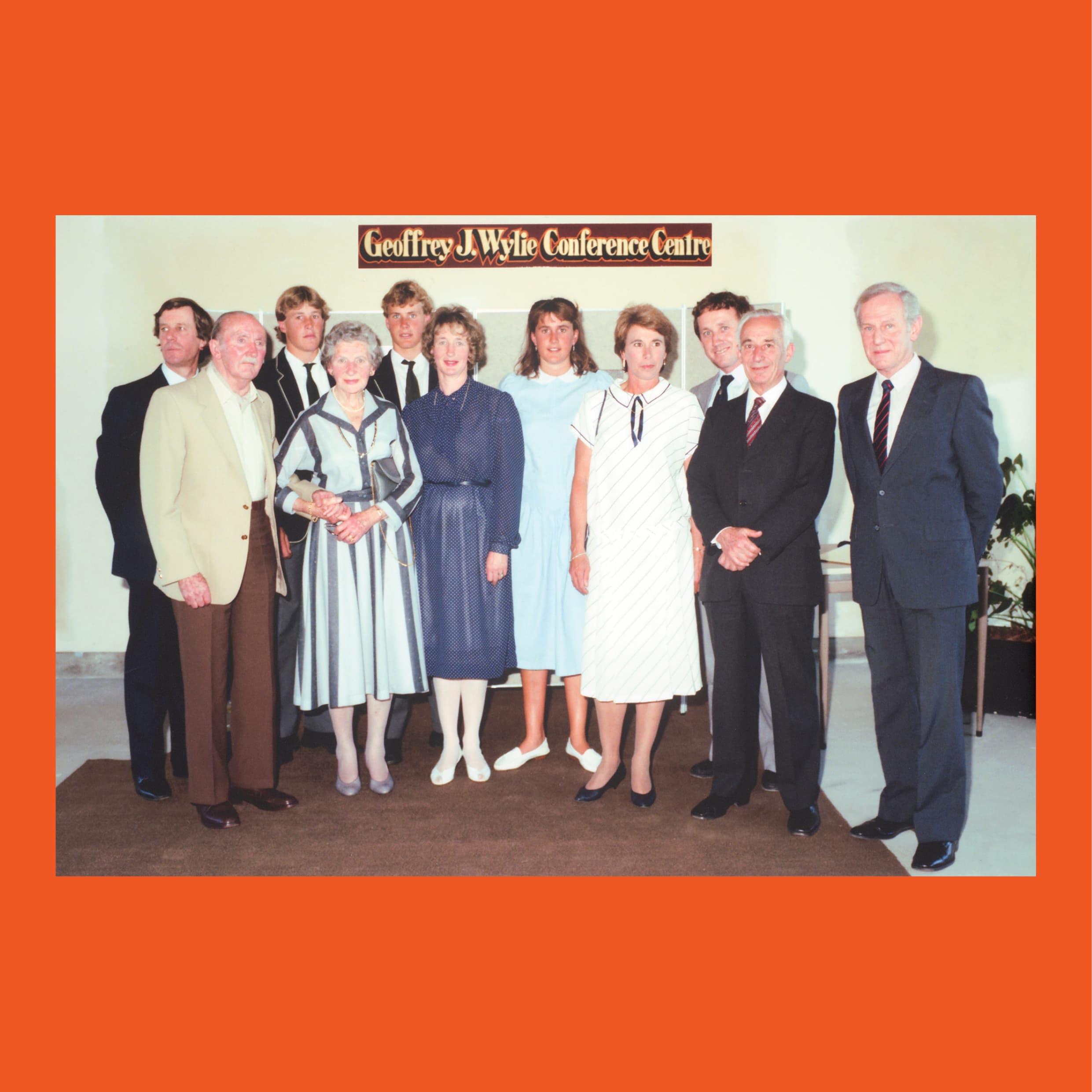
-
A solitary man and outstanding academic
Professor Emeritus Peter Clarence Reade AM, MDSc(Adel), PhD, MDsc(Melb), DDS(Hon), FDSRCS, FRCPath, FFOPRCPA, FRACDS(Hon) (1930–2009) was a solitary man who spent much of his life educating others. An outstanding academic in dentistry, he nurtured the research arm of the profession during the 1970s and 1980s, while training many of today’s leading clinicians and academics, both in Australia and abroad. He was a maxillofacial surgeon, dean of the University of Melbourne Dental School (1978–79) and head of oral maxillofacial surgery from 1968 until his retirement in 1992. He pioneered oral medicine in Australia and had more than 400 publications to his name.
Born in Adelaide into a family who were originally farmers on Queensland’s Cape York Peninsula, he attended Adelaide Technical High School, where he was an excellent sportsman and head prefect. He graduated in dentistry from the University of Adelaide in 1952, briefly entering private practice and teaching part-time in conservative dentistry. After 15 years of postgraduate training in Adelaide (PhD, 1965) and post-doctoral studies in London and Harvard, in 1968 he was invited to form a new department of dental medicine and surgery at the University of Melbourne. He built a dedicated team of high-quality academics and clinicians, and for the next 24 years oversaw a robust and expanding training program for dental undergraduate and postgraduate students, most of whom would go on to hold positions of influence in dental and medical science. In 1992 Reade retired from a full-time academic position and in 1994 he became professor emeritus and an honorary professor, and was made a Member of the Order of Australia in 1996. During his career he supervised two Doctor of Dental Science, 19 PhD, 52 Master of Dental Science and three Master of Science candidates.
Home was a small farm near Gisborne, where he grew crops and ran sheep, cattle and deer. His wife, Ene, a microbiologist, and three children were a constant support. Despite cancer in 1997 he continued to work and function against adversity, inspiring many. Reade truly kept his own counsel and rarely judged others openly. Although religious in his early years, he moved away from this and found inner satisfaction through helping to shape others’ professional lives.
Dr Ross J Bastiaan AM, RFD
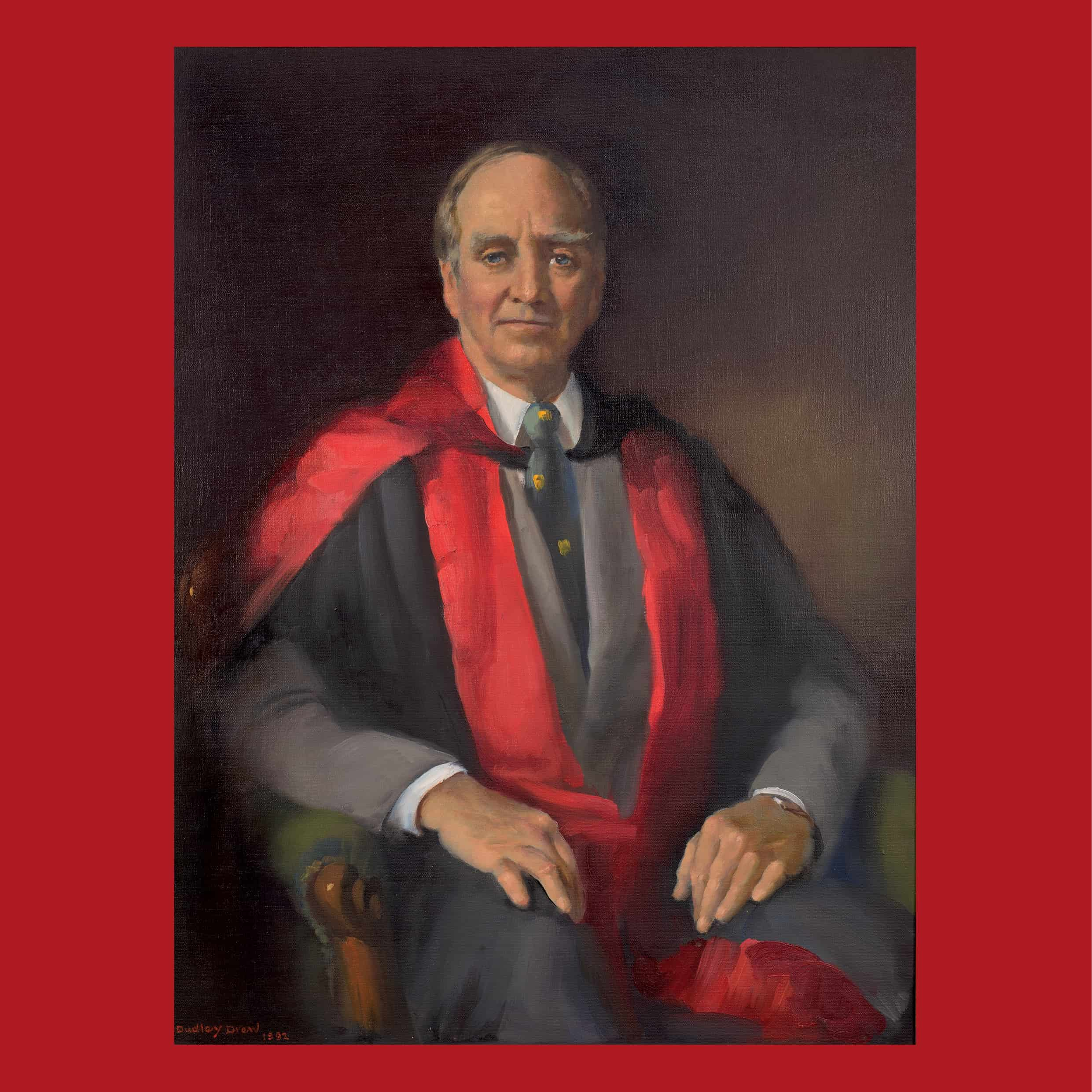
-
Endodontics leader and educator
Professor Emeritus Harold Messer (b. 1942) earned his BDSc (graduating with first-class honours and receiving the University Medal) and MDSc at the University of Queensland (1961–67), before heading to the University of Minnesota, where he completed his PhD (1968–72) and Certificate in Endodontics (1981–83). He became chairman of endodontics (the study and treatment of diseases of the dental pulp and surrounding tissues) at Minnesota (1985–89), responsible for the department’s academic and clinical activities, including undergraduate and postgraduate programs, and representing the department on the Council of Administration. In 1988 he also became acting chairman of the Department of Restorative Sciences at Minnesota, formed as part of a school-wide reorganisation and taking in endodontics, operative dentistry, prosthodontics, dental anatomy and implantology, with 28 full-time and more than 100 part-time academic staff.
In 1990 Harold returned to Australia to become professor of restorative dentistry at the University of Melbourne. He was also head of restorative dentistry until 2003, and head of endodontics until 2005. He served as deputy head of school and director of graduate studies, with responsibility for administration of all postgraduate programs in the School of Dental Science (Graduate Diploma, MDSc and PhD), and as head of school 1997–98.
Harold Messer was an internationally renowned researcher in the discipline of endodontics, and his name is synonymous with Australian endodontics. In 1990 he became the University of Melbourne’s second convenor of endodontics after Dr Asja Vernieks’ retirement, from which time Harold led the continued expansion and growth of the postgraduate endodontic program, giving it a reputation for excellence both nationally and internationally. Over his career Harold published more than 200 peer-reviewed papers, including eight textbook chapters. He also supervised 39 MDSc and Doctor of Clinical Dentistry students (13 international and 26 local) and 15 PhD students. He had a strong interest in international education, particularly the training of academics who would return to teaching positions in their own countries. More than 30 of his graduates are, or have been, in full-time teaching positions in 11 countries, including one university vice-president, a dean, and several department heads.
Professor Peter Parashos
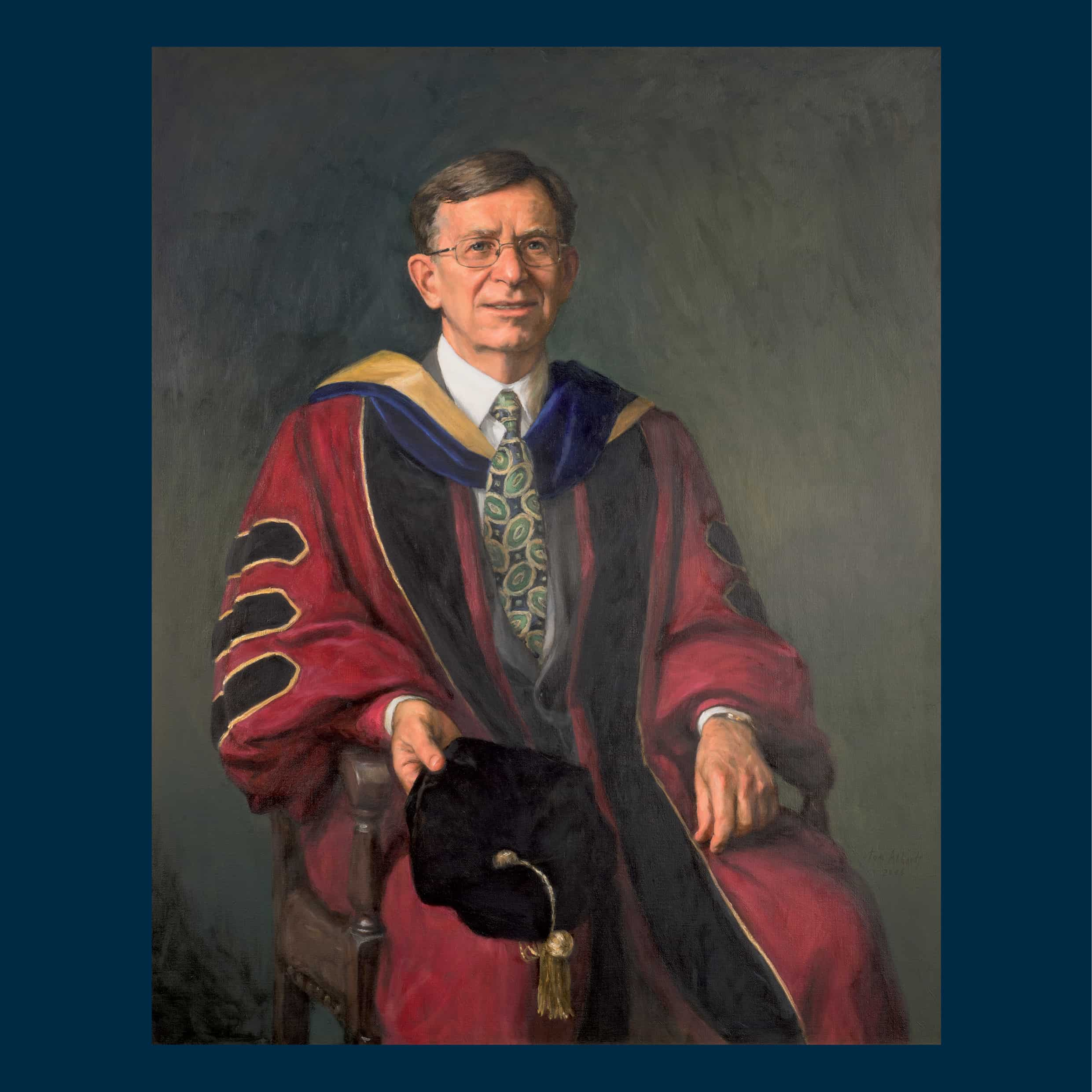
-
A leader in public health
Clive Wright (b. 1944) graduated with a Bachelor of Dental Science degree from the University of Otago, where he also completed a Master of Dental Science and PhD. Between 1989 and 1997 he was professor of preventive and community dentistry, as well as dean/head of the School of Dental Science at the University of Melbourne. During his tenure, Professor Wright led or was involved in several major reviews of dental services in Australia and in the establishment of the Australian Dental Council, the organisation responsible for accreditation of dental programs offered in higher educational institutions across Australia. He was also responsible for the introduction of dental therapy and then dental hygiene into the University of Melbourne academic programs in the School of Dental Science.
In 2006 and 2009 Clive was a visiting professor in oral health at the Graduate School, Tokyo Medical and Dental University, where he pursued research into the relationship between oral health and general health in older persons, and also taught postgraduate students in dental public health and population oral health. Currently he holds the position of associate director (oral health) and clinical professor at the Centre for Education and Research on Ageing at the University of Melbourne.
In 2015 Professor Emeritus FA Clive Wright was made a Member of the Order of Australia for his services to population oral health.
Professor Mike Morgan
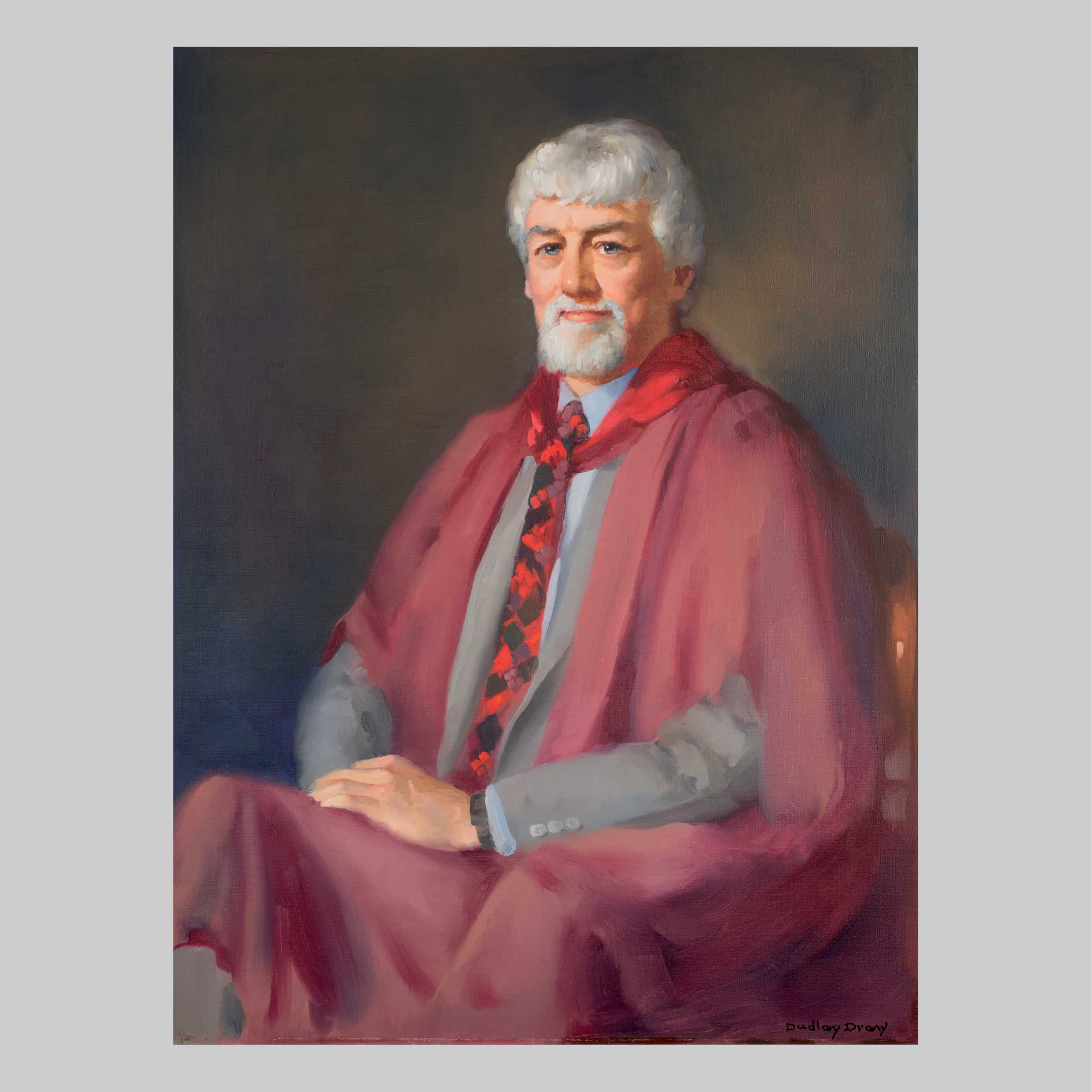
-
Granting dignity to the dead
Professor John Clement (1948–2018) held the inaugural chair in forensic odontology at the University of Melbourne and was deputy head of the Melbourne Dental School. He joined the university from Britain in 1989 and was soon appointed head consultant forensic odontologist to the Victorian Institute of Forensic Medicine (VIFM). His expertise involved inferring a person’s history by examining their skeletal remains. Over his long career John’s work was crucial for the families of victims, and for legal redress. Through VIFM he worked closely with the Coroner’s Court of Victoria and was in the disaster victim identification teams that responded to the 2001 Bali bombings and 2005 Boxing Day tsunami in Thailand. He worked in the mortuary after the Black Saturday bushfires that devastated Victoria in 2009 and served on expert advisory panels dealing with the identification of missing persons and human remains following conflict and civil strife. These are just the most high profile examples of John’s expertise in forensic odontology being called upon around the world.
In his work at the University of Melbourne, John was a gifted researcher, teacher and mentor. He frequently published in important international scientific journals, and founded the Melbourne Femur Collection, used by researchers worldwide in fields ranging from medical science to anthropology. He helped develop his students’ technical expertise while instilling in them an understanding of the need for compassion and sensitivity as they pursued careers in forensics, dentistry and research. This care and mentoring extended to his Melbourne Dental School associates, who are deeply saddened by the loss of their friend and colleague.
John was a trusted deputy head of school, providing a gentle voice of reason and reassurance. He blessed us all with his brilliance, thoughtfulness, loyalty and humour. Many of us shared his love of motorbikes, of vintage cars and of the Australian bush. We relished the shared activities and conversations, which were often sprinkled with stories of John’s multi-hued life experiences.
On so many occasions we heard from John how important in his life was his family: his wife Pauline and their children, Hannah, William and Alice.
Professor Mike Morgan
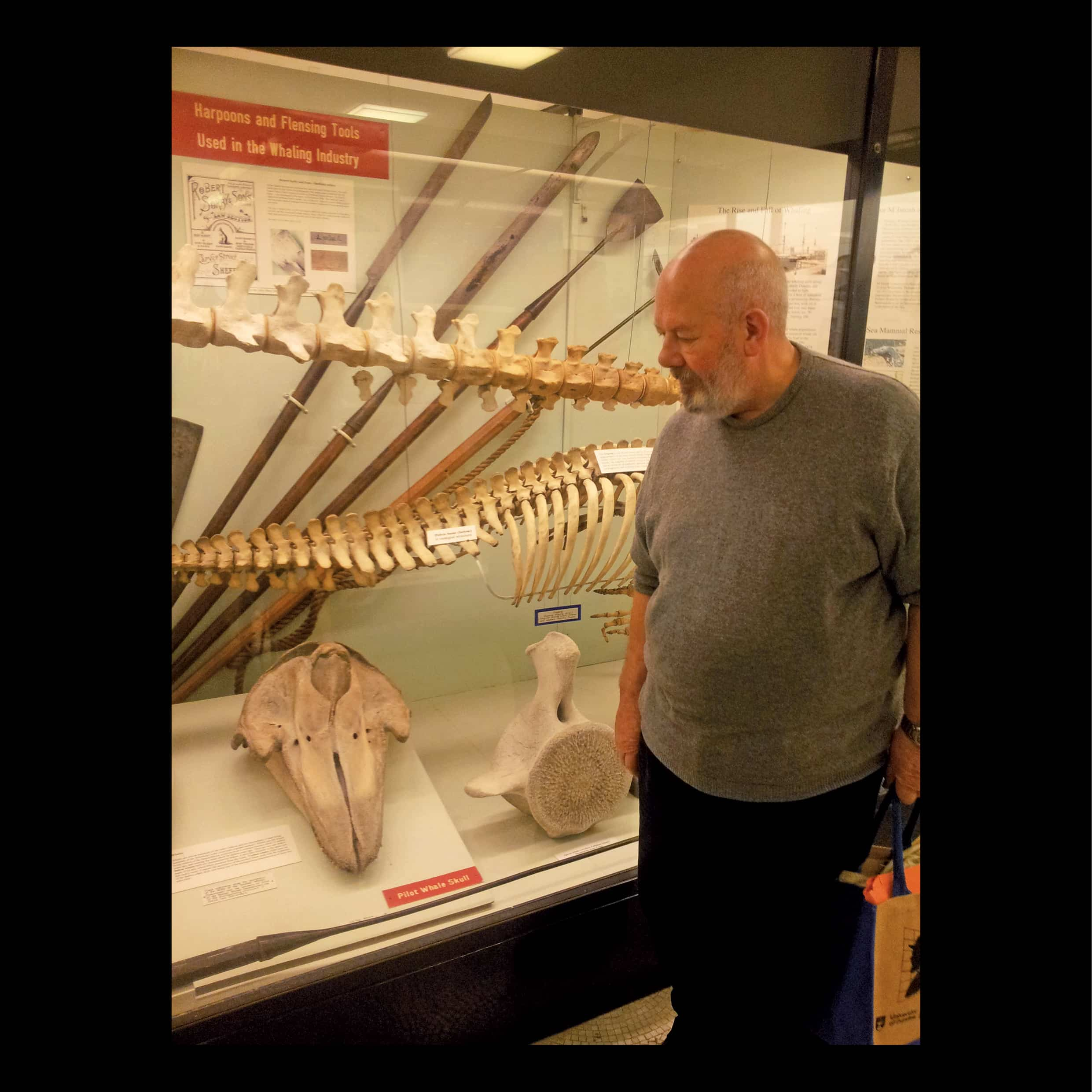
-
Leader in population oral health
Mike Morgan graduated in dentistry from the University of Otago, New Zealand, in 1979. He completed his MDSc in children’s and preventive dentistry at the University of Melbourne in 1985 before taking up an academic position in dental public health at the University of Hong Kong. After returning to Melbourne in 1988, Mike completed a Graduate Diploma in Epidemiology in 1992, and a PhD in 1996, studying the benefits of water fluoridation and the use of occlusal dental sealants in a rural population of Australian children. He went on to lead the academic team in community dentistry and population oral health at the Melbourne Dental School, eventually becoming chair of population oral health from 2006 and head of school from 2015 to 2019.
Mike has made a significant contribution to the science of population oral health, and in community advocacy for minimal-intervention strategies in dentistry and the prevention of oral diseases. He was a strong leader in the Melbourne Dental School, the dental profession and the Australian Dental Council for many years.
Mike developed fruitful international education and research connections, especially in South East Asia. His particular research interests include clinical trial of dental caries preventive agents, health informatics, and the economics of caries preventive programs. In 2020 he returned to New Zealand to take up the role of dean of the Faculty of Dentistry at the University of Otago.
Professor Emeritus FA Clive Wright AM
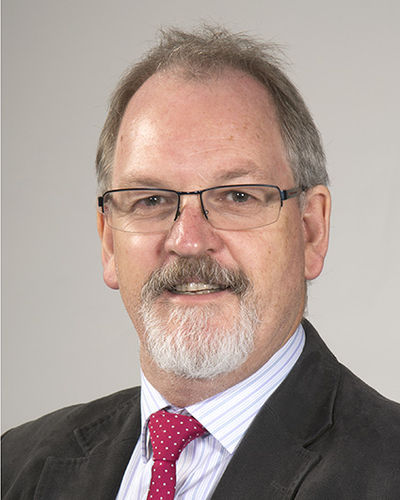
-
Outreach and Community Care -Children
In 1921 the forward-looking New Zealand Dental Association proposed a system of state-operated school clinics staffed by dental nurses, to serve children aged six to 14. Trained in schools by the Health Department, these nurses worked in both mobile and school-based clinics. They provided diagnostic, preventive and treatment services, and referred more complex cases to local dentists. This system met with considerable success and was the subject of inquiry by many other countries, including Australia.
In response to concerns expressed by the medical professions, school teachers and mothers’ clubs, in 1921 the Victorian Education Department established a School Dental Service. Surgeries set up in train carriages and deployed along the rail network provided intermittent services to lower-income children in rural areas. But the service was chronically underfunded and unable to meet demand. Many times from the 1920s to 1960s proposals to establish a New Zealand–style service were considered and rejected.
Tasmania and South Australia established schools to train dental therapists for state programs in 1966 and 1967 respectively. Federally, when Gough Whitlam’s Labor government offered funding to expand the School Dental Scheme in 1973, Victoria established a program and dental therapy school in 1975. In 1975–76 Australian women were sent to New Zealand to train as dental therapists, returning to establish the first clinics. These early school dental clinics and mobile services (caravans containing two dental chairs with portable equipment, to reach small schools) were deployed initially in areas with the highest need, gradually spreading across the state. By 1991 some 290 dental therapists were providing examinations, diagnoses, treatment, prevention and education to more than 250,000 youngsters—approximately 67 per cent of Victoria’s school children. In the 1980s–90s, the Victorian government also funded pre-school dental programs, delivered by local government in conjunction with their maternal and child health programs. Again, funding and reach were insufficient, so in 1993 the City of Monash piloted a preventive program in pre-school and childcare settings for the under-fives. This developed into the Smiles For Miles program, now spread across Victoria.
Professor Julie Satur and Associate Professor Rachel Martin
Attachment Size Satur+Martin.pdf
120 KB 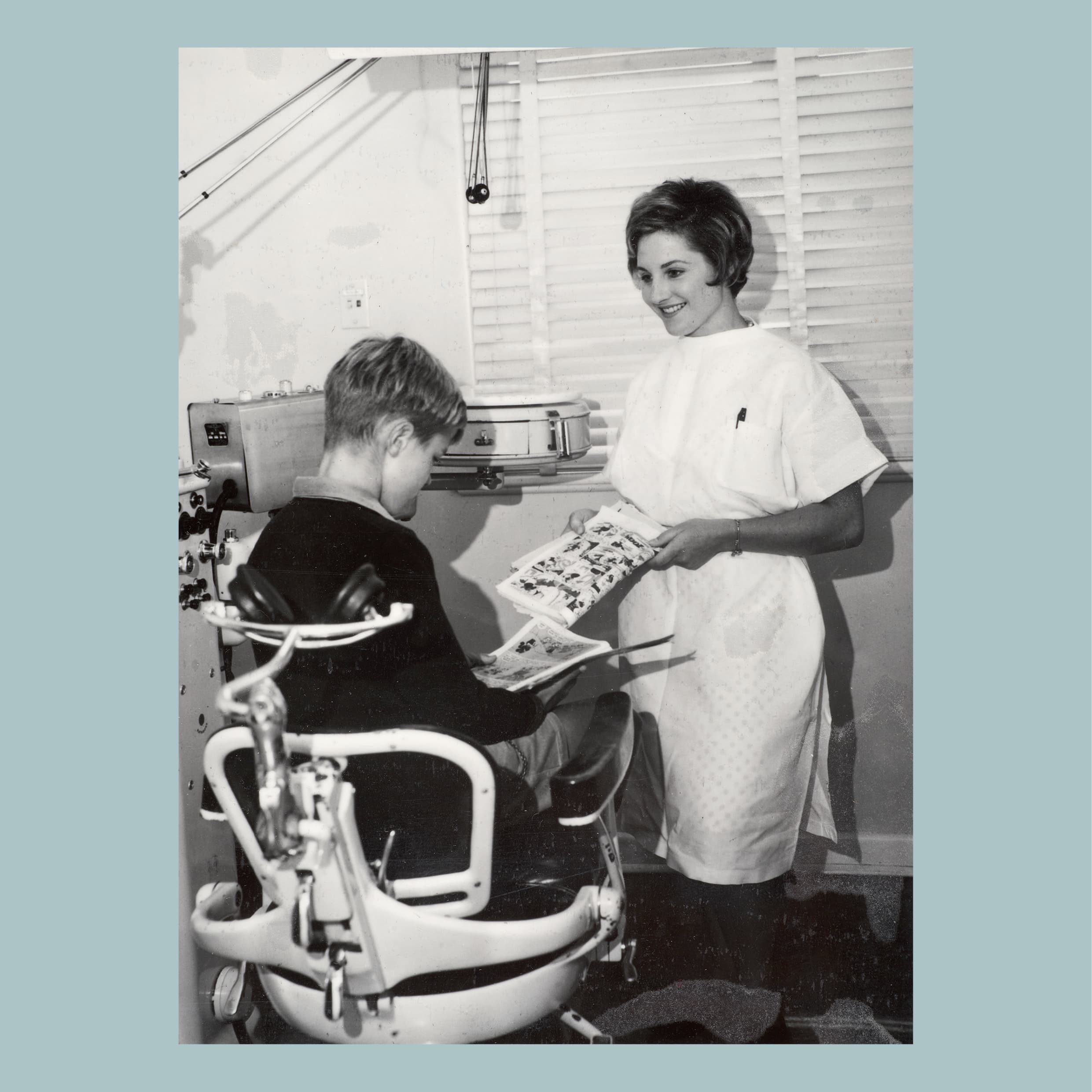
-
Fluoridation of water supply: A personal reflection
The riveting story of the fluoridation of domestic water supplies was told in a substantial volume published by the United States Public Health Service in 1962.1 When this book appeared I had embarked on a master’s degree under the guidance of Professor Elsdon Storey at the University of Melbourne. The book described the pioneering research of American scientists H Trendley Dean, Francis Arnold and others, from the 1930s to the 1950s. Their studies brilliantly demonstrated the beneficial effects of fluoride in drinking water at 1 ppm (one part per million), as distinct from the mottling of dental enamel (fluorosis) that occurred at higher concentrations.
Initially, Dean and colleagues sought to identify the cause of often severe mottling, and found that it was fluoride naturally occurring in some domestic supplies. But they also noticed that teeth affected in this way were free of caries. This started a search for other communities with gradually lower concentrations of fluoride in their drinking water supplies, to see if the beneficial effect—the remarkable reduction of caries—could still be achieved, but without the mottling. After exhaustive trials, they hit the jackpot: one part per million led to good-looking teeth and resistance to caries. What’s more, the researchers established that when the water at Grand Rapids (in Michigan, USA) was artificially fluoridated at 1 ppm, the beneficial effect was similar to that in places where the water contained the optimum concentration naturally.
To me, this was a gift from heaven. I was running a busy private dental practice, struggling to deal with rampant tooth decay, particularly in children. Their teeth were hopelessly vulnerable; the traditional techniques of fighting caries were not working.
Professor Storey and I decided to mount a campaign for legislation that would enable authorities to adjust the level of fluoride in Victoria’s major water supplies to 1 ppm. It became a political objective to win. The Australian Dental Association (ADA) financed my travel to many a public hall around the state to advocate to this end. Our opponents were vocal in a most aggressive manner, and on a number of occasions I had to be escorted from the venues.
The key to our success was to achieve solid public support, by means such as letters to the editors of major and regional newspapers. We also had the advantage of total support from ADA members, who were in a very good position to influence their patients. I was active in the state branch of the Australian Labor Party and its support was forthcoming. Now we had to gain support from the other side of politics: the Liberal Party. We needed to neutralise the arguments of the opponents, many of which were fallacious. How to make sure the facts got through to the politicians? We did this by supporting a royal commission under Justice Crisp in Tasmania. We put our case, and some prominent academic opponents put theirs. The result supported fluoridation. This finding won over a number of Liberal politicians, including the premier of Victoria, Dick Hamer.
We finally achieved the support we needed in an unorthodox way. At a press conference, we asked: ‘Who are the faceless men in the Liberal Party stopping fluoridation?’ ‘Faceless men’ was a slogan then in use by the federal Liberals against Gough Whitlam and the Australian Labor Party. Also, we ran an advertisement in the media showing a map of Victoria with the words: ‘Our children’s teeth are in a bad state’.
We achieved the necessary numbers in the Victorian Parliament, and the Health (Fluoridation) Act, which regulates the safe and effective addition of fluoride to drinking water in our state, was passed in 1973, leading to the introduction of water fluoridation in Melbourne in 1977.
Dr Gavan Oakley AM
1. FJ McClure (ed.), Fluoride drinking waters: A selection of Public Health Service papers on dental fluorosis and dental caries, physiological effects, analysis and chemistry of fluoride, Bethesda, Maryland: United States Public Health Service, 1962.
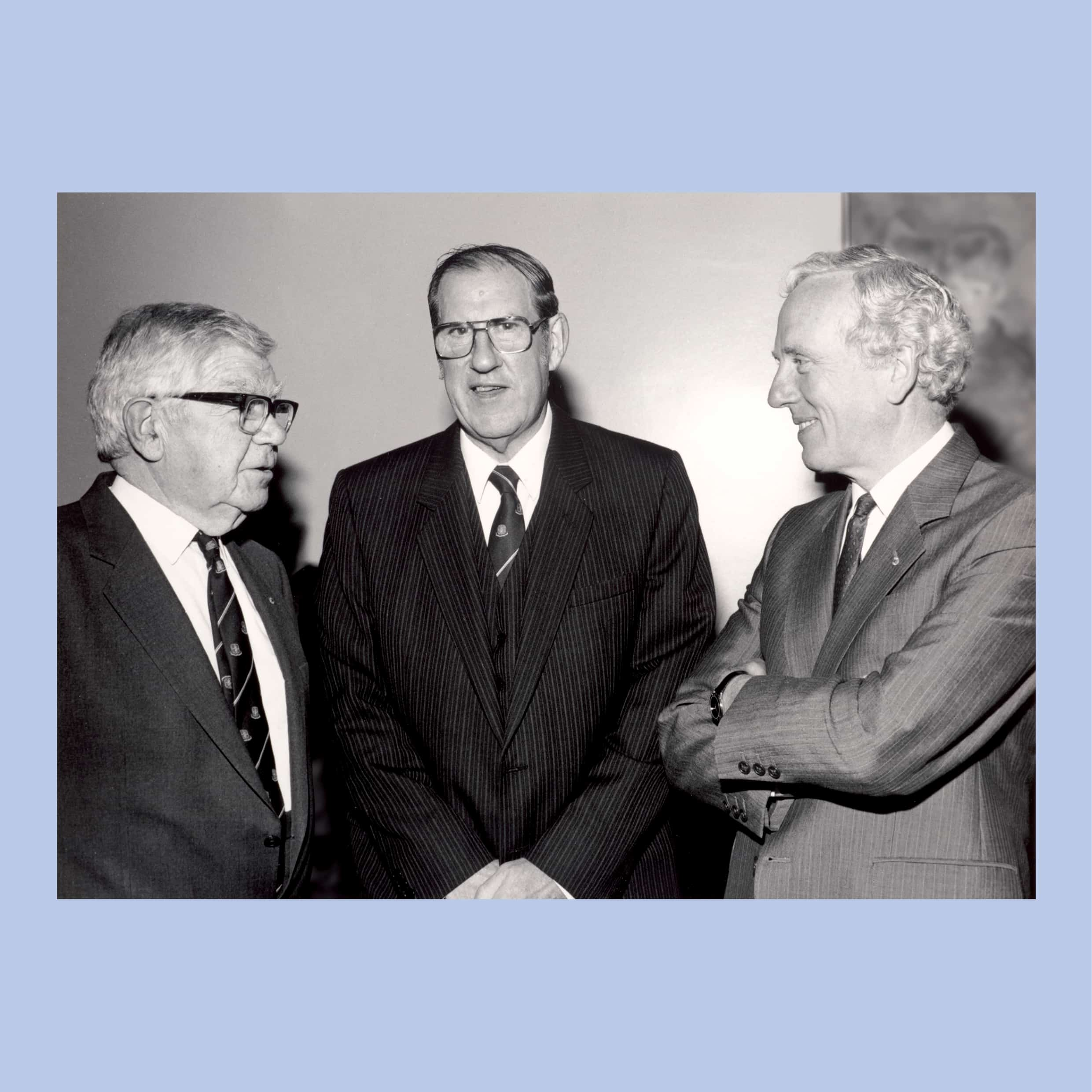
-
Water fluoridation
Although fluoridation of community water supplies has previously been a contentious issue in Victoria, strong evidence of its efficacy to safely prevent decay, combined with bipartisan political support, has led to its extension to 90 per cent of the state’s population.1
Fluorides are naturally occurring compounds found in plants and rocks. They are also found at very low levels in almost all fresh water. Community water fluoridation is the controlled addition of a fluoride compound to a public water supply in order to bring the fluoride concentration up to a level (one part per million) that prevents tooth decay without causing any ill effects. Some water supplies in Victoria have naturally occurring fluoride at this prevention level. Universal access to fluoride for caries prevention has been recognised by the World Health Organization as part of the basic right to human health.2 The Australian National Health and Medical Research Council (NHMRC) ‘strongly recommends community water fluoridation as a safe, effective and ethical way to help reduce tooth decay across the population’.3
The first town in Victoria to be fluoridated was Bacchus Marsh (about 50 kilometres north-west of Melbourne), in 1962. The city and suburbs of Melbourne followed in 1977. Water supplies in rural Victoria have been progressively fluoridated since that time, particularly through a focused and well-funded government program between 2004 and 2010, which led to more than 700,000 additional Victorians benefiting from a fluoridated water supply.4
Dr John Rogers
Attachment Size John Rogers.pdf
127 KB 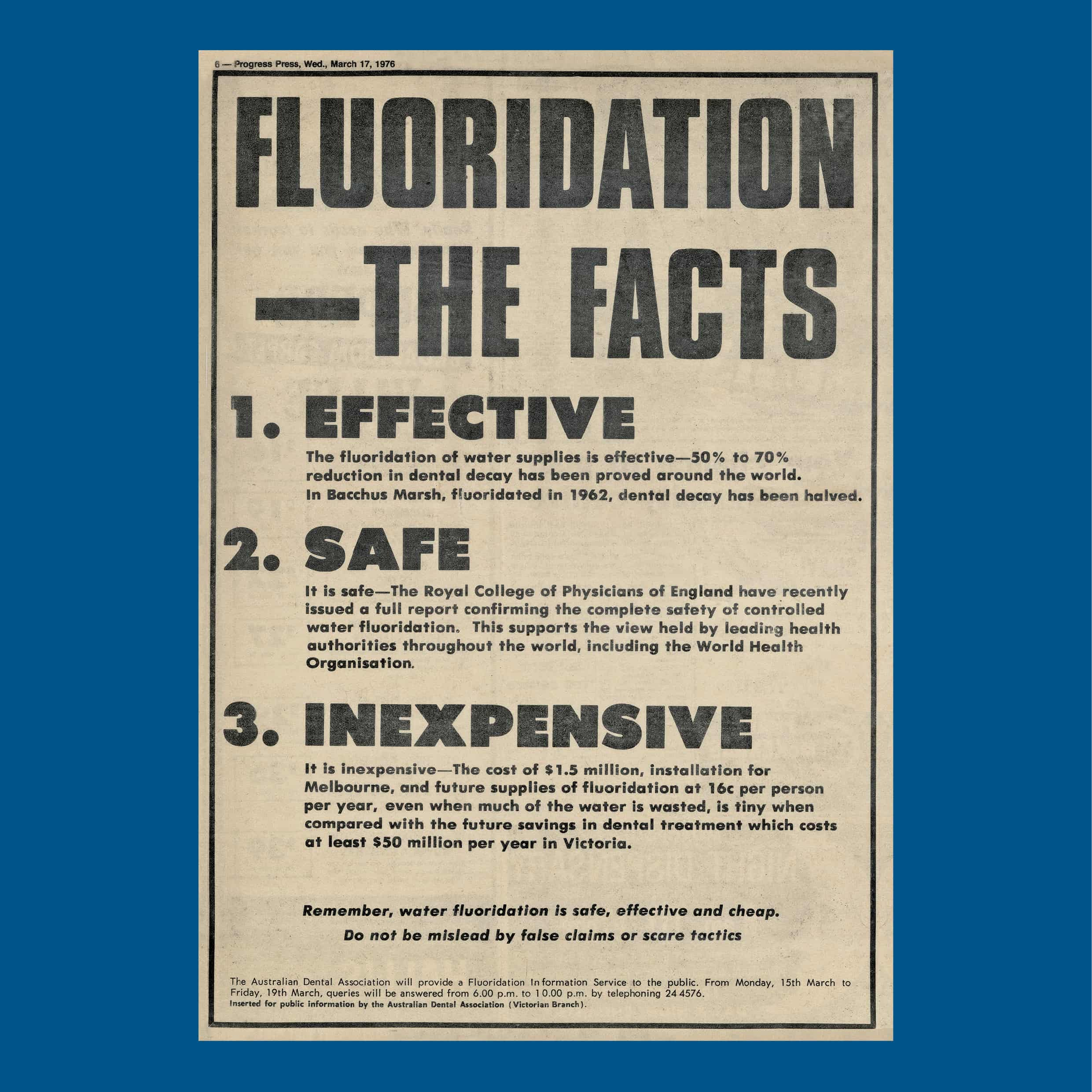
-
Oral microbiology research in Victoria
The original collaborations between the departments of Conservative Dentistry (now Oral Biology) and Dental Medicine and Surgery (now Oral Anatomy, Medicine and Surgery) have been continued with the discovery of the roles of viruses, fungi and bacteria in oral cancer. This is resulting in breakthrough research on causes of cancer and the development of predictive biomarkers.
A characteristic of the rich and varied body of research on oral microbiology at the University of Melbourne is the unwavering focus on preventing oral disease. The unravelling of the molecular mechanisms behind the ways in which oral micro-organisms cause the two most common oral diseases (dental caries and periodontal disease), and the search for ways to decrease their numbers in dental plaque and mitigate their damage to humans—both in the oral cavity and beyond—continues with a new generation of researchers, supported by ever-advancing technology.
Dr Samantha Byrne, Professor Michael McCullough and Professor Stuart Dashper
Attachment Size Byrne+McCullough+Dashper.pdf
148 KB 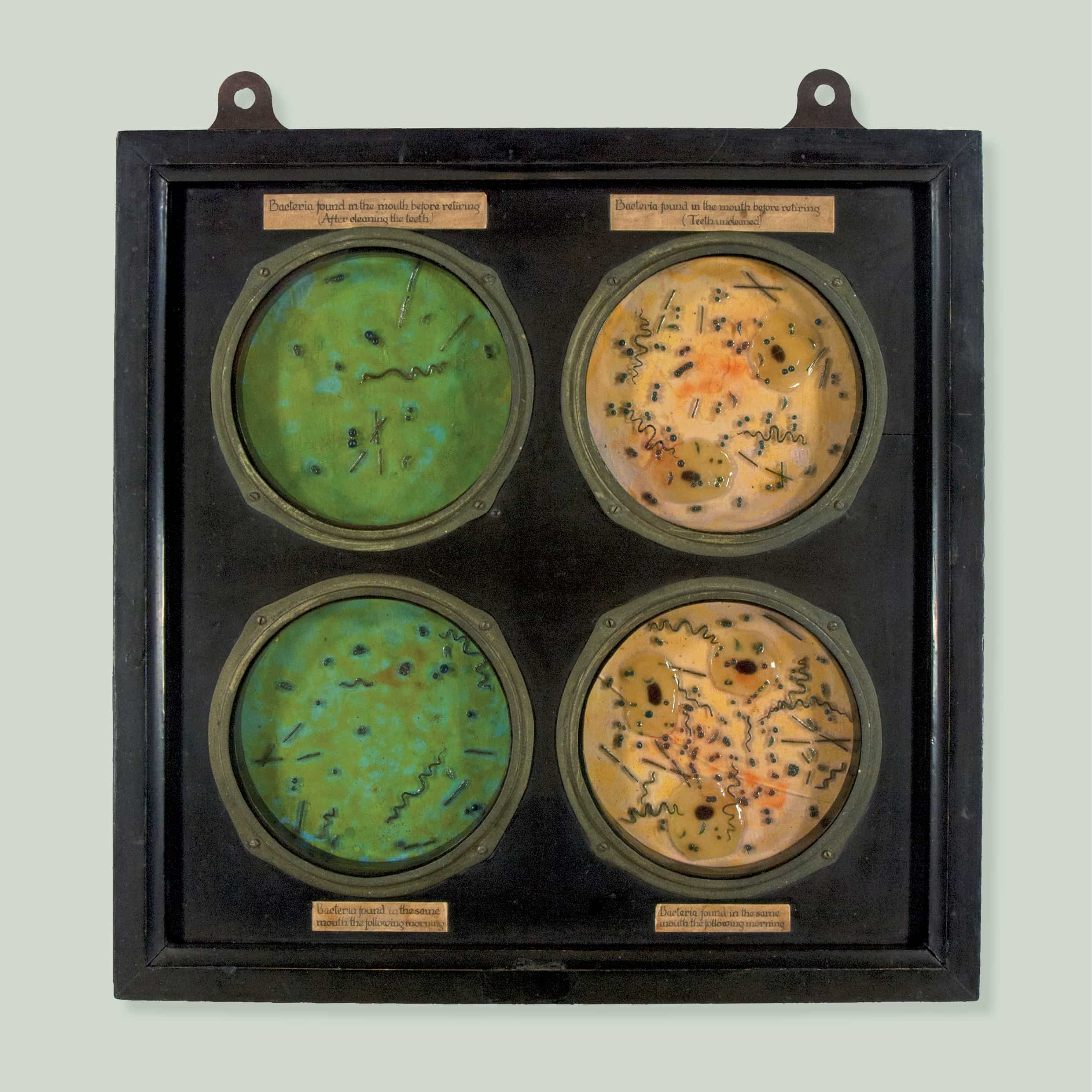
-
A force for discovery
Laureate Professor Eric Reynolds AO, BSc, PhD has been at the forefront of dental innovation for more than three decades. Currently chief executive officer of the Oral Health Cooperative Research Centre (a consortium of Australian universities, government bodies and private industry), he was head of the Melbourne Dental School for 16 years, starting in 1998, and continues to be a leading researcher in dental science at the university.
Born and raised in Melbourne, Eric excelled as a young student, earning a scholarship for his secondary education, during which he developed a passion for science. He was accepted into the University of Melbourne, graduating with a BSc in 1973. His zeal for research led him to take up a position with the University of Melbourne’s Department of Preventive and Community Dentistry in 1978, the year in which he obtained his PhD.
As a young researcher in the 1980s, he turned his focus to the problem of tooth decay. Buoyed by anecdotal and epidemiological evidence that dairy products may reduce the risk of tooth decay, Eric and his team of researchers began experimenting with milk and cheese. They isolated the properties of a naturally occurring protein known as CPP-ACP (casein phosphopeptide-amorphous calcium phosphate), found in cows’ milk, which they found could strengthen and re-mineralise tooth enamel affected by plaque. The discovery was patented and marketed as Recaldent™ chewing gum, and is also used in GC Tooth Mousse™. Currently Eric is leading a team developing a world-first vaccine for the highly prevalent gum disease chronic periodontitis.
In 2005 Professor Reynolds was made an Officer of the Order of Australia for his contribution to innovation in dentistry and his role in furthering dental education in Australia. In 2017, in recognition of his scientific discoveries and research, he received the Prime Minister’s Prize for Innovation. He was instrumental in securing funding for the new Royal Dental Hospital of Melbourne in Carlton. He has written more than 172 peer-reviewed publications, taken out 19 patents, and supervised more than 50 undergraduate and postgraduate research students. He continues to be an active member of the dental professional community and a relentless force for innovation in the field.
Professor James McCluskey AO
Brush your teeth—it could save your life! Laureate Professor Eric Reynolds AO
Attachment Size Eric-Reynolds.pdf
87.1 KB 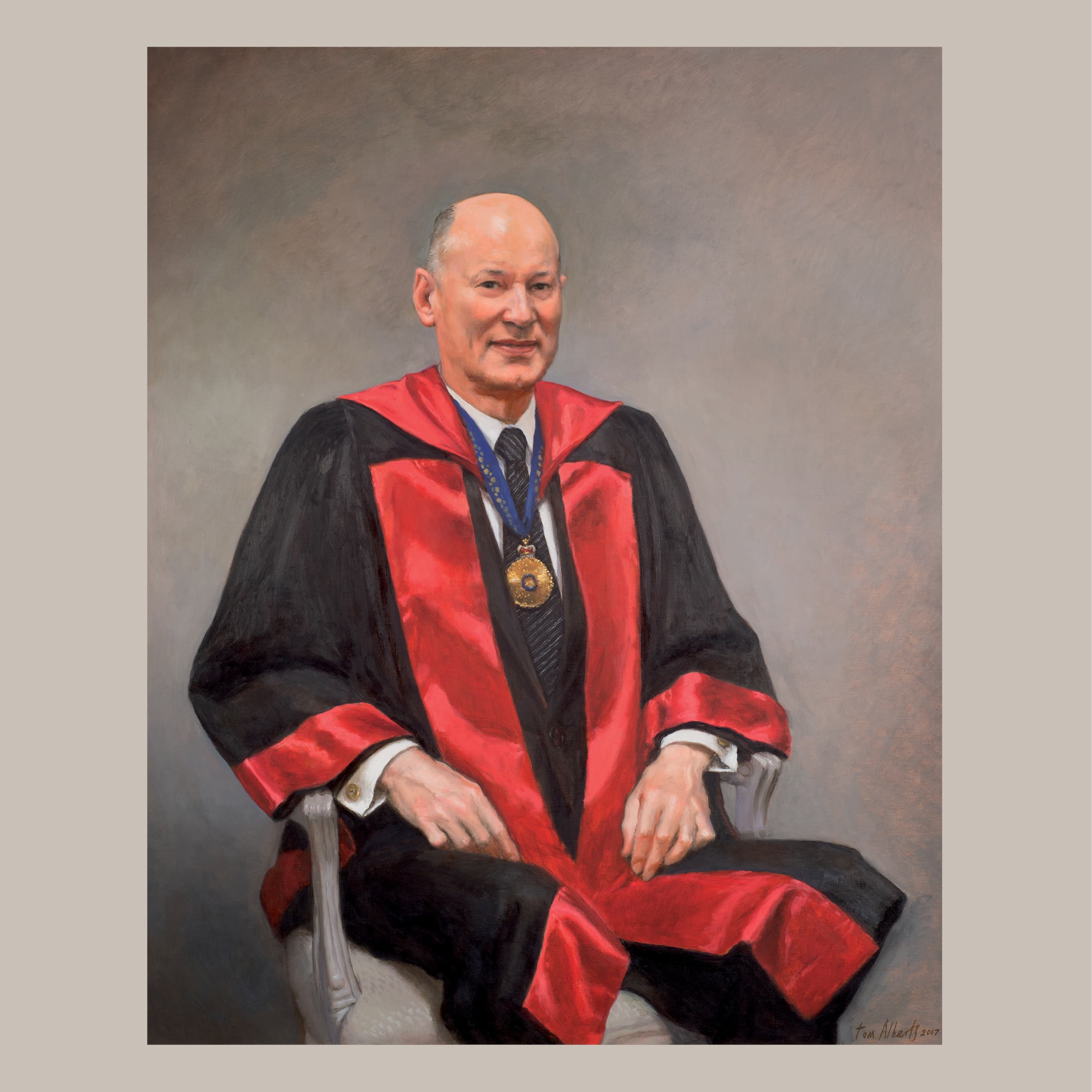
-
Richard I Woodman England (1784–1859)
Richard I Woodman England (1784–1859) The idle and luxuriant student attended at his apartment in the college by his sempstress. From The Idler 1798 stipple engraving on paper Baillieu Library Print Collection, The University of Melbourne Gift of Dr J Orde Poynton 1959 1959.5536.000.000
